নিচে অ্যান্ড্রয়েড স্টুডিও ৩.৬ এবং তার নিচের সংস্করণ এবং অ্যান্ড্রয়েড গ্রেডল প্লাগইন ৩.৬.০ এবং তার নিচের সংস্করণের রিলিজ নোট দেওয়া হল।
অ্যান্ড্রয়েড স্টুডিওর পুরোনো সংস্করণগুলি
৩.৬ (ফেব্রুয়ারী ২০২০)
অ্যান্ড্রয়েড স্টুডিও ৩.৬ একটি প্রধান রিলিজ যাতে বিভিন্ন ধরণের নতুন বৈশিষ্ট্য এবং উন্নতি অন্তর্ভুক্ত রয়েছে।
আমরা আমাদের সকল সম্প্রদায়ের অবদানকারীদেরও ধন্যবাদ জানাতে চাই যারা এই প্রকাশে সহায়তা করেছেন।
৩.৬.৩ (এপ্রিল ২০২০)
এই ছোটখাটো আপডেটে বিভিন্ন বাগ সংশোধন করা হয়েছে। উল্লেখযোগ্য বাগ সংশোধনের তালিকা দেখতে, রিলিজ আপডেট ব্লগে সম্পর্কিত পোস্টটি পড়ুন।
৩.৬.২ (মার্চ ২০২০)
এই ছোটখাটো আপডেটে বিভিন্ন বাগ সংশোধন করা হয়েছে। উল্লেখযোগ্য বাগ সংশোধনের তালিকা দেখতে, রিলিজ আপডেট ব্লগে সম্পর্কিত পোস্টটি পড়ুন।
৩.৬.১ (ফেব্রুয়ারী ২০২০)
এই ছোটখাটো আপডেটে বিভিন্ন বাগ সংশোধন করা হয়েছে। উল্লেখযোগ্য বাগ সংশোধনের তালিকা দেখতে, রিলিজ আপডেট ব্লগে সম্পর্কিত পোস্টটি পড়ুন।
ডিজাইন টুল
অ্যান্ড্রয়েড স্টুডিওর এই সংস্করণে লেআউট এডিটর এবং রিসোর্স ম্যানেজার সহ বেশ কয়েকটি ডিজাইন টুলের আপডেট অন্তর্ভুক্ত রয়েছে।
স্প্লিট ভিউ এবং জুম ইন ডিজাইন এডিটর
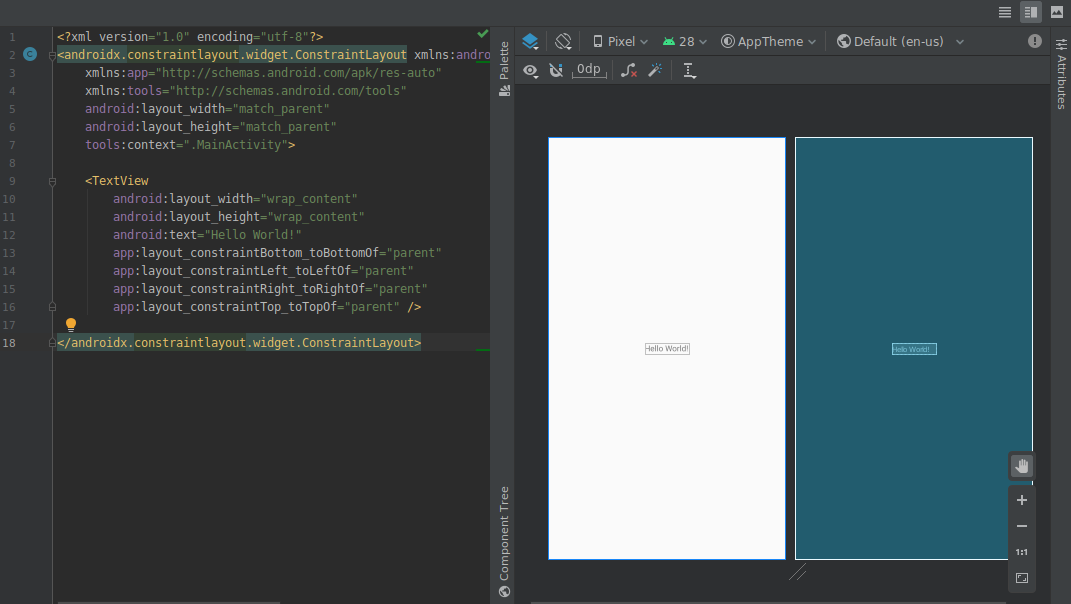
এই রিলিজে ভিজ্যুয়াল ডিজাইন এডিটরের নিম্নলিখিত আপডেটগুলি অন্তর্ভুক্ত করা হয়েছে:
ডিজাইন এডিটর, যেমন লেআউট এডিটর এবং নেভিগেশন এডিটর, এখন একটি স্প্লিট ভিউ প্রদান করে যা আপনাকে একই সাথে আপনার UI এর ডিজাইন এবং কোড ভিউ উভয়ই দেখতে সক্ষম করে। এডিটর উইন্ডোর উপরের ডানদিকে, এখন তিনটি বোতাম রয়েছে।
 দেখার বিকল্পগুলির মধ্যে টগল করার জন্য:
দেখার বিকল্পগুলির মধ্যে টগল করার জন্য:- স্প্লিট ভিউ সক্ষম করতে, স্প্লিট আইকনে ক্লিক করুন
 .
. - XML সোর্স ভিউ সক্ষম করতে, সোর্স আইকনে ক্লিক করুন।
 .
. - ডিজাইন ভিউ সক্ষম করতে, ডিজাইন আইকনে ক্লিক করুন
 .
.
- স্প্লিট ভিউ সক্ষম করতে, স্প্লিট আইকনে ক্লিক করুন
ডিজাইন এডিটরের মধ্যে জুম এবং প্যানিংয়ের নিয়ন্ত্রণগুলি এডিটর উইন্ডোর নীচের ডানদিকের কোণায় একটি ভাসমান প্যানেলে স্থানান্তরিত হয়েছে।
আরও জানতে, লেআউট এডিটর দিয়ে একটি UI তৈরি করুন দেখুন।
কালার পিকার রিসোর্স ট্যাব
আপনার XML-এ কালার পিকার বা ডিজাইন টুল ব্যবহার করার সময় আপনার অ্যাপে কালার রিসোর্স মান দ্রুত আপডেট করতে সাহায্য করার জন্য, IDE এখন আপনার জন্য কালার রিসোর্স মান পূরণ করে।
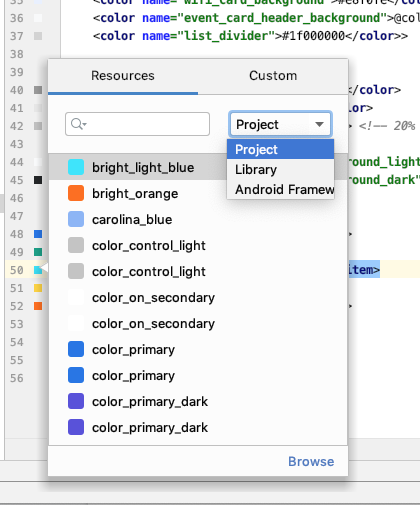
রিসোর্স ম্যানেজার
রিসোর্স ম্যানেজারে নিম্নলিখিত আপডেটগুলি রয়েছে:
- রিসোর্স ম্যানেজার এখন বেশিরভাগ রিসোর্স প্রকারকে সমর্থন করে।
- কোনও রিসোর্স অনুসন্ধান করার সময়, রিসোর্স ম্যানেজার এখন সমস্ত প্রকল্প মডিউল থেকে ফলাফল প্রদর্শন করে। পূর্বে, অনুসন্ধানগুলি কেবল নির্বাচিত মডিউল থেকে ফলাফল প্রদান করত।
- ফিল্টার বোতামটি আপনাকে স্থানীয় নির্ভরশীল মডিউল, বহিরাগত লাইব্রেরি এবং অ্যান্ড্রয়েড ফ্রেমওয়ার্ক থেকে রিসোর্স দেখতে দেয়। আপনি থিম বৈশিষ্ট্যগুলি দেখানোর জন্যও ফিল্টারটি ব্যবহার করতে পারেন।
- আপনি এখন আমদানি প্রক্রিয়ার সময় সম্পদের উপরে টেক্সটবক্সে ক্লিক করে সম্পদের নাম পরিবর্তন করতে পারেন।
আরও জানতে, রিসোর্স ম্যানেজারের মাধ্যমে আপনার অ্যাপের UI রিসোর্স পরিচালনা করুন দেখুন।
অ্যান্ড্রয়েড গ্রেডল প্লাগইনের আপডেট
অ্যান্ড্রয়েড গ্রেডল প্লাগইনের সর্বশেষ সংস্করণে অনেক আপডেট রয়েছে, যার মধ্যে রয়েছে বিল্ড স্পিডের জন্য অপ্টিমাইজেশন, ম্যাভেন পাবলিশিং প্লাগইনের জন্য সমর্থন এবং ভিউ বাইন্ডিংয়ের জন্য সমর্থন। আরও জানতে, সম্পূর্ণ রিলিজ নোটগুলি পড়ুন।
বাইন্ডিং দেখুন
ভিউ বাইন্ডিং আপনাকে প্রতিটি XML লেআউট ফাইলের জন্য একটি বাইন্ডিং ক্লাস তৈরি করে ভিউয়ের সাথে ইন্টারঅ্যাক্ট করে এমন কোড আরও সহজে লিখতে সাহায্য করে। এই ক্লাসগুলিতে সংশ্লিষ্ট লেআউটে একটি আইডি থাকা সমস্ত ভিউয়ের সরাসরি রেফারেন্স থাকে।
যেহেতু এটি findViewById() প্রতিস্থাপন করে, ভিউ বাইন্ডিং একটি অবৈধ ভিউ আইডির ফলে নাল পয়েন্টার ব্যতিক্রমের ঝুঁকি দূর করে।
ভিউ বাইন্ডিং সক্ষম করতে, আপনাকে Android Gradle প্লাগইন 3.6.0 বা উচ্চতর ব্যবহার করতে হবে এবং প্রতিটি মডিউলের build.gradle ফাইলে নিম্নলিখিতগুলি অন্তর্ভুক্ত করতে হবে:
খাঁজকাটা
android { buildFeatures.viewBinding = true }
কোটলিন
android { buildFeatures.viewBinding = true }
পরিবর্তনগুলি প্রয়োগ করুন
আপনি এখন একটি ক্লাস যোগ করতে পারেন এবং তারপর Apply Code Changes অথবা Apply Changes and Restart Activity এ ক্লিক করে আপনার চলমান অ্যাপে সেই কোড পরিবর্তনটি স্থাপন করতে পারেন।
এই দুটি কর্মের মধ্যে পার্থক্য সম্পর্কে আরও জানতে, পরিবর্তনগুলি প্রয়োগ করুন দেখুন।
তাৎক্ষণিক অ্যাপস সাপোর্ট সক্ষম করতে রিফ্যাক্টর মেনু বিকল্প
আপনার অ্যাপ প্রজেক্ট তৈরি করার পর আপনি এখন যেকোনো সময় আপনার বেস মডিউলটি তাৎক্ষণিকভাবে সক্ষম করতে পারবেন:
- মেনু বার থেকে View > Tool Windows > Project নির্বাচন করে Project প্যানেলটি খুলুন।
- আপনার বেস মডিউল, যা সাধারণত 'অ্যাপ' নামে পরিচিত, তার উপর ডান-ক্লিক করুন এবং Refactor > Enable Instant Apps Support নির্বাচন করুন।
- প্রদর্শিত ডায়ালগে, ড্রপডাউন মেনু থেকে আপনার বেস মডিউলটি নির্বাচন করুন।
- ঠিক আছে ক্লিক করুন।
দ্রষ্টব্য: নতুন প্রকল্প তৈরি করুন উইজার্ড থেকে আপনার বেস অ্যাপ মডিউলটি তাৎক্ষণিকভাবে সক্ষম করার বিকল্পটি সরিয়ে ফেলা হয়েছে।
আরও জানতে, Google Play Instant-এর ওভারভিউ পড়ুন।
APK অ্যানালাইজারে ডিঅবফাস্কেট ক্লাস এবং মেথড বাইটকোড
DEX ফাইলগুলি পরিদর্শন করার জন্য APK বিশ্লেষক ব্যবহার করার সময়, আপনি নিম্নরূপ ক্লাস এবং পদ্ধতি বাইটকোড ডিঅবফাসকেট করতে পারেন:
- মেনু বার থেকে Build > Analyze APK নির্বাচন করুন।
- যে ডায়ালগটি প্রদর্শিত হবে, তাতে আপনি যে APKটি পরীক্ষা করতে চান তাতে নেভিগেট করুন এবং এটি নির্বাচন করুন।
- খুলুন ক্লিক করুন।
- APK অ্যানালাইজারে, আপনি যে DEX ফাইলটি পরীক্ষা করতে চান তা নির্বাচন করুন।
- DEX ফাইল ভিউয়ারে, আপনি যে APK বিশ্লেষণ করছেন তার জন্য ProGuard ম্যাপিং ফাইলটি লোড করুন ।
- আপনি যে ক্লাস বা পদ্ধতিটি পরিদর্শন করতে চান তার উপর ডান-ক্লিক করুন এবং Show bytecode নির্বাচন করুন।
নেটিভ টুলিং
নিম্নলিখিত আপডেটগুলি অ্যান্ড্রয়েড স্টুডিওতে নেটিভ (C/C++) ডেভেলপমেন্ট সমর্থন করে।
কোটলিন সাপোর্ট
অ্যান্ড্রয়েড স্টুডিওতে নিম্নলিখিত NDK বৈশিষ্ট্যগুলি, যা পূর্বে জাভাতে সমর্থিত ছিল, এখন কোটলিনেও সমর্থিত:
JNI ঘোষণা থেকে C/C++ এ সংশ্লিষ্ট বাস্তবায়ন ফাংশনে নেভিগেট করুন। পরিচালিত সোর্স কোড ফাইলের লাইন নম্বরের কাছে C অথবা C++ আইটেম মার্কারের উপর কার্সার রেখে এই ম্যাপিংটি দেখুন।
JNI ঘোষণার জন্য স্বয়ংক্রিয়ভাবে একটি স্টাব বাস্তবায়ন ফাংশন তৈরি করুন। প্রথমে JNI ঘোষণাটি সংজ্ঞায়িত করুন এবং তারপর সক্রিয় করতে C/C++ ফাইলে "jni" অথবা পদ্ধতির নাম টাইপ করুন।

অব্যবহৃত নেটিভ বাস্তবায়ন ফাংশনগুলি সোর্স কোডে একটি সতর্কতা হিসাবে হাইলাইট করা হয়। অনুপস্থিত বাস্তবায়ন সহ JNI ঘোষণাগুলিও একটি ত্রুটি হিসাবে হাইলাইট করা হয়।
যখন আপনি একটি নেটিভ বাস্তবায়ন ফাংশনের নাম পরিবর্তন (রিফ্যাক্টর) করেন, তখন সংশ্লিষ্ট সমস্ত JNI ঘোষণা আপডেট হয়। নেটিভ বাস্তবায়ন ফাংশন আপডেট করতে একটি JNI ঘোষণার নাম পরিবর্তন করুন।
অন্তর্নিহিতভাবে আবদ্ধ JNI বাস্তবায়নের জন্য স্বাক্ষর পরীক্ষা।
অন্যান্য JNI উন্নতি
অ্যান্ড্রয়েড স্টুডিওর কোড এডিটর এখন আরও নিরবচ্ছিন্ন JNI ডেভেলপমেন্ট ওয়ার্কফ্লো সমর্থন করে, যার মধ্যে রয়েছে উন্নত টাইপ ইঙ্গিত, স্বয়ংক্রিয়-সমাপ্তি, পরিদর্শন এবং কোড রিফ্যাক্টরিং।
নেটিভ লাইব্রেরির জন্য APK রিলোডিং {:#3.6-reload-apk}
আপনার প্রোজেক্টের APK IDE এর বাইরে আপডেট করা হলে আপনাকে আর নতুন প্রোজেক্ট তৈরি করতে হবে না। অ্যান্ড্রয়েড স্টুডিও APK এর পরিবর্তনগুলি সনাক্ত করে এবং আপনাকে এটি পুনরায় আমদানি করার বিকল্প দেয়।

Kotlin-কেবল APK উৎস সংযুক্ত করুন
এখন আপনি যখন আগে থেকে তৈরি APK গুলি প্রোফাইল এবং ডিবাগ করেন তখন Kotlin-কেবলমাত্র বহিরাগত APK উৎসগুলি সংযুক্ত করা সম্ভব। আরও জানতে, Attach Kotlin/Java উৎসগুলি দেখুন।
মেমোরি প্রোফাইলারে লিক সনাক্তকরণ
মেমোরি প্রোফাইলারে হিপ ডাম্প বিশ্লেষণ করার সময়, আপনি এখন প্রোফাইলিং ডেটা ফিল্টার করতে পারবেন যা অ্যান্ড্রয়েড স্টুডিও মনে করে আপনার অ্যাপে Activity এবং Fragment ইনস্ট্যান্সের জন্য মেমোরি লিক নির্দেশ করতে পারে।
ফিল্টারটি যে ধরণের ডেটা দেখায় তার মধ্যে নিম্নলিখিতগুলি অন্তর্ভুক্ত রয়েছে:
- যেসব
Activityউদাহরণ ধ্বংস করা হয়েছে কিন্তু এখনও উল্লেখ করা হচ্ছে। - যেসব
Fragmentইনস্ট্যান্সের বৈধFragmentManagerনেই কিন্তু এখনও রেফারেন্স করা হচ্ছে।
Kotlin-কেবল APK উৎস সংযুক্ত করুন
এখন আপনি যখন আগে থেকে তৈরি APK গুলি প্রোফাইল এবং ডিবাগ করেন তখন Kotlin-কেবলমাত্র বহিরাগত APK উৎসগুলি সংযুক্ত করা সম্ভব। আরও জানতে, Attach Kotlin/Java উৎসগুলি দেখুন।
মেমোরি প্রোফাইলারে লিক সনাক্তকরণ
মেমোরি প্রোফাইলারে হিপ ডাম্প বিশ্লেষণ করার সময়, আপনি এখন প্রোফাইলিং ডেটা ফিল্টার করতে পারবেন যা অ্যান্ড্রয়েড স্টুডিও মনে করে আপনার অ্যাপে Activity এবং Fragment ইনস্ট্যান্সের জন্য মেমোরি লিক নির্দেশ করতে পারে।
ফিল্টারটি যে ধরণের ডেটা দেখায় তার মধ্যে নিম্নলিখিতগুলি অন্তর্ভুক্ত রয়েছে:
- যেসব
Activityউদাহরণ ধ্বংস করা হয়েছে কিন্তু এখনও উল্লেখ করা হচ্ছে। - যেসব
Fragmentইনস্ট্যান্সের বৈধFragmentManagerনেই কিন্তু এখনও রেফারেন্স করা হচ্ছে।
কিছু পরিস্থিতিতে, যেমন নিম্নলিখিত ক্ষেত্রে, ফিল্টারটি মিথ্যা ইতিবাচক ফলাফল দিতে পারে:
- একটি
Fragmentতৈরি করা হয়েছে কিন্তু এখনও ব্যবহার করা হয়নি। - একটি
Fragmentক্যাশে করা হচ্ছে কিন্তুFragmentTransactionএর অংশ হিসেবে নয়।
এই বৈশিষ্ট্যটি ব্যবহার করতে, প্রথমে একটি হিপ ডাম্প ক্যাপচার করুন অথবা অ্যান্ড্রয়েড স্টুডিওতে একটি হিপ ডাম্প ফাইল আমদানি করুন । মেমরি লিক হতে পারে এমন টুকরো এবং কার্যকলাপগুলি প্রদর্শন করতে, মেমরি প্রোফাইলারের হিপ ডাম্প প্যানে অ্যাক্টিভিটি/ফ্র্যাগমেন্ট লিকস চেকবক্সটি নির্বাচন করুন।

মেমরি লিকের জন্য একটি হিপ ডাম্প ফিল্টার করা হচ্ছে।
এমুলেটর
অ্যান্ড্রয়েড স্টুডিও ৩.৬ আপনাকে অ্যান্ড্রয়েড এমুলেটর ২৯.২.৭ এবং তার পরবর্তী সংস্করণে অন্তর্ভুক্ত বেশ কয়েকটি আপডেটের সুবিধা নিতে সাহায্য করে, যা নীচে বর্ণিত হয়েছে।
উন্নত অবস্থান সহায়তা
অ্যান্ড্রয়েড এমুলেটর ২৯.২.৭ এবং উচ্চতর সংস্করণগুলি জিপিএস স্থানাঙ্ক এবং রুট তথ্য অনুকরণের জন্য অতিরিক্ত সহায়তা প্রদান করে। যখন আপনি এমুলেটর এক্সটেন্ডেড কন্ট্রোল খুলবেন, তখন অবস্থান ট্যাবে বিকল্পগুলি এখন দুটি ট্যাবের অধীনে সংগঠিত হবে: একক পয়েন্ট এবং রুট ।
একক পয়েন্ট
সিঙ্গেল পয়েন্টস ট্যাবে, আপনি গুগল ম্যাপস ওয়েবভিউ ব্যবহার করে আগ্রহের স্থানগুলি অনুসন্ধান করতে পারেন, ঠিক যেমনটি আপনি ফোন বা ব্রাউজারে গুগল ম্যাপ ব্যবহার করার সময় করেন। যখন আপনি ম্যাপে কোনও অবস্থান অনুসন্ধান করেন বা ক্লিক করেন, তখন আপনি মানচিত্রের নীচের দিকে "পয়েন্ট সংরক্ষণ করুন" নির্বাচন করে অবস্থানটি সংরক্ষণ করতে পারেন। আপনার সমস্ত সংরক্ষিত অবস্থানগুলি এক্সটেন্ডেড কন্ট্রোল উইন্ডোর ডানদিকে তালিকাভুক্ত করা হয়েছে।
মানচিত্রে আপনার নির্বাচিত অবস্থানে এমুলেটরের অবস্থান সেট করতে, এক্সটেন্ডেড কন্ট্রোল উইন্ডোর নীচে ডানদিকে অবস্থিত "স্থান সেট করুন" বোতামে ক্লিক করুন।
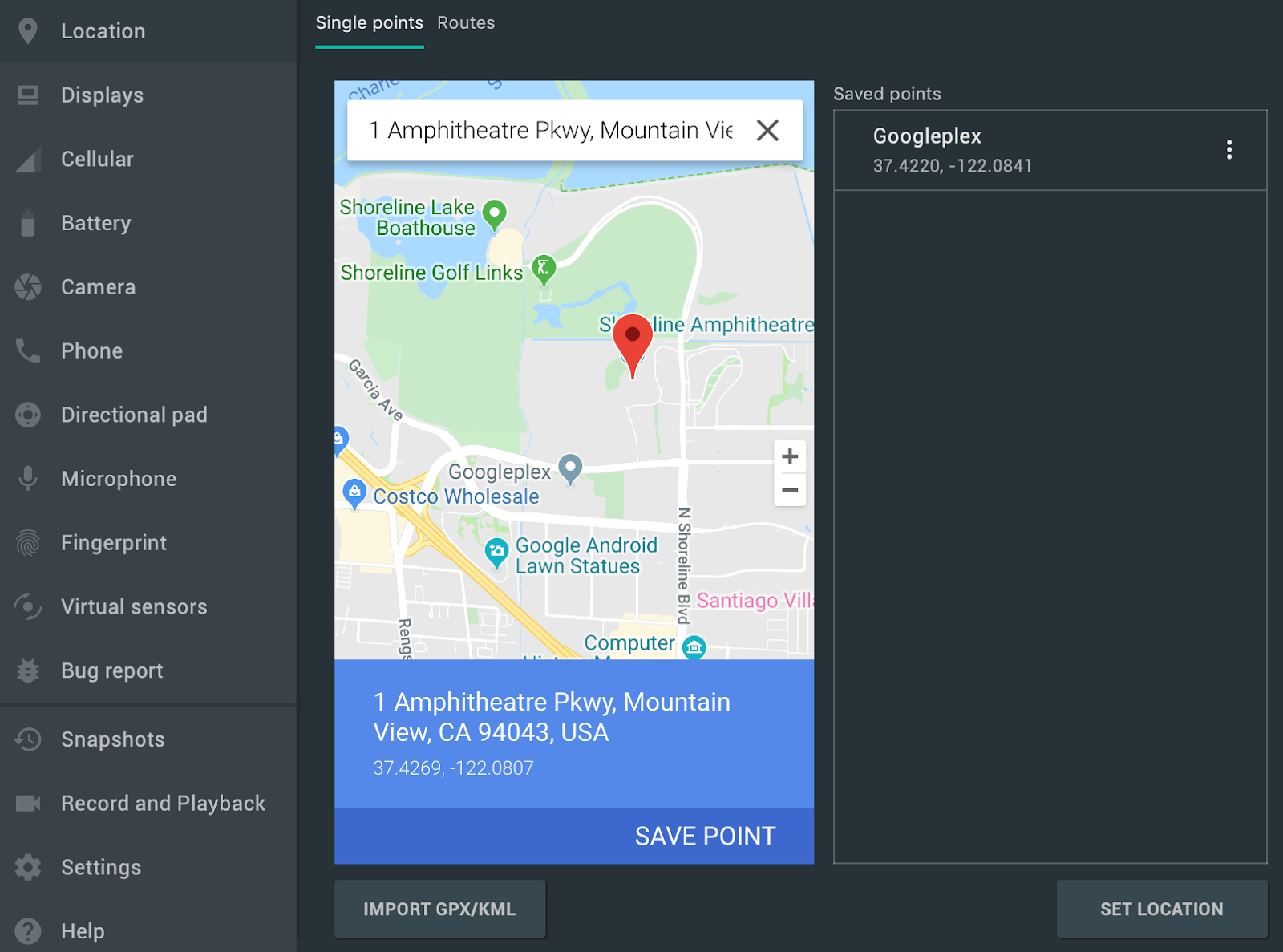 .
.
রুট
সিঙ্গেল পয়েন্ট ট্যাবের মতো, রুটস ট্যাবটি একটি গুগল ম্যাপস ওয়েবভিউ প্রদান করে যা আপনি দুই বা ততোধিক অবস্থানের মধ্যে একটি রুট তৈরি করতে ব্যবহার করতে পারেন। একটি রুট তৈরি এবং সংরক্ষণ করতে, নিম্নলিখিতগুলি করুন:
- ম্যাপ ভিউতে, আপনার রুটের প্রথম গন্তব্য অনুসন্ধান করতে টেক্সট ফিল্ড ব্যবহার করুন।
- অনুসন্ধান ফলাফল থেকে অবস্থানটি নির্বাচন করুন।
- নেভিগেট বোতামটি নির্বাচন করুন।
- মানচিত্র থেকে আপনার রুটের শুরুর স্থানটি নির্বাচন করুন।
- (ঐচ্ছিক) আপনার রুটে অতিরিক্ত স্টপ যোগ করতে গন্তব্য যোগ করুন -এ ক্লিক করুন।
- ম্যাপ ভিউতে রুট সংরক্ষণ করুন ক্লিক করে আপনার রুট সংরক্ষণ করুন।
- রুটের জন্য একটি নাম উল্লেখ করুন এবং সংরক্ষণ করুন এ ক্লিক করুন।
আপনার সংরক্ষিত রুট অনুসরণ করে এমুলেটরটি সিমুলেট করতে, সংরক্ষিত রুটগুলির তালিকা থেকে রুটটি নির্বাচন করুন এবং এক্সটেন্ডেড কন্ট্রোল উইন্ডোর নীচে ডানদিকে প্লে রুট ক্লিক করুন। সিমুলেশন বন্ধ করতে, Stop route এ ক্লিক করুন।
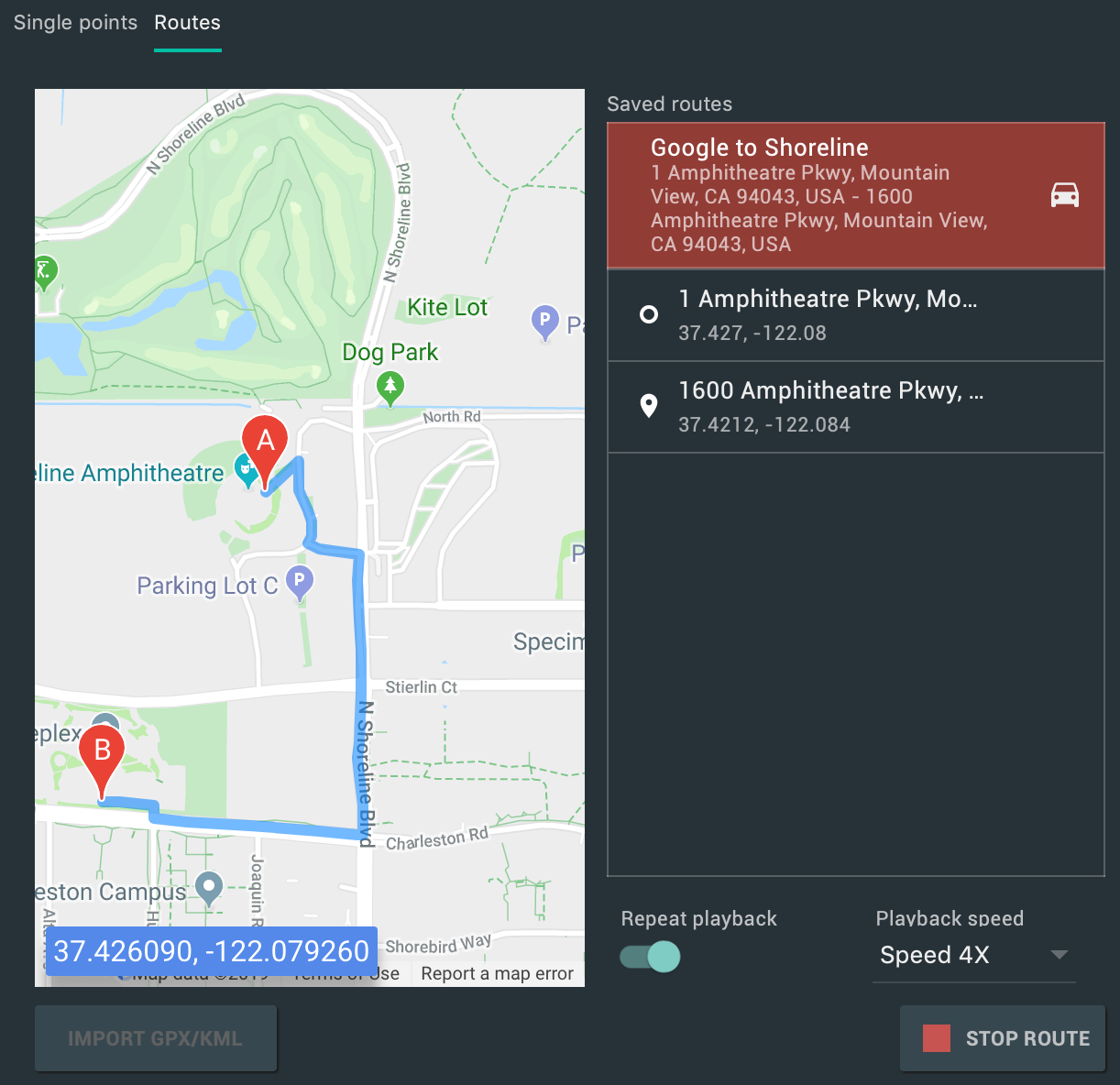 .
.
নির্দিষ্ট রুট অনুসরণ করে এমুলেটরটিকে ক্রমাগত সিমুলেট করতে, "রিপিট প্লেব্যাক" এর পাশের সুইচটি সক্ষম করুন। এমুলেটরটি নির্দিষ্ট রুট কত দ্রুত অনুসরণ করে তা পরিবর্তন করতে, প্লেব্যাক গতি ড্রপডাউন থেকে একটি বিকল্প নির্বাচন করুন।
মাল্টি-ডিসপ্লে সাপোর্ট
অ্যান্ড্রয়েড এমুলেটর এখন আপনাকে আপনার অ্যাপটি একাধিক ডিসপ্লেতে স্থাপন করতে দেয়, যা কাস্টমাইজেবল ডাইমেনশন সমর্থন করে এবং মাল্টি-উইন্ডো এবং মাল্টি-ডিসপ্লে সমর্থন করে এমন অ্যাপগুলি পরীক্ষা করতে আপনাকে সাহায্য করতে পারে। একটি ভার্চুয়াল ডিভাইস চলমান থাকাকালীন, আপনি নিম্নলিখিতভাবে দুটি অতিরিক্ত ডিসপ্লে যোগ করতে পারেন:
এক্সটেন্ডেড কন্ট্রোল খুলুন এবং ডিসপ্লে ট্যাবে যান।
"গৌণ প্রদর্শন যোগ করুন" এ ক্লিক করে আরেকটি প্রদর্শন যোগ করুন।
Secondary displays এর অধীনে ড্রপডাউন মেনু থেকে, নিম্নলিখিতগুলির মধ্যে একটি করুন:
প্রিসেট আকৃতির অনুপাতগুলির মধ্যে একটি নির্বাচন করুন
আপনার কাস্টম ডিসপ্লের জন্য কাস্টম নির্বাচন করুন এবং উচ্চতা , প্রস্থ এবং ডিপিআই সেট করুন।
(ঐচ্ছিক) তৃতীয় ডিসপ্লে যোগ করতে সেকেন্ডারি ডিসপ্লে যোগ করুন -এ ক্লিক করুন।
চলমান ভার্চুয়াল ডিভাইসে নির্দিষ্ট প্রদর্শন(গুলি) যোগ করতে পরিবর্তনগুলি প্রয়োগ করুন ক্লিক করুন।
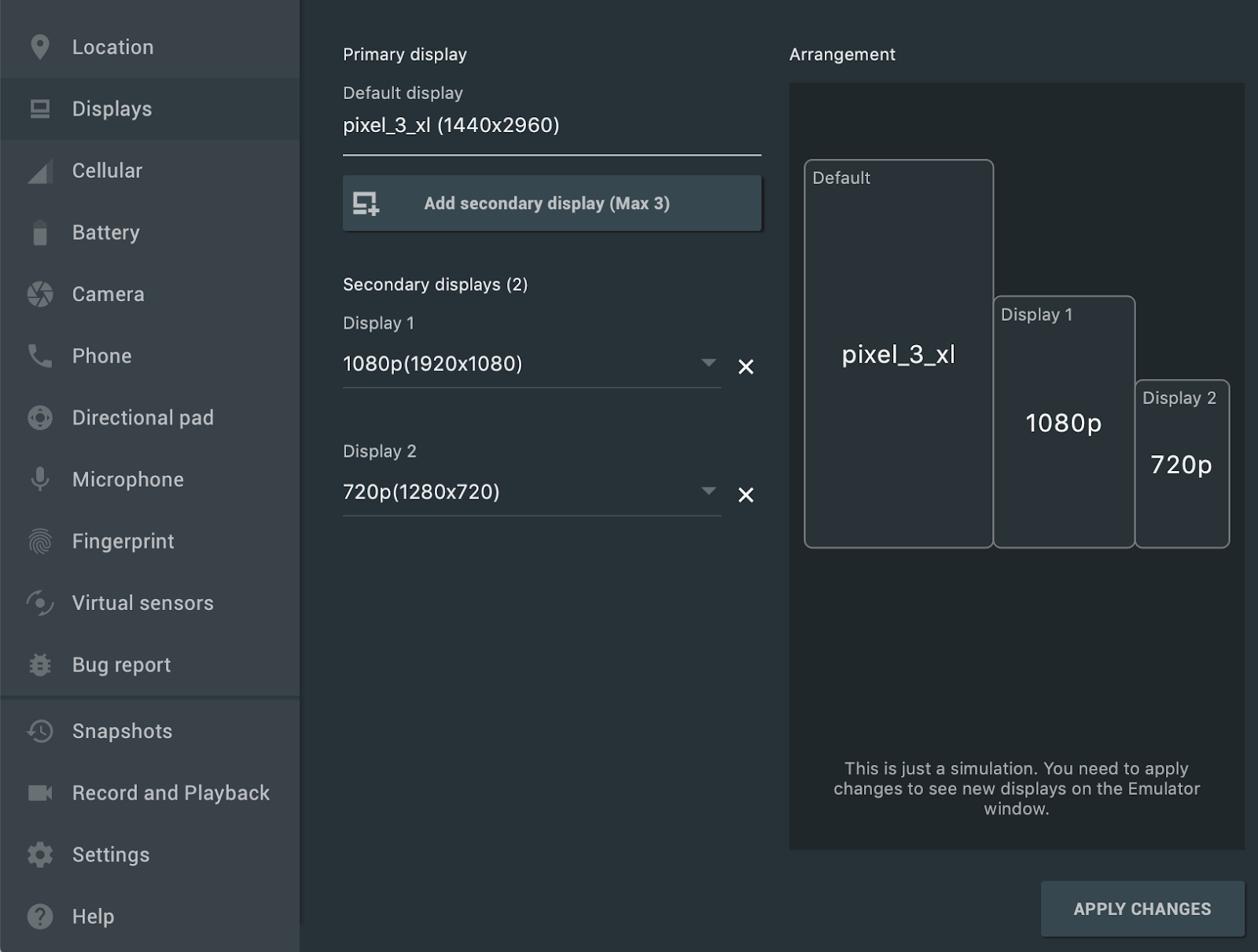
অ্যান্ড্রয়েড অটোমোটিভ ওএসের জন্য নতুন ভার্চুয়াল ডিভাইস এবং প্রকল্প টেমপ্লেট
যখন আপনি Android Studio ব্যবহার করে একটি নতুন প্রকল্প তৈরি করেন, তখন আপনি এখন Create New Project উইজার্ডের Automotive ট্যাব থেকে তিনটি টেমপ্লেট নির্বাচন করতে পারেন: No Activity , Media service এবং Messaging service । বিদ্যমান প্রকল্পগুলির জন্য, আপনি মেনু বার থেকে File > New > New Module নির্বাচন করে এবং Automotive Module নির্বাচন করে Android Automotive ডিভাইসগুলির জন্য সমর্থন যোগ করতে পারেন। Create New Module উইজার্ডটি আপনাকে Android Automotive প্রকল্প টেমপ্লেটগুলির একটি ব্যবহার করে একটি নতুন মডিউল তৈরি করার জন্য গাইড করবে।
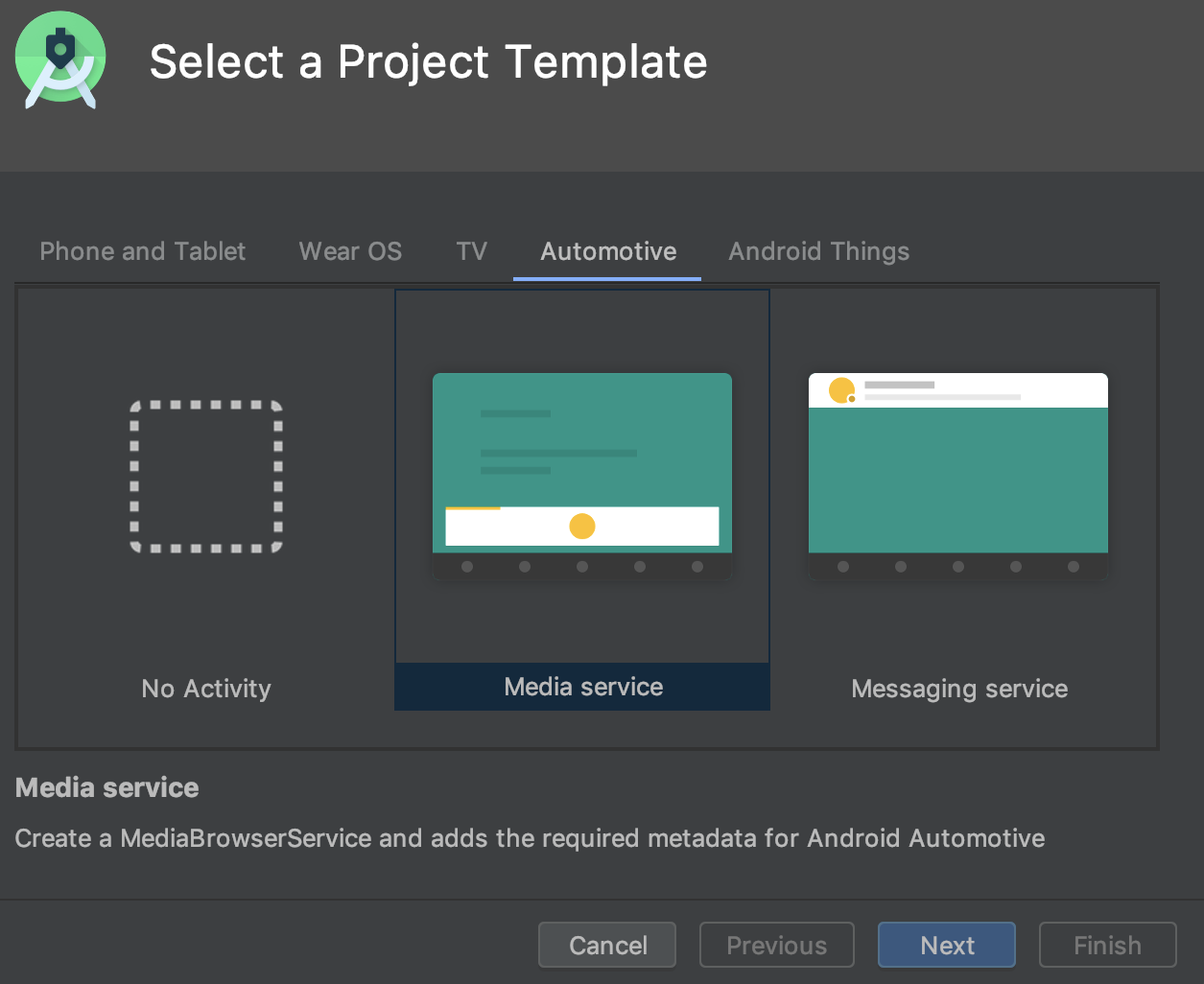 .
.
অতিরিক্তভাবে, আপনি এখন ভার্চুয়াল ডিভাইস কনফিগারেশন উইজার্ডের অটোমোটিভ ট্যাবে নিম্নলিখিত বিকল্পগুলির মধ্যে একটি নির্বাচন করে অ্যান্ড্রয়েড অটোমোটিভ ওএস ডিভাইসের জন্য একটি অ্যান্ড্রয়েড ভার্চুয়াল ডিভাইস (AVD) তৈরি করতে পারেন।
- পোলেস্টার ২ : এমন একটি AVD তৈরি করুন যা পোলেস্টার ২ হেড ইউনিটের অনুকরণ করে।
- অটোমোটিভ (১০২৪পি ল্যান্ডস্কেপ) : জেনেরিক ১০২৪ x ৭৬৮পিক্সেল অ্যান্ড্রয়েড অটোমোটিভ হেড ইউনিটের জন্য একটি এভিডি তৈরি করুন।
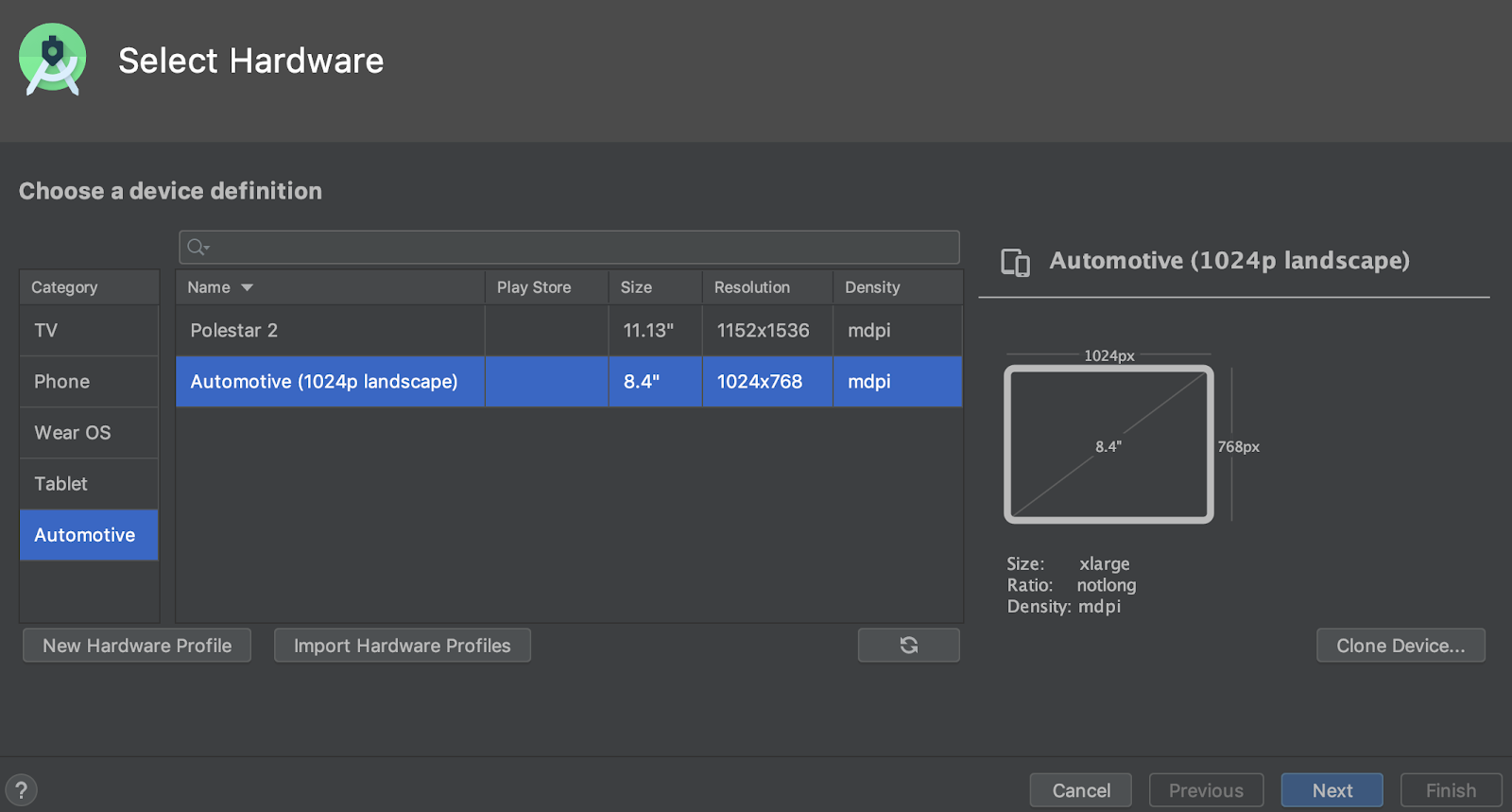 .
.
পুনঃসূচনাযোগ্য SDK ডাউনলোড
SDK ম্যানেজার ব্যবহার করে SDK উপাদান এবং সরঞ্জাম ডাউনলোড করার সময়, Android Studio এখন আপনাকে শুরু থেকে ডাউনলোড পুনরায় চালু করার পরিবর্তে (যেমন, নেটওয়ার্ক সমস্যার কারণে) বাধাগ্রস্ত ডাউনলোডগুলি পুনরায় শুরু করার অনুমতি দেয়। এই বর্ধিতকরণটি বিশেষ করে বড় ডাউনলোডগুলির জন্য সহায়ক, যেমন Android Emulator বা সিস্টেম চিত্র, যখন ইন্টারনেট সংযোগ অবিশ্বস্ত হয়।
এছাড়াও, যদি আপনার SDK ডাউনলোডের কাজটি ব্যাকগ্রাউন্ডে চলমান থাকে, তাহলে আপনি এখন স্ট্যাটাস বারের নিয়ন্ত্রণগুলি ব্যবহার করে ডাউনলোডটি থামাতে বা পুনরায় শুরু করতে পারেন।

স্ট্যাটাস বারে একটি ব্যাকগ্রাউন্ড ডাউনলোড টাস্ক, যেখানে নতুন নিয়ন্ত্রণ রয়েছে যা আপনাকে ডাউনলোড থামাতে বা পুনরায় শুরু করতে দেয়।
Win32 বন্ধ করা হয়েছে
অ্যান্ড্রয়েড স্টুডিওর উইন্ডোজ ৩২-বিট সংস্করণ ডিসেম্বর ২০১৯ এর পরে আর আপডেট পাবে না এবং ডিসেম্বর ২০২০ এর পরে এটি আর সমর্থন পাবে না। আপনি অ্যান্ড্রয়েড স্টুডিও ব্যবহার চালিয়ে যেতে পারেন। তবে, অতিরিক্ত আপডেট পেতে, আপনার ওয়ার্কস্টেশনটি উইন্ডোজের ৬৪-বিট সংস্করণে আপগ্রেড করুন।
আরও জানতে, উইন্ডোজ ৩২-বিট ডেপ্রিসিয়েশন ব্লগটি পড়ুন।
গ্র্যাডেল সিঙ্ক সময় অপ্টিমাইজ করার জন্য নতুন বিকল্প
পূর্ববর্তী রিলিজগুলিতে, অ্যান্ড্রয়েড স্টুডিও গ্র্যাডেল সিঙ্কের সময় সমস্ত গ্র্যাডেল কাজের তালিকা পুনরুদ্ধার করেছিল। বড় প্রকল্পগুলির জন্য, টাস্ক তালিকা পুনরুদ্ধার করলে সিঙ্কের সময় ধীর হতে পারে।
গ্রেডল সিঙ্কের কর্মক্ষমতা উন্নত করতে, ফাইল > সেটিংস > পরীক্ষামূলক এ যান এবং গ্রেডল সিঙ্কের সময় গ্রেডল টাস্ক তালিকা তৈরি করবেন না নির্বাচন করুন।
এই বিকল্পটি সক্রিয় করলে, অ্যান্ড্রয়েড স্টুডিও সিঙ্কের সময় টাস্ক লিস্ট তৈরি করা এড়িয়ে যায়, যা গ্র্যাডেল সিঙ্ককে দ্রুত সম্পন্ন করতে দেয় এবং UI রেসপন্সিভনেস উন্নত করে। মনে রাখবেন, যখন IDE টাস্ক লিস্ট তৈরি করা এড়িয়ে যায়, তখন গ্র্যাডেল প্যানেলে টাস্ক লিস্টগুলি খালি থাকে এবং বিল্ড ফাইলগুলিতে টাস্ক নেম অটো-কমপ্লিশন কাজ করে না।
গ্রেডলের অফলাইন মোড টগল করার জন্য নতুন অবস্থান
Gradle এর অফলাইন মোড সক্রিয় বা নিষ্ক্রিয় করতে, প্রথমে মেনু বার থেকে View > Tool Windows > Gradle নির্বাচন করুন। তারপর, Gradle উইন্ডোর উপরের দিকে, Toggle Offline Mode এ ক্লিক করুন।  .
.
ইন্টেলিজে আইডিয়া ২০১৯.২
২০১৯.২ রিলিজের মাধ্যমে IntelliJ IDEA থেকে উন্নত বৈশিষ্ট্য সহ মূল Android Studio IDE আপডেট করা হয়েছে।
২০১৯.২ সংস্করণের সাথে ক্রমবর্ধমানভাবে অন্তর্ভুক্ত অন্যান্য IntelliJ সংস্করণগুলির উন্নতি সম্পর্কে আরও জানতে, নিম্নলিখিত পৃষ্ঠাগুলি দেখুন:
কমিউনিটি অবদানকারীরা
আমাদের সকল কমিউনিটি অবদানকারীদের ধন্যবাদ যারা বাগ আবিষ্কার করতে এবং Android Studio 3.6 উন্নত করার অন্যান্য উপায় খুঁজে পেতে আমাদের সাহায্য করেছেন। বিশেষ করে, আমরা নিম্নলিখিত ব্যক্তিদের ধন্যবাদ জানাতে চাই যারা বাগ রিপোর্ট করেছেন:
৩.৫ (আগস্ট ২০১৯)
অ্যান্ড্রয়েড স্টুডিও ৩.৫ একটি প্রধান রিলিজ এবং প্রজেক্ট মার্বেলের ফলাফল। অ্যান্ড্রয়েড স্টুডিও ৩.৩ রিলিজের সাথে শুরু করে, প্রজেক্ট মার্বেল উদ্যোগটি একাধিক রিলিজ বিস্তৃত করেছে যা IDE-এর তিনটি প্রধান ক্ষেত্র উন্নত করার উপর দৃষ্টি নিবদ্ধ করে: সিস্টেম হেলথ , ফিচার পলিশ এবং বাগ সংশোধন।
এই এবং অন্যান্য প্রজেক্ট মার্বেল আপডেট সম্পর্কে তথ্যের জন্য, অ্যান্ড্রয়েড ডেভেলপারদের ব্লগ পোস্ট অথবা নীচের বিভাগগুলি পড়ুন।
আমরা আমাদের সকল সম্প্রদায়ের অবদানকারীদেরও ধন্যবাদ জানাতে চাই যারা এই প্রকাশে সহায়তা করেছেন।
৩.৫.৩ (ডিসেম্বর ২০১৯)
এই ছোটখাটো আপডেটে বিভিন্ন বাগ সংশোধন এবং কর্মক্ষমতা উন্নতি অন্তর্ভুক্ত রয়েছে।
৩.৫.২ (নভেম্বর ২০১৯)
এই ছোটখাটো আপডেটে বিভিন্ন বাগ সংশোধন এবং কর্মক্ষমতা উন্নতি অন্তর্ভুক্ত রয়েছে। উল্লেখযোগ্য বাগ সংশোধনের তালিকা দেখতে, রিলিজ আপডেট ব্লগে সম্পর্কিত পোস্টটি পড়ুন।
৩.৫.১ (অক্টোবর ২০১৯)
এই ছোটখাটো আপডেটে বিভিন্ন বাগ সংশোধন এবং কর্মক্ষমতা উন্নতি অন্তর্ভুক্ত রয়েছে। উল্লেখযোগ্য বাগ সংশোধনের তালিকা দেখতে, রিলিজ আপডেট ব্লগে সম্পর্কিত পোস্টটি পড়ুন।
প্রজেক্ট মার্বেল: সিস্টেম হেলথ
এই বিভাগে অ্যান্ড্রয়েড স্টুডিও ৩.৫-এর পরিবর্তনগুলি বর্ণনা করা হয়েছে যা সিস্টেমের স্বাস্থ্য উন্নত করার উপর দৃষ্টি নিবদ্ধ করে।
প্রস্তাবিত মেমরি সেটিংস
অ্যান্ড্রয়েড স্টুডিও এখন আপনাকে অবহিত করবে যদি এটি সনাক্ত করে যে আপনি আপনার অপারেটিং সিস্টেমের জন্য বরাদ্দ করা RAM এর সর্বোচ্চ পরিমাণ বাড়িয়ে কর্মক্ষমতা উন্নত করতে পারেন, যেমন কোর IDE, Gradle ডেমন এবং Kotlin ডেমন। আপনি বিজ্ঞপ্তিতে অ্যাকশন লিঙ্কে ক্লিক করে প্রস্তাবিত সেটিংস গ্রহণ করতে পারেন, অথবা আপনি File > Settings (অথবা MacOS-এ Android Studio > Preferences ) নির্বাচন করে এবং তারপর Appearance & Behavior > System Settings এর অধীনে Memory Settings বিভাগটি খুঁজে বের করে এই সেটিংসগুলি ম্যানুয়ালি সামঞ্জস্য করতে পারেন। আরও জানতে, Maximum heap size দেখুন।

প্রস্তাবিত মেমরি সেটিংস সম্পর্কে একটি বিজ্ঞপ্তি।
মেমোরি ব্যবহারের রিপোর্ট
অ্যান্ড্রয়েড স্টুডিওতে মেমোরি সমস্যাগুলি পুনরুত্পাদন এবং রিপোর্ট করা কখনও কখনও কঠিন। এই সমস্যা সমাধানে সাহায্য করার জন্য, অ্যান্ড্রয়েড স্টুডিও আপনাকে মেনু বার থেকে "সহায়তা > মেমোরি ব্যবহার বিশ্লেষণ করুন" এ ক্লিক করে একটি মেমোরি ব্যবহারের প্রতিবেদন তৈরি করতে দেয়। যখন আপনি এটি করেন, তখন IDE স্থানীয়ভাবে ব্যক্তিগত তথ্যের জন্য ডেটা স্যানিটাইজ করে এবং জিজ্ঞাসা করে যে আপনি মেমোরি সমস্যার উৎস সনাক্ত করতে Android স্টুডিও টিমের কাছে পাঠাতে চান কিনা। আরও জানতে, একটি মেমোরি ব্যবহারের প্রতিবেদন চালান দেখুন।
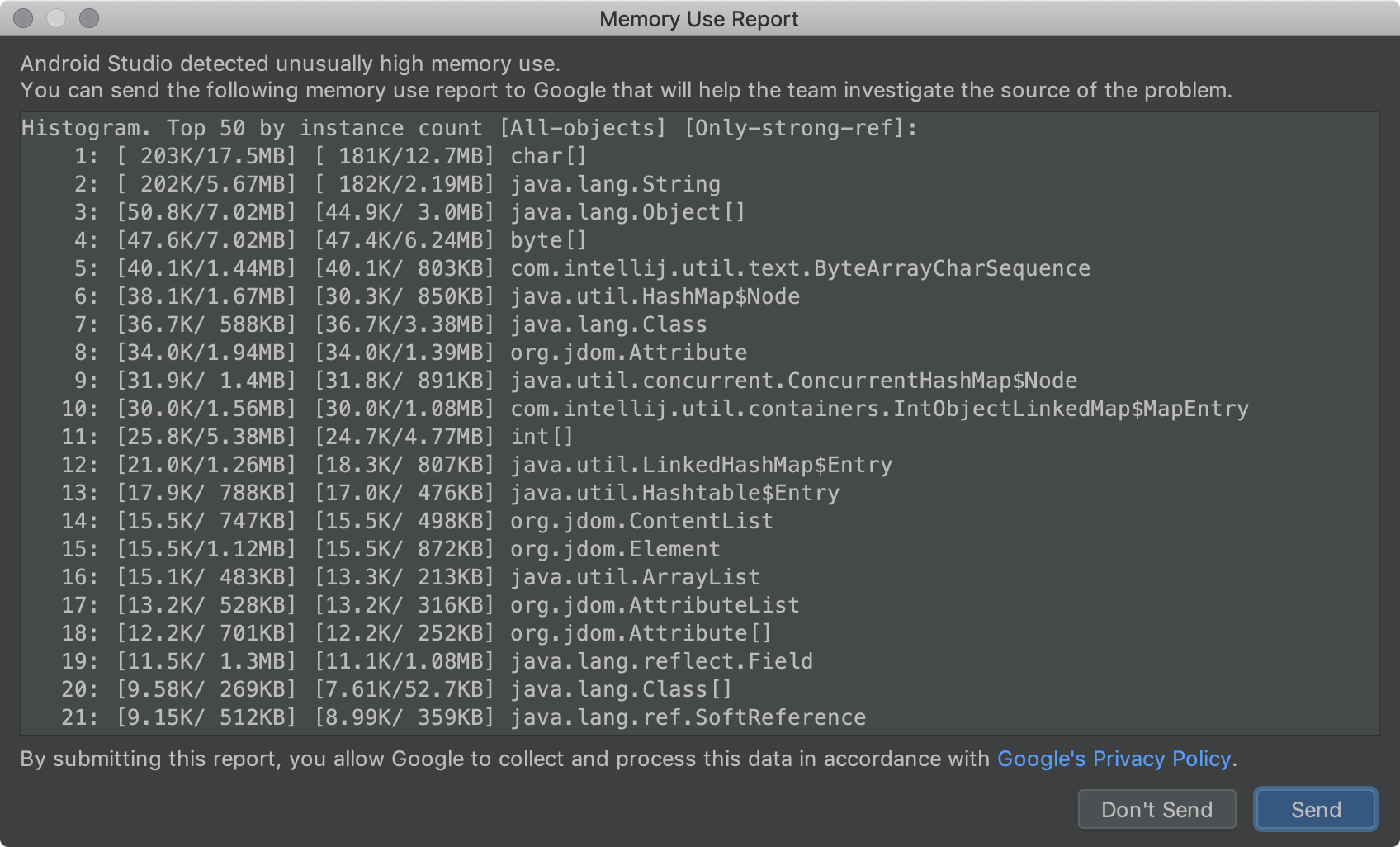
একটি মেমরি ব্যবহারের রিপোর্ট।
উইন্ডোজ: অ্যান্টিভাইরাস ফাইল I/O অপ্টিমাইজেশন
অ্যান্ড্রয়েড স্টুডিও এখন স্বয়ংক্রিয়ভাবে পরীক্ষা করে যে নির্দিষ্ট কিছু প্রোজেক্ট ডিরেক্টরি রিয়েল-টাইম অ্যান্টিভাইরাস স্ক্যানিং থেকে বাদ দেওয়া হচ্ছে কিনা। বিল্ড পারফরম্যান্স উন্নত করার জন্য যখন কোনও সমন্বয় করা যেতে পারে, তখন অ্যান্ড্রয়েড স্টুডিও আপনাকে অবহিত করে এবং আপনার অ্যান্টিভাইরাস কনফিগারেশন কীভাবে অপ্টিমাইজ করবেন সে সম্পর্কে নির্দেশাবলী প্রদান করে। আরও জানতে, বিল্ড স্পিডের উপর অ্যান্টিভাইরাস সফ্টওয়্যারের প্রভাব কমিয়ে আনা দেখুন।
প্রজেক্ট মার্বেল: ফিচার পলিশ
এই বিভাগটি অ্যান্ড্রয়েড স্টুডিও ৩.৫-এর পরিবর্তনগুলি বর্ণনা করে যা বিদ্যমান বৈশিষ্ট্যগুলি উন্নত করার উপর দৃষ্টি নিবদ্ধ করে।
পরিবর্তনগুলি প্রয়োগ করুন
Apply Changes আপনাকে আপনার অ্যাপটি রিস্টার্ট না করেই কোড এবং রিসোর্স পরিবর্তনগুলি আপনার চলমান অ্যাপে পুশ করতে দেয়—এবং কিছু ক্ষেত্রে, বর্তমান অ্যাক্টিভিটি রিস্টার্ট না করেই। Apply Changes আপনার অ্যাপের অবস্থা সংরক্ষণের জন্য একটি সম্পূর্ণ নতুন পদ্ধতি প্রয়োগ করে। Instant Run, যা আপনার APK এর বাইটকোড পুনর্লিখন করে, তার বিপরীতে, Apply Changes Android 8.0 (API লেভেল 26) বা উচ্চতর সংস্করণে সমর্থিত রানটাইম ইন্সট্রুমেন্টেশন ব্যবহার করে ক্লাসগুলিকে পুনরায় সংজ্ঞায়িত করে।
আরও জানতে, পরিবর্তনগুলি প্রয়োগ করুন দেখুন।

পরিবর্তন প্রয়োগের জন্য টুলবার বোতাম।
অ্যাপ স্থাপনের প্রবাহ
IDE-তে একটি নতুন ড্রপ-ডাউন মেনু রয়েছে যা আপনাকে দ্রুত কোন ডিভাইসে আপনার অ্যাপ স্থাপন করতে চান তা নির্বাচন করতে দেয়। এই মেনুতে একটি নতুন বিকল্পও রয়েছে যা আপনাকে একসাথে একাধিক ডিভাইসে আপনার অ্যাপ চালাতে দেয়।
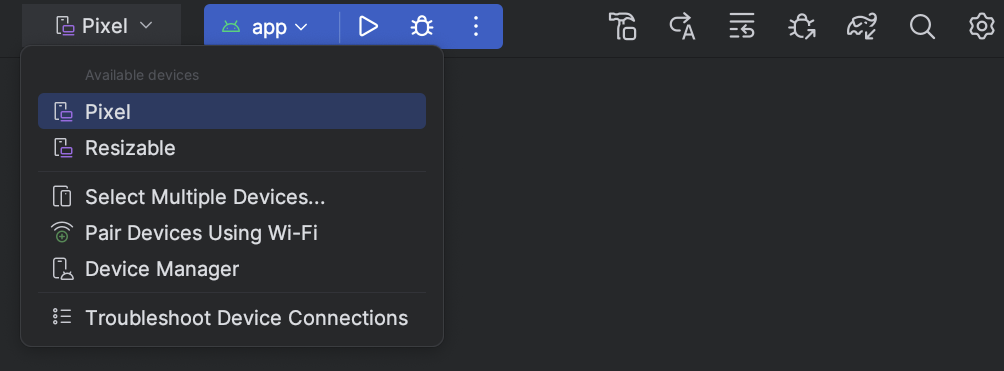
টার্গেট ডিভাইসের ড্রপ-ডাউন মেনু।
উন্নত গ্রেডল সিঙ্ক এবং ক্যাশে সনাক্তকরণ
গ্রেডল যখন আপনার হার্ডডিস্কের ব্যবহার কমিয়ে দেয়, তখন IDE এখন আরও ভালোভাবে সনাক্ত করতে পারে। পূর্ববর্তী সংস্করণগুলিতে, এই অবস্থার কারণে IDE অনুপস্থিত নির্ভরতা রিপোর্ট করত এবং গ্রেডল সিঙ্ক ব্যর্থ হত। এখন, IDE কেবল প্রয়োজন অনুসারে নির্ভরতা ডাউনলোড করে যাতে গ্রেডল সিঙ্ক সফলভাবে সম্পন্ন হয়।
উন্নত বিল্ড ত্রুটি আউটপুট
দ্য বিল্ড  উইন্ডো এখন নিম্নলিখিত বিল্ড প্রক্রিয়াগুলির জন্য আরও ভাল ত্রুটি প্রতিবেদন প্রদান করে, যেমন রিপোর্ট করা ত্রুটির ফাইল এবং লাইনের লিঙ্ক:
উইন্ডো এখন নিম্নলিখিত বিল্ড প্রক্রিয়াগুলির জন্য আরও ভাল ত্রুটি প্রতিবেদন প্রদান করে, যেমন রিপোর্ট করা ত্রুটির ফাইল এবং লাইনের লিঙ্ক:
- AAPT সংকলন এবং লিঙ্কিং
- R8 এবং প্রোগার্ড
- ডেক্সিং
- রিসোর্স মার্জিং
- XML ফাইল পার্সিং
- জাভ্যাক, কোটলিঙ্ক এবং সিমেক সংকলন
প্রকল্পের আপগ্রেড
IDE এবং Android Gradle প্লাগইন আপডেট করতে আপনাকে আরও তথ্য এবং পদক্ষেপ প্রদানের জন্য উন্নত আপডেট অভিজ্ঞতা। উদাহরণস্বরূপ, আরও সিঙ্ক এবং বিল্ড ত্রুটির মধ্যে আপডেট করার সময় ত্রুটিগুলি কমাতে সাহায্য করার জন্য পদক্ষেপ অন্তর্ভুক্ত রয়েছে।
এটা মনে রাখা গুরুত্বপূর্ণ যে, আপনি অন্যান্য উপাদান যেমন অ্যান্ড্রয়েড গ্রেডল প্লাগইন থেকে স্বাধীনভাবে IDE আপডেট করতে পারেন। সুতরাং, নতুন সংস্করণ পাওয়া মাত্রই আপনি নিরাপদে IDE আপডেট করতে পারেন এবং পরে অন্যান্য উপাদান আপডেট করতে পারেন।
লেআউট এডিটর
অ্যান্ড্রয়েড স্টুডিও ৩.৫-এ লেআউট ভিজ্যুয়ালাইজেশন, ব্যবস্থাপনা এবং ইন্টারঅ্যাকশনের ক্ষেত্রে বেশ কিছু উন্নতি অন্তর্ভুক্ত রয়েছে।
ConstraintLayout সাথে কাজ করার সময়, Attributes প্যানেলে একটি নতুন Constraints বিভাগ নির্বাচিত UI উপাদানের সীমাবদ্ধতা সম্পর্ক তালিকাভুক্ত করে। আপনি নকশা পৃষ্ঠ থেকে অথবা সীমাবদ্ধতা তালিকা থেকে উভয় ক্ষেত্রে সীমাবদ্ধতা হাইলাইট করার জন্য একটি সীমাবদ্ধতা নির্বাচন করতে পারেন।
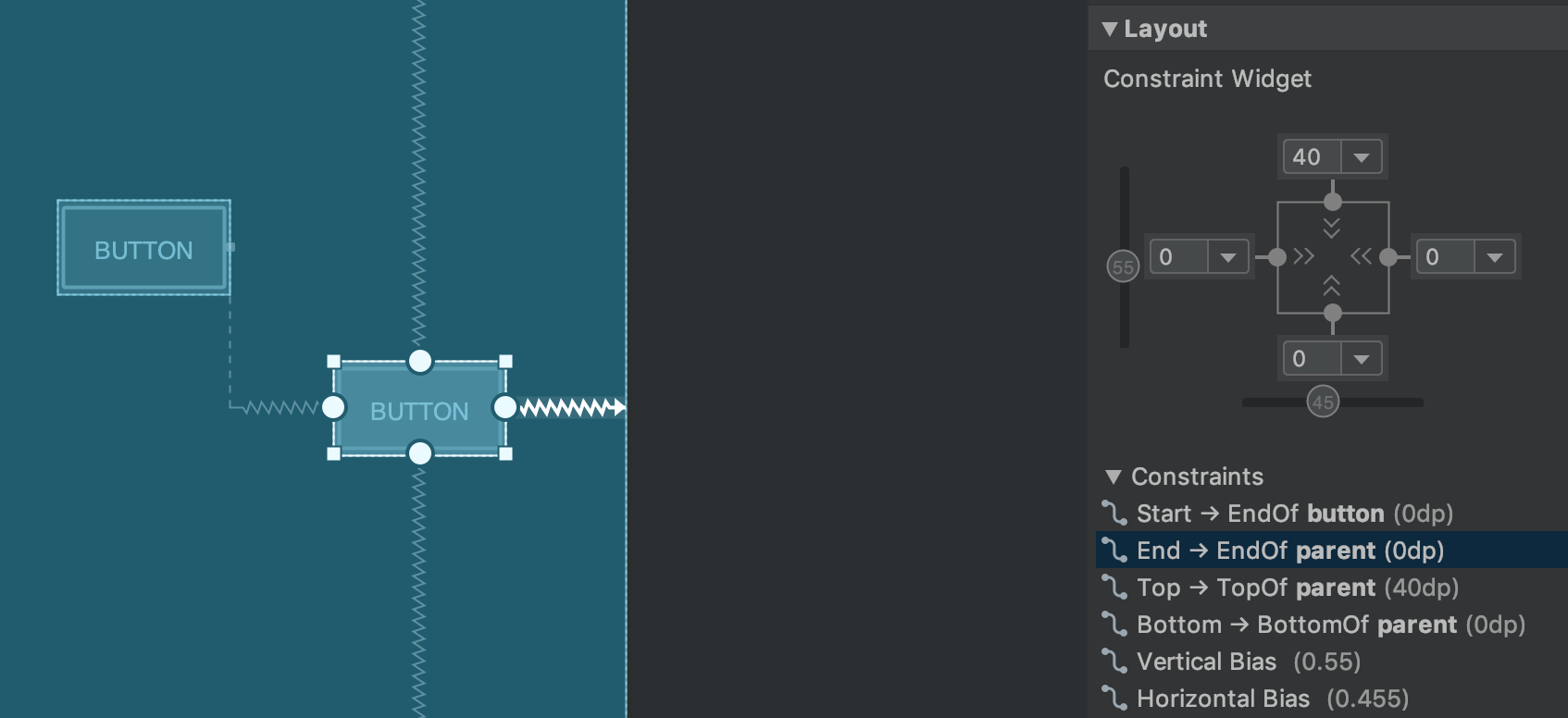
নির্বাচিত UI উপাদানের জন্য সীমাবদ্ধতা সম্পর্ক।
একইভাবে, আপনি এখন একটি সীমাবদ্ধতা নির্বাচন করে এবং Delete কী টিপে মুছে ফেলতে পারেন। আপনি Control কী (macOS-এ Command ) ধরে এবং সীমাবদ্ধতা অ্যাঙ্করে ক্লিক করে একটি সীমাবদ্ধতা মুছে ফেলতে পারেন। মনে রাখবেন যে যখন আপনি Control বা Command কী ধরে রাখেন এবং একটি অ্যাঙ্করের উপর কার্সার রাখেন, তখন সংশ্লিষ্ট যেকোনো সীমাবদ্ধতা লাল হয়ে যায় যা নির্দেশ করে যে আপনি সেগুলি মুছে ফেলার জন্য ক্লিক করতে পারেন।
যখন একটি ভিউ নির্বাচন করা হয়, তখন আপনি নিম্নলিখিত ছবিতে দেখানো অ্যাট্রিবিউট প্যানেলের কনস্ট্রেইন্ট উইজেট বিভাগের যেকোনো + আইকনে ক্লিক করে একটি কনস্ট্রেইন্ট তৈরি করতে পারেন। যখন আপনি একটি নতুন কনস্ট্রেইন্ট তৈরি করেন, তখন লেআউট এডিটর এখন কনস্ট্রেইন্টটি নির্বাচন করে হাইলাইট করে, যা আপনি যা যোগ করেছেন তার জন্য তাৎক্ষণিক ভিজ্যুয়াল প্রতিক্রিয়া প্রদান করে।
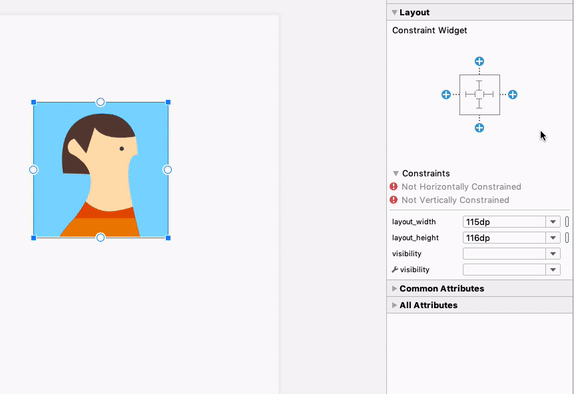
সীমাবদ্ধতা তৈরি করতে সীমাবদ্ধতা উইজেট ব্যবহার করা।
কোনও সীমাবদ্ধতা তৈরি করার সময়, লেআউট এডিটর এখন কেবলমাত্র সেই যোগ্য অ্যাঙ্কর পয়েন্টগুলি দেখায় যেখানে আপনি সীমাবদ্ধ করতে পারেন। পূর্বে, লেআউট এডিটর সমস্ত ভিউতে সমস্ত অ্যাঙ্কর পয়েন্ট হাইলাইট করত, আপনি সেগুলিতে সীমাবদ্ধ করতে পারেন কিনা তা নির্বিশেষে। এছাড়াও, একটি নীল ওভারলে এখন সীমাবদ্ধতার লক্ষ্যকে হাইলাইট করে। এই হাইলাইটিংটি বিশেষভাবে কার্যকর যখন এমন একটি উপাদানকে সীমাবদ্ধ করার চেষ্টা করা হয় যা অন্যটির সাথে ওভারল্যাপ করে।
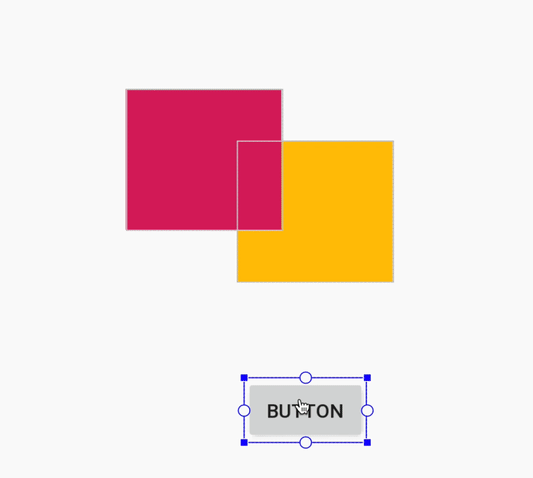
অ্যান্ড্রয়েড স্টুডিও ৩.৪-এ একটি ওভারল্যাপিং কম্পোনেন্টের জন্য একটি সীমাবদ্ধতা তৈরি করা।
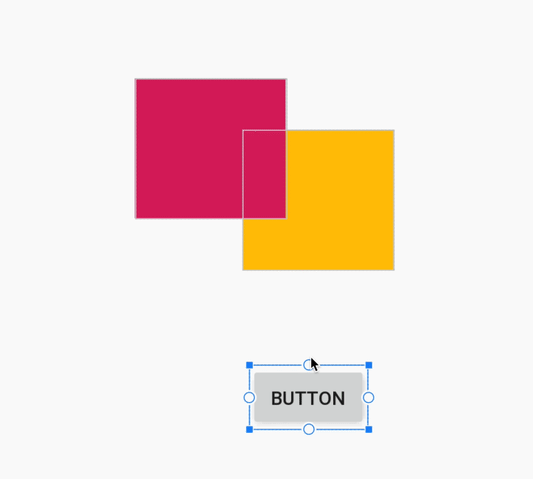
অ্যান্ড্রয়েড স্টুডিও ৩.৫-এ একটি ওভারল্যাপিং কম্পোনেন্টের জন্য একটি সীমাবদ্ধতা তৈরি করা।
উপরের আপডেটগুলি ছাড়াও, অ্যান্ড্রয়েড স্টুডিও 3.5-এ নিম্নলিখিত লেআউট এডিটর উন্নতিগুলিও রয়েছে:
- কনস্ট্রেইন্ট উইজেট এবং ডিফল্ট মার্জিন ড্রপ-ডাউন এখন আপনাকে মার্জিনের জন্য ডাইমেনশন রিসোর্স ব্যবহার করার অনুমতি দেয়।
- লেআউট এডিটর টুলবারে, ডিজাইনের পৃষ্ঠের আকার নির্ধারণকারী ডিভাইসের তালিকা আপডেট করা হয়েছে। এছাড়াও, আকার পরিবর্তনের সময় স্ন্যাপিং আচরণ উন্নত করা হয়েছে এবং ডিজাইনের পৃষ্ঠের আকার পরিবর্তনের হ্যান্ডেলগুলি এখন সর্বদা দৃশ্যমান। আকার পরিবর্তন করার সময়, নতুন ওভারলে প্রদর্শিত হয় যা সাধারণ ডিভাইসের আকার দেখায়।
- লেআউট এডিটরে একটি নতুন রঙের স্কিম রয়েছে যা ধারাবাহিকতা উন্নত করে এবং উপাদান, পাঠ্য এবং সীমাবদ্ধতার মধ্যে বৈসাদৃশ্য হ্রাস করে।
- ব্লুপ্রিন্ট মোডে এখন এমন কিছু উপাদানের জন্য টেক্সট সাপোর্ট অন্তর্ভুক্ত রয়েছে যেখানে টেক্সট দেখানো হচ্ছিল না।
এই পরিবর্তনগুলি সম্পর্কে আরও তথ্যের জন্য, Android Studio Project Marble: Layout Editor দেখুন।
ডেটা বাইন্ডিং
ডেটা বাইন্ডিংয়ের জন্য ক্রমবর্ধমান অ্যানোটেশন প্রক্রিয়াকরণ সমর্থন যোগ করার পাশাপাশি, IDE XML-এ ডেটা বাইন্ডিং এক্সপ্রেশন তৈরি করার সময় স্মার্ট এডিটর বৈশিষ্ট্য এবং কর্মক্ষমতা উন্নত করে।

অ্যান্ড্রয়েড স্টুডিও ৩.৪-এ কোড এডিটরের পারফরম্যান্স।

অ্যান্ড্রয়েড স্টুডিও ৩.৫-এ উন্নত কোড সম্পাদনা কর্মক্ষমতা।
C/C++ প্রকল্পের জন্য উন্নত সমর্থন
অ্যান্ড্রয়েড স্টুডিও ৩.৫-এ বেশ কিছু পরিবর্তন অন্তর্ভুক্ত করা হয়েছে যা C/C++ প্রকল্পের জন্য সমর্থন উন্নত করে।
একক ভেরিয়েন্ট সিঙ্কের জন্য ভেরিয়েন্ট প্যানেলের উন্নতি তৈরি করুন
আপনি এখন বিল্ড ভেরিয়েন্ট প্যানেলে সক্রিয় বিল্ড ভেরিয়েন্ট এবং সক্রিয় ABI উভয়ই নির্দিষ্ট করতে পারেন। এই বৈশিষ্ট্যটি প্রতিটি মডিউলের বিল্ড কনফিগারেশনকে সহজ করে তোলে এবং গ্র্যাডেল সিঙ্ক কর্মক্ষমতাও উন্নত করতে পারে।
আরও জানতে, বিল্ড ভেরিয়েন্ট পরিবর্তন দেখুন।
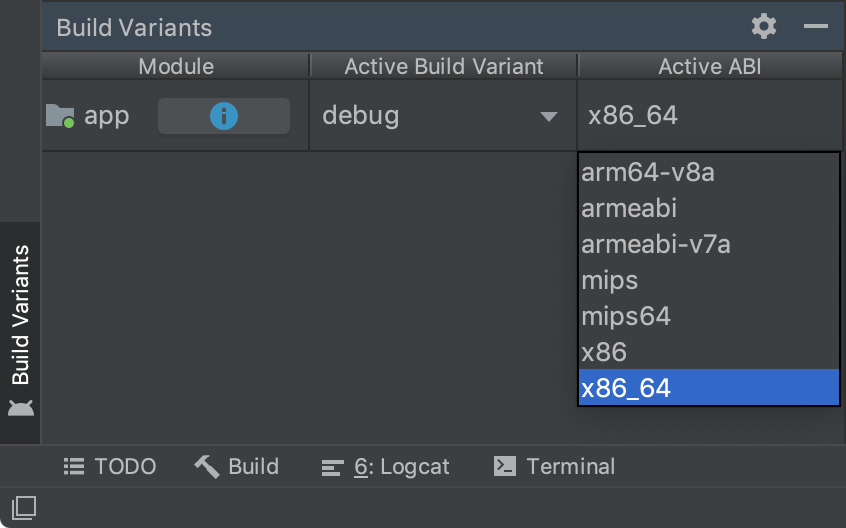
ABI দ্বারা একক ভেরিয়েন্ট নির্বাচন সহ বিল্ড ভেরিয়েন্ট প্যানেল।
NDK-এর পাশাপাশি সংস্করণ
এখন আপনি NDK-এর একাধিক সংস্করণ পাশাপাশি ব্যবহার করতে পারবেন। এই বৈশিষ্ট্যটি আপনার প্রকল্পগুলি কনফিগার করার সময় আপনাকে আরও নমনীয়তা দেয়—উদাহরণস্বরূপ, যদি আপনার এমন প্রকল্প থাকে যা একই মেশিনে NDK-এর বিভিন্ন সংস্করণ ব্যবহার করে।
যদি আপনার প্রকল্পটি Android Gradle প্লাগইন 3.5.0 বা তার বেশি ব্যবহার করে, তাহলে আপনি আপনার প্রকল্পের প্রতিটি মডিউলের জন্য NDK-এর কোন সংস্করণটি ব্যবহার করা উচিত তাও নির্দিষ্ট করতে পারেন। আপনি এই বৈশিষ্ট্যটি পুনরুৎপাদনযোগ্য বিল্ড তৈরি করতে এবং NDK সংস্করণ এবং Android Gradle প্লাগইনের মধ্যে অসঙ্গতি কমাতে ব্যবহার করতে পারেন।
আরও জানতে, NDK, CMake, এবং LLDB ইনস্টল এবং কনফিগার করুন দেখুন।
ChromeOS সাপোর্ট
অ্যান্ড্রয়েড স্টুডিও এখন আনুষ্ঠানিকভাবে ChromeOS ডিভাইসগুলিকে সমর্থন করে, যেমন HP Chromebook x360 14, Acer Chromebook 13/Spin 13, এবং অন্যান্য যা আপনি সিস্টেমের প্রয়োজনীয়তাগুলিতে পড়তে পারেন। শুরু করতে, আপনার সামঞ্জস্যপূর্ণ ChromeOS ডিভাইসে অ্যান্ড্রয়েড স্টুডিও ডাউনলোড করুন এবং ইনস্টলেশন নির্দেশাবলী অনুসরণ করুন।
দ্রষ্টব্য: ChromeOS-এ Android Studio বর্তমানে শুধুমাত্র একটি সংযুক্ত হার্ডওয়্যার ডিভাইসে আপনার অ্যাপ স্থাপন সমর্থন করে। আরও জানতে, হার্ডওয়্যার ডিভাইসে অ্যাপ চালান পড়ুন।
বৈশিষ্ট্য মডিউলের জন্য শর্তসাপেক্ষ ডেলিভারি
শর্তসাপেক্ষ ডেলিভারি আপনাকে অ্যাপ ইনস্টলের সময় স্বয়ংক্রিয়ভাবে ডাউনলোড করার জন্য ফিচার মডিউলগুলির জন্য নির্দিষ্ট ডিভাইস কনফিগারেশন প্রয়োজনীয়তা সেট করতে দেয়। উদাহরণস্বরূপ, আপনি এমন একটি ফিচার মডিউল কনফিগার করতে পারেন যাতে অগমেন্টেড রিয়েলিটি (AR) এর কার্যকারিতা অন্তর্ভুক্ত থাকে যা শুধুমাত্র AR সমর্থন করে এমন ডিভাইসগুলির জন্য অ্যাপ ইনস্টলে উপলব্ধ থাকে।
এই ডেলিভারি মেকানিজম বর্তমানে নিম্নলিখিত ডিভাইস কনফিগারেশনের উপর ভিত্তি করে অ্যাপ ইনস্টলের সময় একটি মডিউল ডাউনলোড নিয়ন্ত্রণ করতে সহায়তা করে:
- OpenGL ES সংস্করণ সহ ডিভাইস হার্ডওয়্যার এবং সফ্টওয়্যার বৈশিষ্ট্যগুলি
- ব্যবহারকারীর দেশ
- API স্তর
যদি কোনও ডিভাইস আপনার নির্দিষ্ট করা সমস্ত প্রয়োজনীয়তা পূরণ না করে, তাহলে অ্যাপ ইনস্টল করার সময় মডিউলটি ডাউনলোড করা হয় না। তবে, আপনার অ্যাপটি পরে প্লে কোর লাইব্রেরি ব্যবহার করে চাহিদা অনুযায়ী মডিউলটি ডাউনলোড করার অনুরোধ করতে পারে। আরও জানতে, শর্তসাপেক্ষ ডেলিভারি কনফিগার করুন পড়ুন।
ইন্টেলিজে আইডিয়া ২০১৯.১
মূল অ্যান্ড্রয়েড স্টুডিও আইডিই ২০১৯.১ রিলিজের মাধ্যমে ইন্টেলিজ আইডিইএ থেকে উন্নত বৈশিষ্ট্য, যেমন থিম কাস্টমাইজেশন, সহ আপডেট করা হয়েছে।
অ্যান্ড্রয়েড স্টুডিওর সাথে অন্তর্ভুক্ত সর্বশেষ IntelliJ সংস্করণটি ছিল 2018.3.4। অ্যান্ড্রয়েড স্টুডিওর এই রিলিজের সাথে ক্রমবর্ধমানভাবে অন্তর্ভুক্ত অন্যান্য IntelliJ সংস্করণগুলির উন্নতি সম্পর্কে আরও তথ্যের জন্য, নিম্নলিখিত বাগ-সমাধান আপডেটগুলি দেখুন:
- ইন্টেলিজে আইডিয়া ২০১৮.৩.৬ {: .external-link}
- ইন্টেলিজে আইডিয়া ২০১৮.৩.৫ {: .external-link}
অ্যান্ড্রয়েড গ্রেডল প্লাগইন ৩.৫.০ আপডেট
অ্যান্ড্রয়েড গ্র্যাডেল প্লাগইন ৩.৫.০-এ নতুন কী রয়েছে, যেমন ইনক্রিমেন্টাল অ্যানোটেশন প্রসেসিং এবং ক্যাশেবল ইউনিট পরীক্ষার জন্য উন্নত সমর্থন সম্পর্কে তথ্যের জন্য, এর রিলিজ নোটগুলি দেখুন।
কমিউনিটি অবদানকারীরা
আমাদের সকল কমিউনিটি অবদানকারীদের ধন্যবাদ যারা আমাদের বাগ আবিষ্কার করতে এবং Android Studio 3.5 উন্নত করার অন্যান্য উপায় খুঁজে পেতে সাহায্য করেছেন। বিশেষ করে, আমরা নিম্নলিখিত ব্যক্তিদের ধন্যবাদ জানাতে চাই যারা P0 এবং P1 বাগ রিপোর্ট করেছেন:
|
|
|
৩.৪ (এপ্রিল ২০১৯)
অ্যান্ড্রয়েড স্টুডিও ৩.৪ একটি প্রধান রিলিজ যাতে বিভিন্ন ধরণের নতুন বৈশিষ্ট্য এবং উন্নতি অন্তর্ভুক্ত রয়েছে।
৩.৪.২ (জুলাই ২০১৯)
এই ছোটখাটো আপডেটে বিভিন্ন বাগ সংশোধন এবং কর্মক্ষমতা উন্নতি অন্তর্ভুক্ত রয়েছে। উল্লেখযোগ্য বাগ সংশোধনের তালিকা দেখতে, রিলিজ আপডেট ব্লগে সম্পর্কিত পোস্টটি পড়ুন।
৩.৪.১ (মে ২০১৯)
এই ছোটখাটো আপডেটে বিভিন্ন বাগ সংশোধন এবং কর্মক্ষমতা উন্নতি অন্তর্ভুক্ত রয়েছে। উল্লেখযোগ্য বাগ সংশোধনের তালিকা দেখতে, রিলিজ আপডেট ব্লগে সম্পর্কিত পোস্টটি পড়ুন।
৩.৪.০ জ্ঞাত সমস্যা
Android Q বিটা চলমান ডিভাইসে আপনার অ্যাপ স্থাপন করার সময় প্রোফাইলিং অক্ষম করা হয়।
- ডেটা বাইন্ডিং লাইব্রেরি ব্যবহার করার সময়,
LiveDataListener.onChanged()NPE ব্যবহার করে ব্যর্থ হতে পারে। এই সমস্যার সমাধান Android Studio 3.4.1 এ অন্তর্ভুক্ত করা হবে এবং এটি ইতিমধ্যেই Android Studio 3.5 এর সর্বশেষ প্রিভিউ সংস্করণে উপলব্ধ। ( ইস্যু #122066788 দেখুন)
ইন্টেলিজে আইডিয়া ২০১৮.৩.৪
২০১৮.৩.৪ রিলিজের মাধ্যমে IntelliJ IDEA থেকে উন্নত বৈশিষ্ট্যের মাধ্যমে মূল Android Studio IDE আপডেট করা হয়েছে।
অ্যান্ড্রয়েড গ্রেডল প্লাগইন ৩.৪.০ আপডেট
অ্যান্ড্রয়েড গ্র্যাডেল প্লাগইন ৩.৪.০-এ নতুন কী রয়েছে সে সম্পর্কে তথ্যের জন্য, এর রিলিজ নোটগুলি দেখুন।
নতুন প্রকল্প কাঠামোর ডায়ালগ
নতুন প্রজেক্ট স্ট্রাকচার ডায়ালগ (PSD) নির্ভরতা আপডেট করা এবং আপনার প্রজেক্টের বিভিন্ন দিক যেমন মডিউল, বিল্ড ভেরিয়েন্ট, সাইনিং কনফিগারেশন এবং বিল্ড ভেরিয়েবল কনফিগার করা সহজ করে তোলে।
আপনি মেনু বার থেকে File > Project Structure নির্বাচন করে PSD খুলতে পারেন। আপনি Windows এবং Linux-এ Ctrl+Shift+Alt+S , অথবা macOS-এ Command+; (সেমিকোলন) টিপে PSD খুলতে পারেন। আপনি নীচে PSD-এর কিছু নতুন এবং আপডেট করা অংশের বিবরণ পেতে পারেন।
ভেরিয়েবল
PSD-এর নতুন ভেরিয়েবল বিভাগটি আপনাকে বিল্ড ভেরিয়েবল তৈরি এবং পরিচালনা করতে দেয়, যেমন আপনার প্রকল্প জুড়ে নির্ভরতার জন্য সংস্করণ নম্বরগুলি সামঞ্জস্যপূর্ণ রাখা।
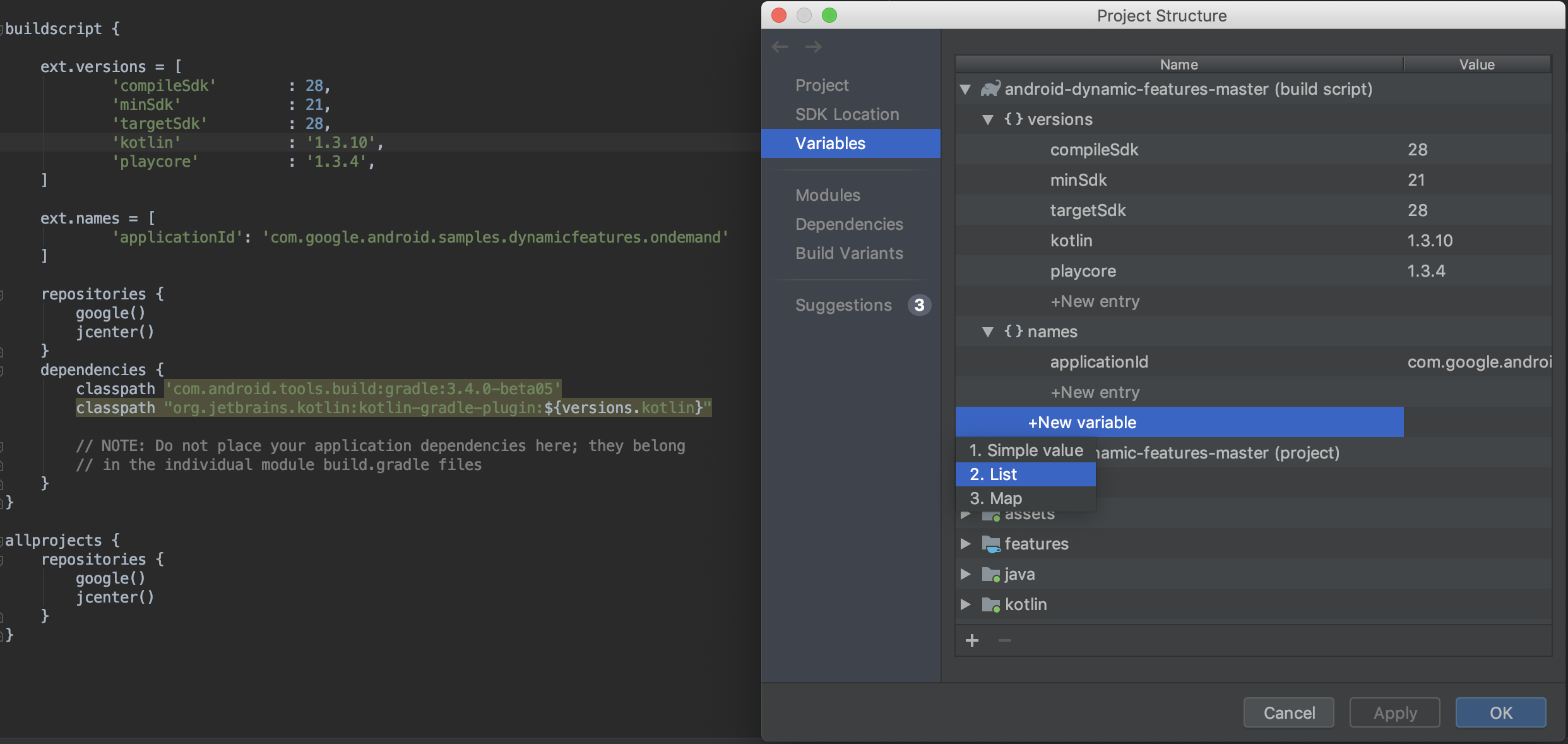
- আপনার প্রকল্পের গ্রেডল বিল্ড স্ক্রিপ্টগুলিতে ইতিমধ্যে বিদ্যমান বিল্ড ভেরিয়েবলগুলি দ্রুত দেখুন এবং সম্পাদনা করুন।
- PSD থেকে সরাসরি একটি প্রকল্প- অথবা মডিউল-স্তরে নতুন বিল্ড ভেরিয়েবল যোগ করুন।
দ্রষ্টব্য: যদি আপনার বিদ্যমান বিল্ড কনফিগারেশন ফাইলগুলি জটিল গ্রুভি স্ক্রিপ্টের মাধ্যমে মান নির্ধারণ করে, তাহলে আপনি PSD এর মাধ্যমে সেই মানগুলি সম্পাদনা করতে পারবেন না। উপরন্তু, আপনি PSD ব্যবহার করে Kotlin-এ লেখা বিল্ড ফাইলগুলি সম্পাদনা করতে পারবেন না।
মডিউল
একটি বিদ্যমান মডিউলের সমস্ত বিল্ড ভেরিয়েন্টে প্রয়োগ করা বৈশিষ্ট্যগুলি কনফিগার করুন অথবা মডিউল বিভাগ থেকে আপনার প্রকল্পে নতুন মডিউল যুক্ত করুন। উদাহরণস্বরূপ, এখানে আপনি defaultConfig বৈশিষ্ট্যগুলি কনফিগার করতে পারেন অথবা সাইনিং কনফিগারেশন পরিচালনা করতে পারেন।
নির্ভরতা
আপনার প্রকল্পের নির্ভরতা গ্রাফের প্রতিটি নির্ভরতা পরীক্ষা করুন এবং কল্পনা করুন, যা প্রকল্প সিঙ্কের সময় গ্র্যাডেল দ্বারা সমাধান করা হয়েছে, এই পদক্ষেপগুলি অনুসরণ করে:
- PSD এর বাম দিকের ফলকে, Dependencies নির্বাচন করুন।
- মডিউল ফলকে, এমন একটি মডিউল নির্বাচন করুন যার জন্য আপনি সমাধান করা নির্ভরতাগুলি পরীক্ষা করতে চান।
- PSD এর ডান দিকে, Resolved Dependencies প্যানটি খুলুন, যা নীচে দেখানো হয়েছে।
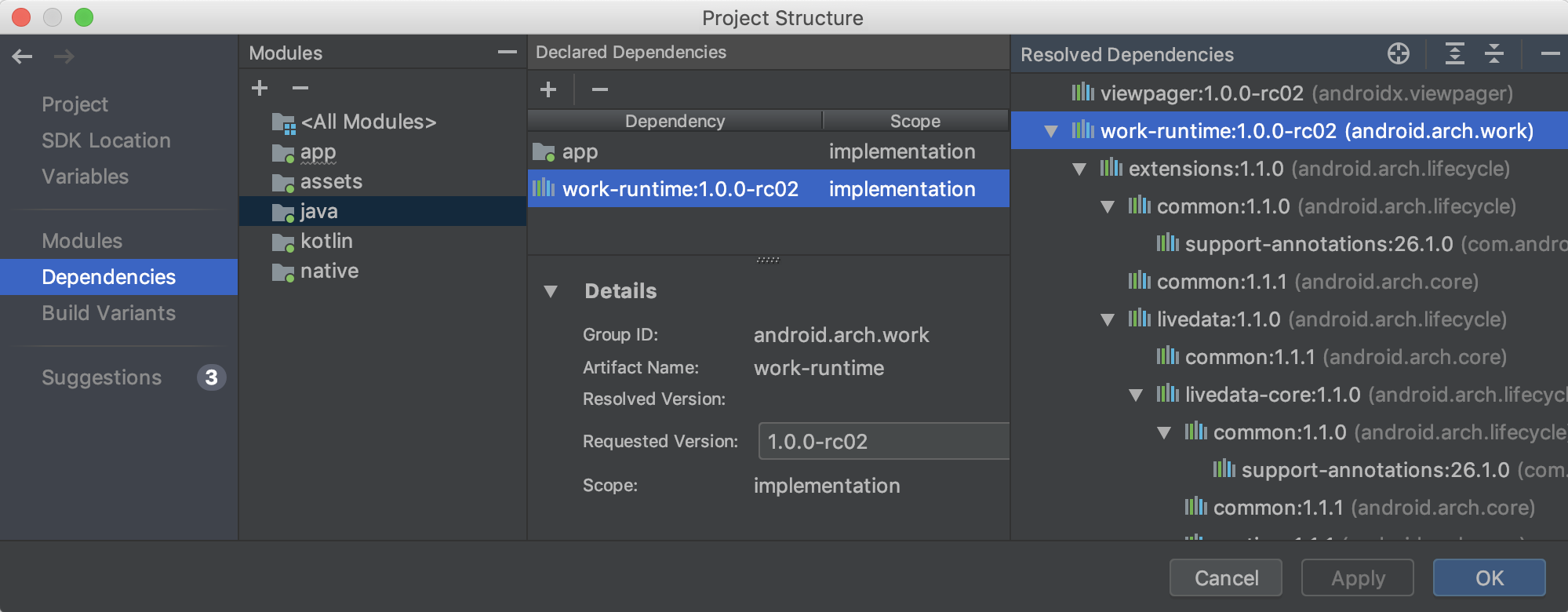
আপনি PSD এর Dependencies বিভাগ থেকে প্রথমে একটি মডিউল নির্বাচন করে, Declared Dependencies বিভাগে (+) বোতামে ক্লিক করে এবং আপনি যে ধরণের Dependencies যোগ করতে চান তা নির্বাচন করে দ্রুত আপনার প্রকল্পে Dependencies অনুসন্ধান এবং যোগ করতে পারেন।
আপনার নির্বাচিত নির্ভরতার ধরণের উপর নির্ভর করে, আপনি নীচের চিত্রের মতো একটি ডায়ালগ দেখতে পাবেন, যা আপনাকে মডিউলে নির্ভরতা যোগ করতে সাহায্য করবে।
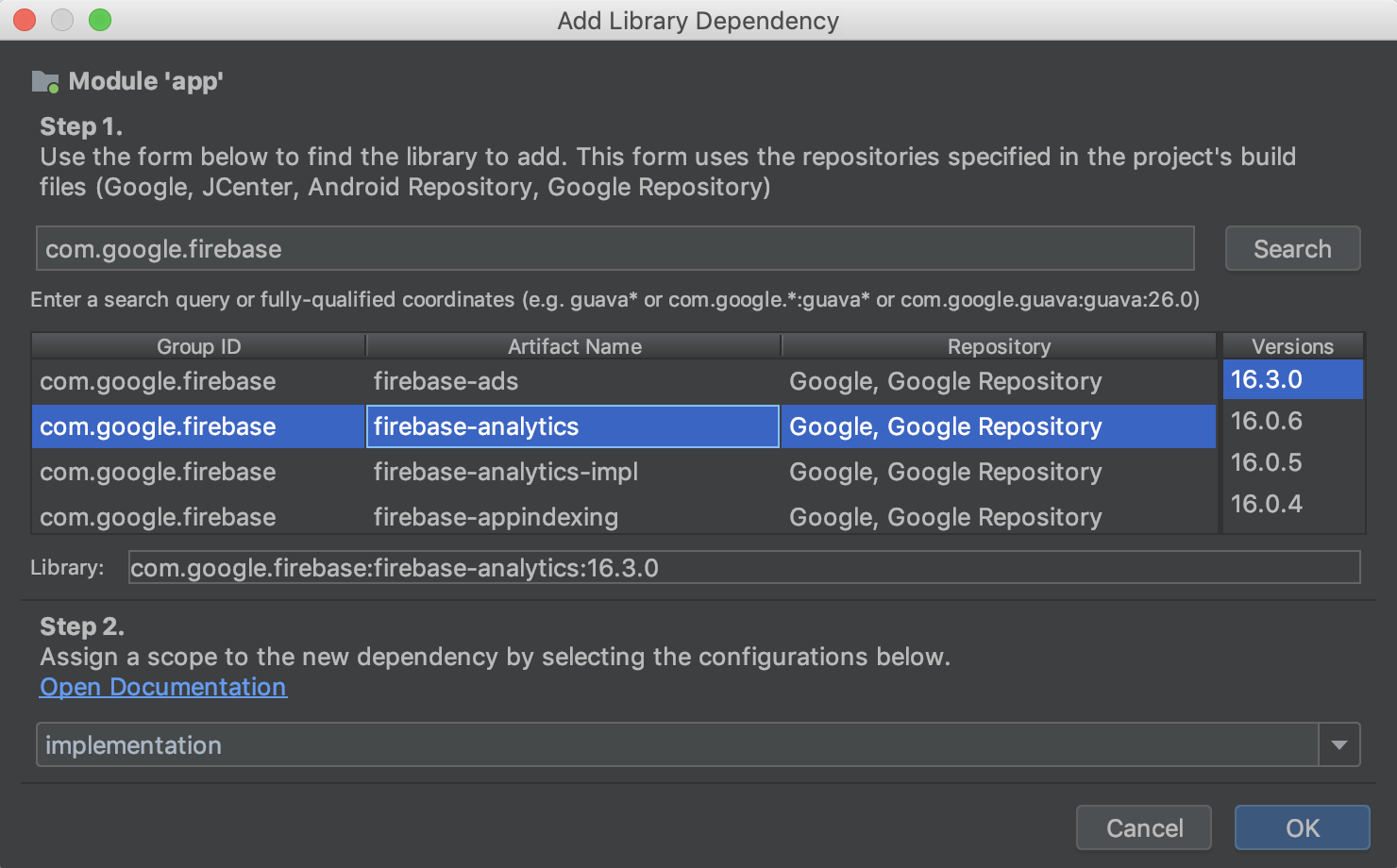
বিল্ড ভেরিয়েন্ট
PSD-এর এই অংশে, আপনার প্রকল্পের প্রতিটি মডিউলের জন্য বিল্ড ভেরিয়েন্ট এবং পণ্যের স্বাদ তৈরি এবং কনফিগার করুন। আপনি ম্যানিফেস্ট প্লেসহোল্ডার যোগ করতে পারেন, ProGuard ফাইল যোগ করতে পারেন, সাইনিং কী বরাদ্দ করতে পারেন এবং আরও অনেক কিছু করতে পারেন।
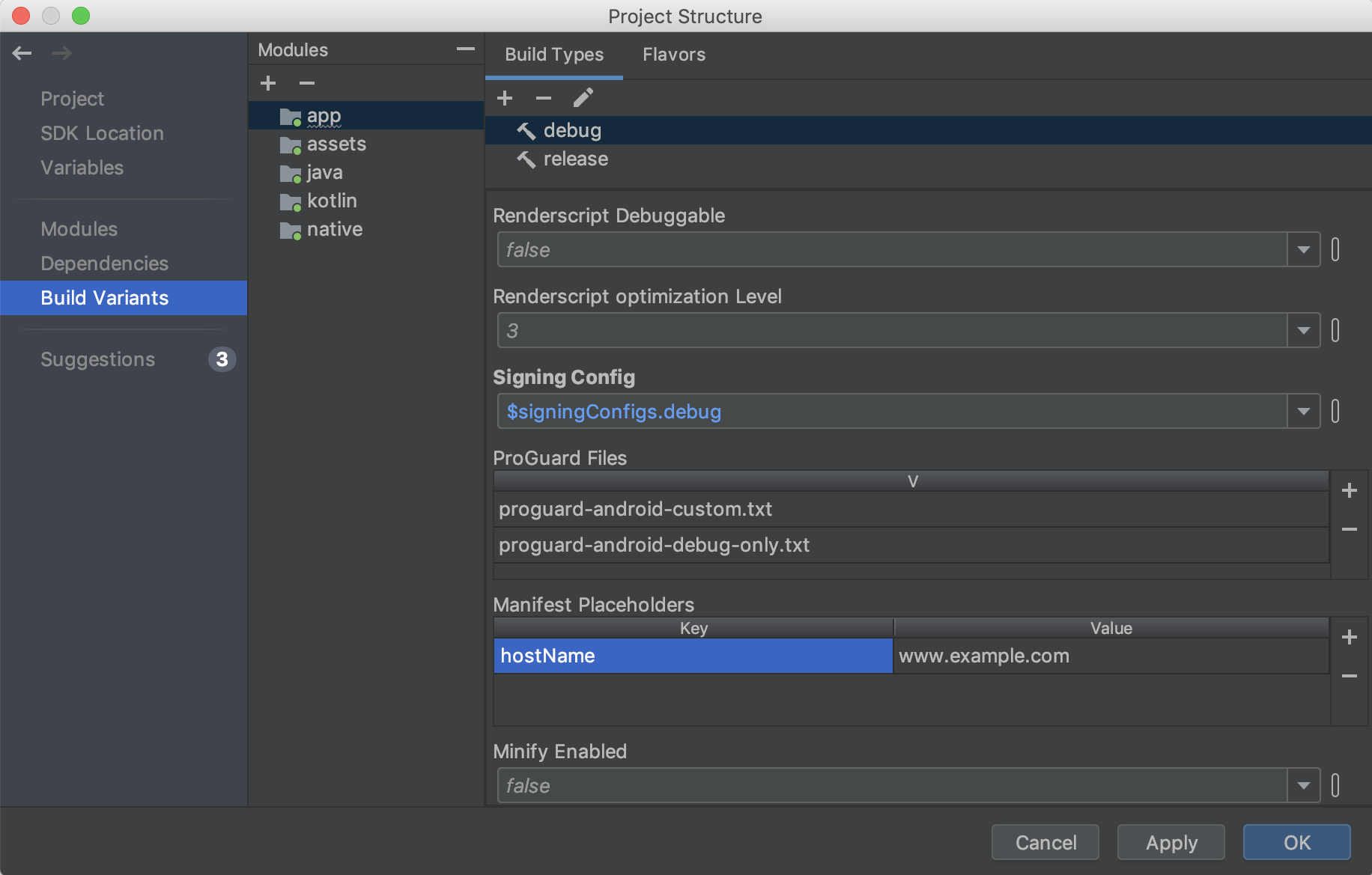
পরামর্শ
নীচে দেখানো হয়েছে, সাজেশন বিভাগে প্রকল্প নির্ভরতা এবং বিল্ড ভেরিয়েবলের জন্য প্রস্তাবিত আপডেটগুলি দেখুন।
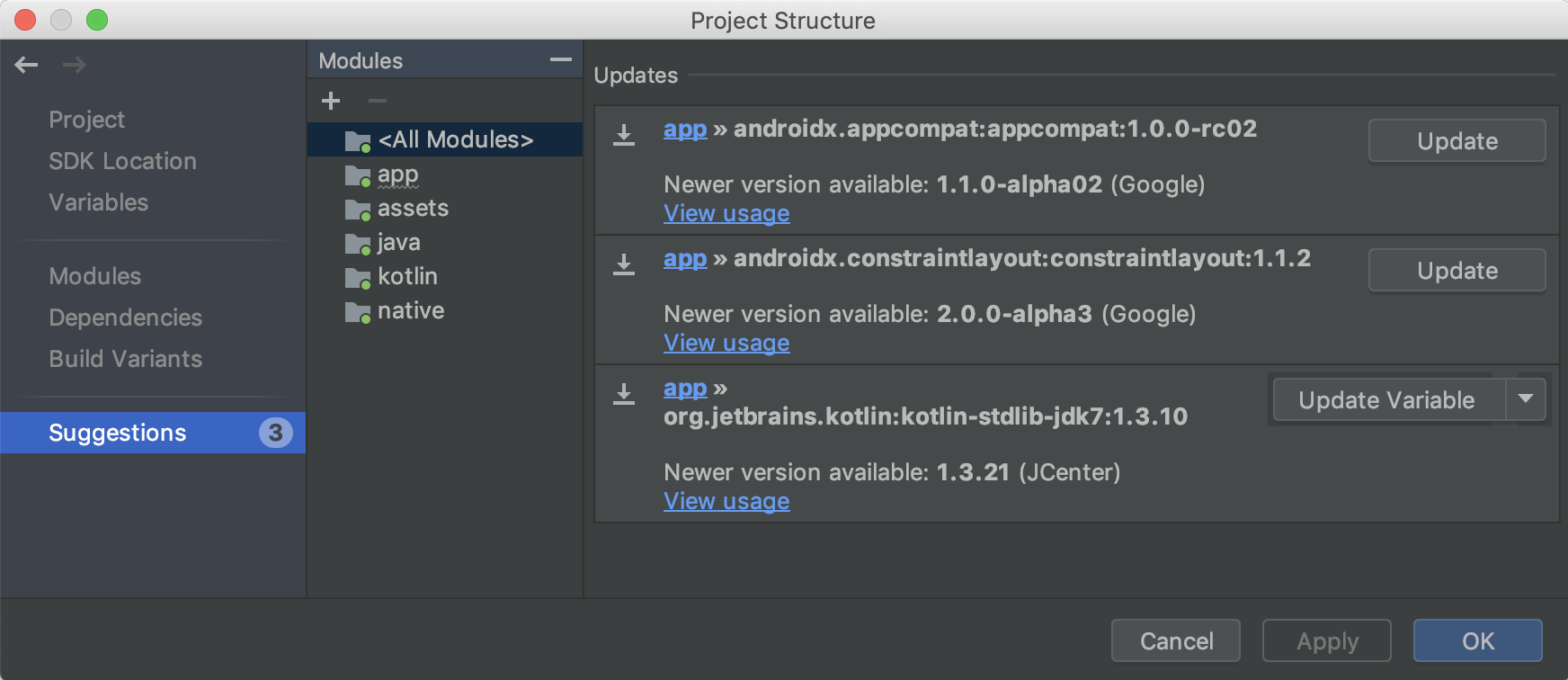
নতুন রিসোর্স ম্যানেজার
রিসোর্স ম্যানেজার হল আপনার অ্যাপে রিসোর্স আমদানি, তৈরি, পরিচালনা এবং ব্যবহারের জন্য একটি নতুন টুল উইন্ডো। আপনি মেনু বার থেকে ভিউ > টুল উইন্ডোজ > রিসোর্স ম্যানেজার নির্বাচন করে টুল উইন্ডোটি খুলতে পারেন। রিসোর্স ম্যানেজার আপনাকে নিম্নলিখিতগুলি করতে দেয়:
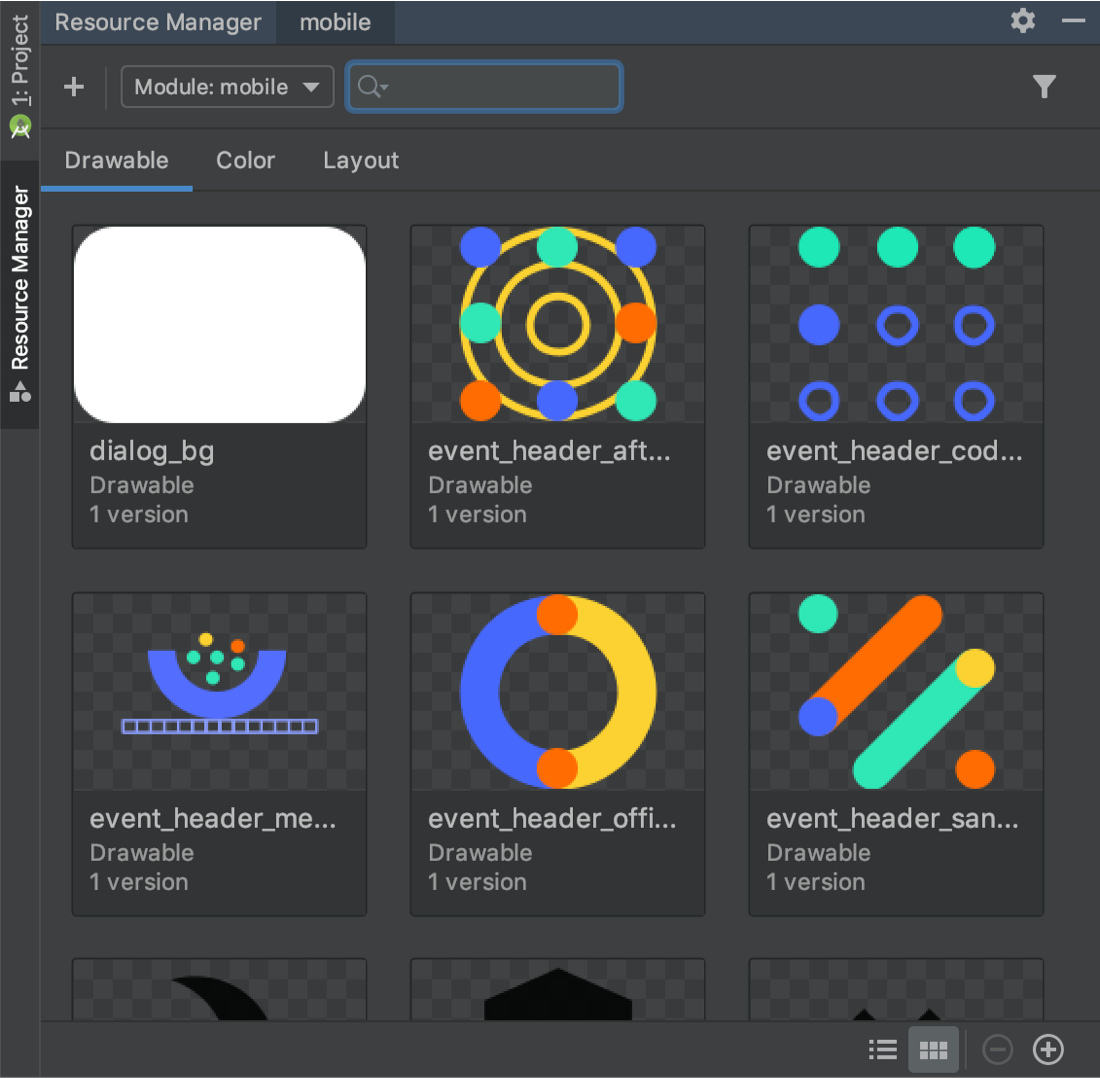
- রিসোর্স ভিজ্যুয়ালাইজ করুন: আপনার প্রয়োজনীয় রিসোর্সগুলি দ্রুত খুঁজে পেতে আপনি অঙ্কনযোগ্য, রঙ এবং লেআউটগুলির পূর্বরূপ দেখতে পারেন।
- বাল্ক ইম্পোর্ট: আপনি রিসোর্স ম্যানেজার টুল উইন্ডোতে টেনে এনে অথবা ইম্পোর্ট ড্রয়েবলস উইজার্ড ব্যবহার করে একসাথে একাধিক ড্রয়েবল অ্যাসেট আমদানি করতে পারেন। উইজার্ডটি অ্যাক্সেস করতে, টুল উইন্ডোর উপরের-বাম কোণে (+) বোতামটি নির্বাচন করুন এবং তারপর ড্রপ ডাউন মেনু থেকে ইম্পোর্ট ড্রয়েবলস নির্বাচন করুন।
- SVG গুলিকে
VectorDrawableঅবজেক্টে রূপান্তর করুন: আপনি আপনার SVG ছবিগুলিকেVectorDrawableঅবজেক্টে রূপান্তর করতে Import Drawables উইজার্ড ব্যবহার করতে পারেন। - ড্র্যাগ অ্যান্ড ড্রপ অ্যাসেট: রিসোর্স ম্যানেজার টুল উইন্ডো থেকে, আপনি লেআউট এডিটরের ডিজাইন এবং XML ভিউ উভয়ের উপর ড্র্যাগ অ্যান্ড ড্রপ করতে পারেন।
- বিকল্প সংস্করণ দেখুন: আপনি এখন টুল উইন্ডোর মধ্যে থাকা কোনও রিসোর্সে ডাবল-ক্লিক করে আপনার রিসোর্সের বিকল্প সংস্করণগুলি দেখতে পারেন। এই ভিউটি আপনার তৈরি করা বিভিন্ন সংস্করণ এবং অন্তর্ভুক্ত করা কোয়ালিফায়ারগুলি দেখায়।
- টাইল এবং তালিকার দৃশ্য: আপনি বিভিন্ন বিন্যাসে আপনার সম্পদগুলি কল্পনা করতে টুল উইন্ডোর মধ্যে দৃশ্য পরিবর্তন করতে পারেন।
আরও জানতে, অ্যাপ রিসোর্সগুলি কীভাবে পরিচালনা করবেন সে সম্পর্কে নির্দেশিকাটি পড়ুন।
APK প্রোফাইলিং এবং ডিবাগ করার সময় বিল্ড আইডি পরীক্ষা করা হচ্ছে
যখন আপনি আপনার APK-এর ভিতরে .so শেয়ার্ড লাইব্রেরির জন্য ডিবাগিং সিম্বল ফাইল প্রদান করেন, তখন Android স্টুডিও যাচাই করে যে প্রদত্ত সিম্বল ফাইলগুলির বিল্ড আইডি APK-এর ভিতরে .so লাইব্রেরির বিল্ড আইডির সাথে মেলে।
যদি আপনি আপনার APK-তে একটি বিল্ড আইডি দিয়ে নেটিভ লাইব্রেরি তৈরি করেন, তাহলে অ্যান্ড্রয়েড স্টুডিও আপনার প্রতীক ফাইলের বিল্ড আইডি আপনার নেটিভ লাইব্রেরির বিল্ড আইডির সাথে মেলে কিনা তা পরীক্ষা করে এবং যদি কোনও অমিল থাকে তবে প্রতীক ফাইলগুলি প্রত্যাখ্যান করে। যদি আপনি একটি বিল্ড আইডি দিয়ে তৈরি না করে থাকেন, তাহলে ভুল প্রতীক ফাইল সরবরাহ করলে ডিবাগিংয়ে সমস্যা হতে পারে।
ডিফল্টরূপে R8 সক্রিয় করা হয়েছে
R8 এক ধাপে ডিসাগারিং, সঙ্কুচিতকরণ, অস্পষ্টকরণ, অপ্টিমাইজেশন এবং ডেক্সিং-কে একীভূত করে—যার ফলে বিল্ড পারফরম্যান্সের লক্ষণীয় উন্নতি ঘটে । R8 অ্যান্ড্রয়েড গ্রেডল প্লাগইন 3.3.0-এ চালু করা হয়েছিল এবং এখন প্লাগইন 3.4.0 এবং উচ্চতর সংস্করণ ব্যবহার করে অ্যাপ এবং অ্যান্ড্রয়েড লাইব্রেরি প্রকল্প উভয়ের জন্যই ডিফল্টরূপে সক্ষম।
নীচের ছবিটি R8 চালু হওয়ার আগে কম্পাইল প্রক্রিয়ার একটি উচ্চ-স্তরের ওভারভিউ প্রদান করে।

এখন, R8 এর সাহায্যে, ডিসুগারিং, সঙ্কুচিতকরণ, অস্পষ্টকরণ, অপ্টিমাইজেশন এবং ডেক্সিং (D8) সবই এক ধাপে সম্পন্ন হয়, যেমনটি নীচে দেখানো হয়েছে।

মনে রাখবেন, R8 আপনার বিদ্যমান ProGuard নিয়মগুলির সাথে কাজ করার জন্য ডিজাইন করা হয়েছে, তাই R8 থেকে উপকৃত হওয়ার জন্য আপনাকে সম্ভবত কোনও পদক্ষেপ নেওয়ার প্রয়োজন হবে না। তবে, যেহেতু এটি ProGuard থেকে আলাদা একটি প্রযুক্তি যা বিশেষভাবে Android প্রকল্পগুলির জন্য ডিজাইন করা হয়েছে, তাই সঙ্কুচিত এবং অপ্টিমাইজেশনের ফলে এমন কোড সরানো হতে পারে যা ProGuard-এর কাছে নাও থাকতে পারে। তাই, এই অপ্রত্যাশিত পরিস্থিতিতে, আপনার বিল্ড আউটপুটে সেই কোডটি রাখার জন্য আপনাকে অতিরিক্ত নিয়ম যোগ করতে হতে পারে।
যদি আপনার R8 ব্যবহারে কোনও সমস্যা হয়, তাহলে আপনার সমস্যার সমাধান আছে কিনা তা পরীক্ষা করার জন্য R8 সামঞ্জস্যতা সম্পর্কিত FAQ পড়ুন। যদি কোনও সমাধান নথিভুক্ত না থাকে, তাহলে দয়া করে একটি বাগ রিপোর্ট করুন । আপনার প্রকল্পের gradle.properties ফাইলে নিম্নলিখিত লাইনগুলির মধ্যে একটি যোগ করে আপনি R8 অক্ষম করতে পারেন:
# Disables R8 for Android Library modules only.
android.enableR8.libraries = false
# Disables R8 for all modules.
android.enableR8 = false
দ্রষ্টব্য: একটি নির্দিষ্ট বিল্ড টাইপের জন্য, যদি আপনি আপনার অ্যাপ মডিউলের build.gradle ফাইলে useProguard কে false এ সেট করেন, তাহলে Android Gradle প্লাগইনটি আপনার প্রোজেক্টের gradle.properties ফাইলে R8 অক্ষম করুন না কেন, সেই বিল্ড টাইপের জন্য আপনার অ্যাপের কোড সঙ্কুচিত করতে R8 ব্যবহার করে।
নেভিগেশন এডিটর এখন সকল ধরণের আর্গুমেন্ট সমর্থন করে
নেভিগেশন কম্পোনেন্ট দ্বারা সমর্থিত সকল আর্গুমেন্ট টাইপ এখন নেভিগেশন এডিটরে সমর্থিত। সমর্থিত টাইপ সম্পর্কে আরও তথ্যের জন্য, গন্তব্যস্থলের মধ্যে ডেটা পাস করুন দেখুন।
লেআউট এডিটরের উন্নতি {:#layout-editor}
লেআউট এডিটরের অ্যাট্রিবিউটস প্যানটি একটি একক পৃষ্ঠায় স্ট্রিমলাইন করা হয়েছে যেখানে আপনি এমন বিভাগগুলি প্রসারিত করতে পারেন যা আপনি কনফিগার করতে পারেন এমন অ্যাট্রিবিউটগুলি প্রকাশ করতে পারে। অ্যাট্রিবিউটস প্যানে নিম্নলিখিত আপডেটগুলিও অন্তর্ভুক্ত রয়েছে:
- একটি নতুন ঘোষিত বৈশিষ্ট্য বিভাগে লেআউট ফাইলটি নির্দিষ্ট করে এমন বৈশিষ্ট্যগুলি তালিকাভুক্ত করা হয়েছে এবং আপনাকে দ্রুত নতুন বৈশিষ্ট্য যুক্ত করতে দেয়।
- অ্যাট্রিবিউটস প্যানে এখন প্রতিটি অ্যাট্রিবিউটের পাশে এমন সূচকও রয়েছে যা অ্যাট্রিবিউটের মান একটি রিসোর্স রেফারেন্স হলে কঠিন থাকে এবং অন্যথায় খালি থাকে।
- ত্রুটি বা সতর্কতা সহ বৈশিষ্ট্যগুলি এখন হাইলাইট করা হয়েছে। লাল হাইলাইটগুলি ত্রুটিগুলি নির্দেশ করে (উদাহরণস্বরূপ, যখন আপনি অবৈধ লেআউট মান ব্যবহার করেন) এবং কমলা হাইলাইটগুলি সতর্কতাগুলি নির্দেশ করে (উদাহরণস্বরূপ, যখন আপনি হার্ড-কোডেড মান ব্যবহার করেন)।
দ্রুত নির্ভরতা আমদানির জন্য নতুন উদ্দেশ্যমূলক পদক্ষেপ
যদি আপনি আপনার কোডে নির্দিষ্ট কিছু Jetpack এবং Firebase ক্লাস ব্যবহার শুরু করেন, তাহলে একটি নতুন ইন্টেন্টেশন অ্যাকশন আপনার প্রোজেক্টে প্রয়োজনীয় Gradle লাইব্রেরি ডিপেন্ডেন্সি যোগ করার পরামর্শ দেয়, যদি আপনি ইতিমধ্যেই তা না করে থাকেন। উদাহরণস্বরূপ, যদি আপনি প্রথমে প্রয়োজনীয় android.arch.work:work-runtime ডিপেন্ডেন্সি আমদানি না করে WorkManager ক্লাসটি উল্লেখ করেন, তাহলে একটি ইন্টেন্টেশন অ্যাকশন আপনাকে নীচে দেখানো হিসাবে এক ক্লিকেই এটি সহজেই করতে দেয়।
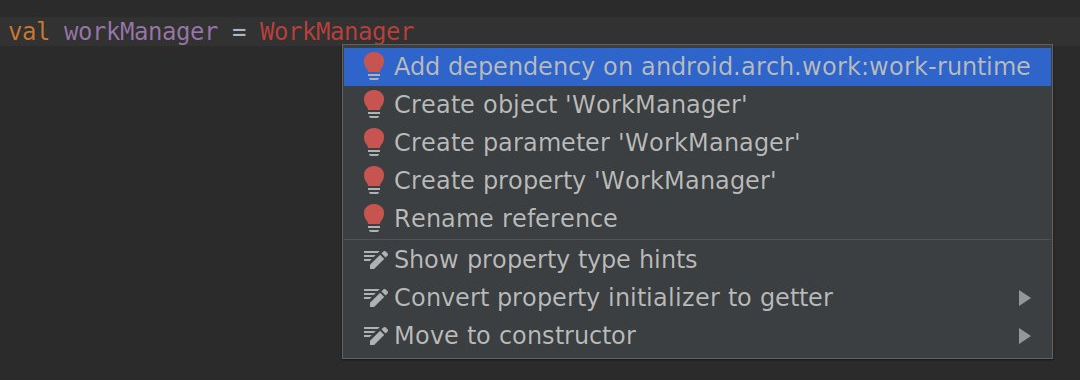
বিশেষ করে, যেহেতু জেটপ্যাক সাপোর্ট লাইব্রেরিটিকে বিচ্ছিন্ন প্যাকেজগুলিতে পুনরায় প্যাকেজ করেছে যা পরিচালনা এবং আপডেট করা সহজ, এই উদ্দেশ্যমূলক ক্রিয়াটি আপনাকে দ্রুত কেবলমাত্র জেটপ্যাক উপাদানগুলির জন্য প্রয়োজনীয় নির্ভরতাগুলি যুক্ত করতে সহায়তা করে যা আপনি ব্যবহার করতে চান।
৩.৩ (জানুয়ারী ২০১৯)
অ্যান্ড্রয়েড স্টুডিও ৩.৩ একটি প্রধান রিলিজ যাতে বিভিন্ন ধরণের নতুন বৈশিষ্ট্য এবং উন্নতি অন্তর্ভুক্ত রয়েছে।
৩.৩.২ (মার্চ ২০১৯)
এই ছোটখাটো আপডেটে বিভিন্ন বাগ সংশোধন এবং কর্মক্ষমতা উন্নতি অন্তর্ভুক্ত রয়েছে। উল্লেখযোগ্য বাগ সংশোধনের তালিকা দেখতে, রিলিজ আপডেট ব্লগে সম্পর্কিত পোস্টটি পড়ুন।
৩.৩.১ (ফেব্রুয়ারী ২০১৯)
এই ছোটখাটো আপডেটে বিভিন্ন বাগ সংশোধন এবং কর্মক্ষমতা উন্নতি অন্তর্ভুক্ত রয়েছে।
ইন্টেলিজে আইডিয়া ২০১৮.২.২
২০১৮.২.২ রিলিজের মাধ্যমে IntelliJ IDEA থেকে উন্নত বৈশিষ্ট্যের মাধ্যমে মূল অ্যান্ড্রয়েড স্টুডিও IDE আপডেট করা হয়েছে।
অ্যান্ড্রয়েড গ্রেডল প্লাগইন আপডেট
অ্যান্ড্রয়েড গ্রেডল প্লাগইনে নতুন কী আছে সে সম্পর্কে তথ্যের জন্য, এর রিলিজ নোটগুলি দেখুন।
নেভিগেশন সম্পাদক
নেভিগেশন এডিটর আপনাকে নেভিগেশন আর্কিটেকচার কম্পোনেন্ট ব্যবহার করে আপনার অ্যাপে দ্রুত নেভিগেশন কল্পনা এবং তৈরি করতে দেয়।
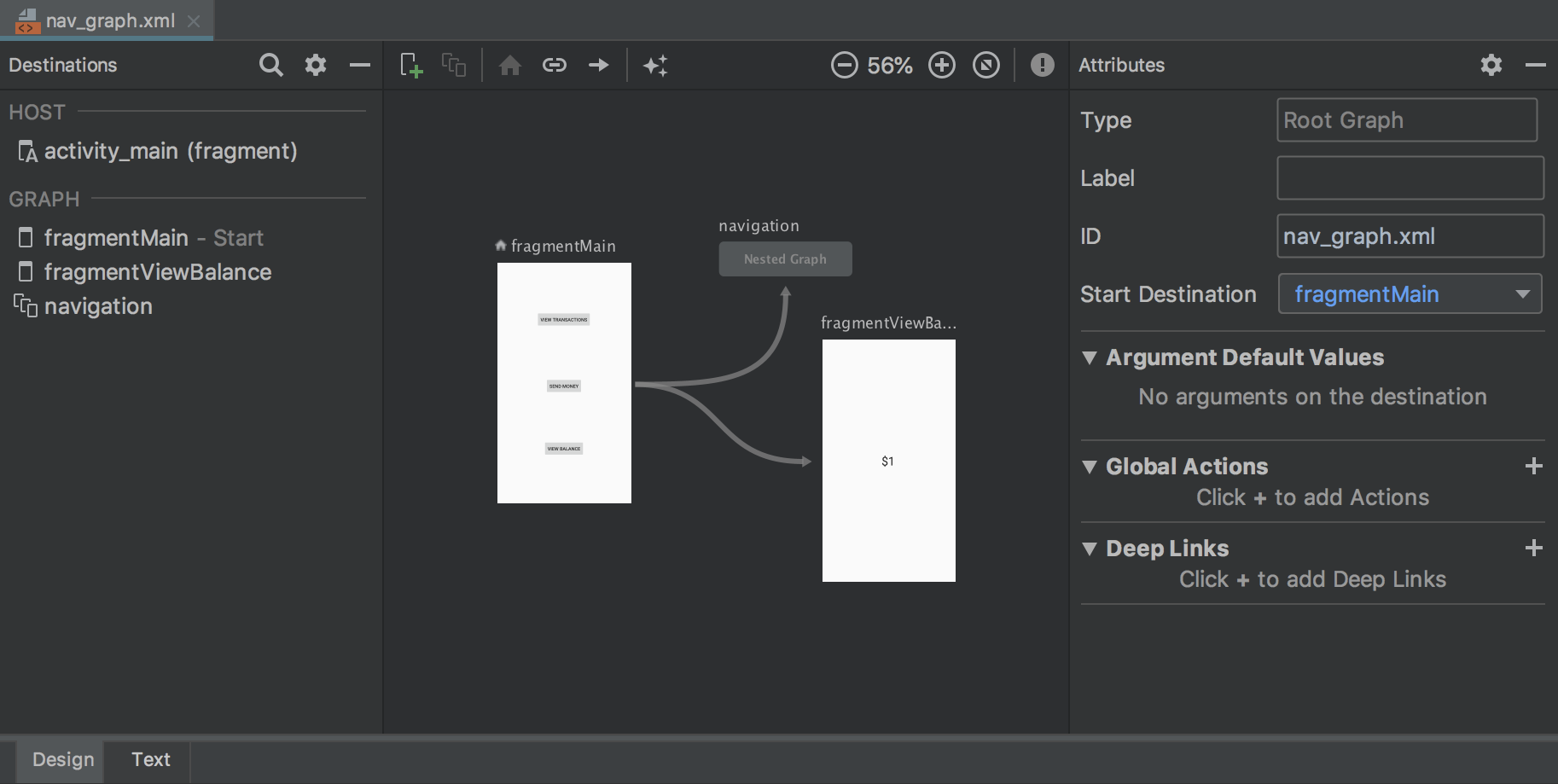
আরও তথ্যের জন্য, নেভিগেশন আর্কিটেকচার কম্পোনেন্টের সাহায্যে নেভিগেশন বাস্তবায়ন দেখুন।
অব্যবহৃত অ্যান্ড্রয়েড স্টুডিও ডিরেক্টরিগুলি মুছুন
যখন আপনি প্রথমবারের মতো অ্যান্ড্রয়েড স্টুডিওর একটি প্রধান সংস্করণ চালান, তখন এটি অ্যান্ড্রয়েড স্টুডিওর এমন সংস্করণগুলির জন্য ক্যাশে, সেটিংস, সূচক এবং লগ ধারণকারী ডিরেক্টরিগুলি অনুসন্ধান করে যার জন্য সংশ্লিষ্ট ইনস্টলেশন খুঁজে পাওয়া যায় না। এরপর ডিলিট আনইউজড অ্যান্ড্রয়েড স্টুডিও ডিরেক্টরিগুলি ডায়ালগটি এই অব্যবহৃত ডিরেক্টরিগুলির অবস্থান, আকার এবং সর্বশেষ সংশোধিত সময় প্রদর্শন করে এবং সেগুলি মুছে ফেলার একটি বিকল্প প্রদান করে।
অ্যান্ড্রয়েড স্টুডিও যে ডিরেক্টরিগুলি মুছে ফেলার জন্য বিবেচনা করে তা নীচে তালিকাভুক্ত করা হয়েছে:
- লিনাক্স:
~/.AndroidStudio[Preview] XY - ম্যাক:
~/Library/{Preferences, Caches, Logs, Application Support}/AndroidStudio[Preview] XY - উইন্ডোজ:
%USER%.AndroidStudio[Preview] XY
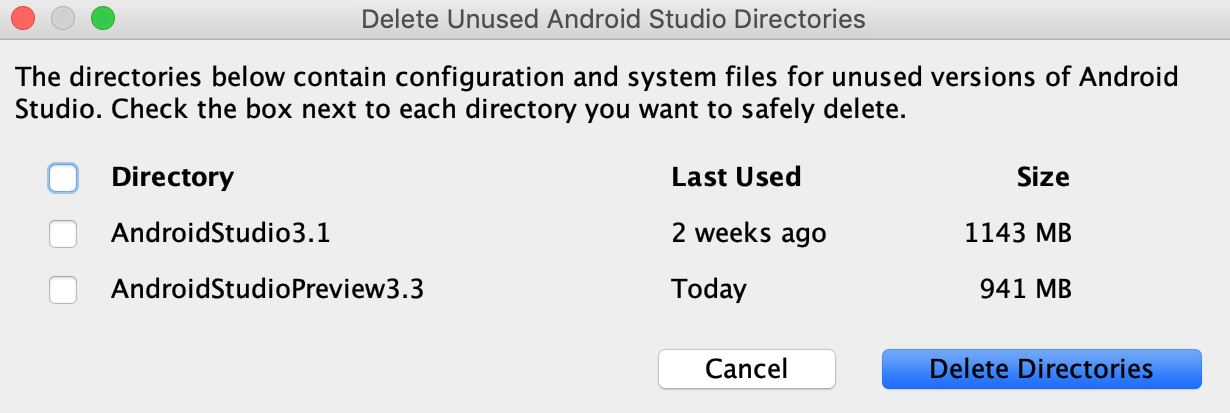
লিন্টের উন্নতি
গ্র্যাডেল থেকে লিন্ট ব্যবহার করা হলে তা উল্লেখযোগ্যভাবে দ্রুততর হয়—বড় প্রকল্পগুলিতে লিন্ট চারগুণ দ্রুত গতিতে কাজ করবে বলে আশা করা যায়।
নতুন প্রজেক্ট উইজার্ড তৈরি করুন
নতুন প্রকল্প তৈরি করুন উইজার্ডটি একটি নতুন চেহারা পেয়েছে এবং এতে এমন আপডেট রয়েছে যা নতুন অ্যান্ড্রয়েড স্টুডিও প্রকল্প তৈরিকে সহজতর করতে সহায়তা করে।
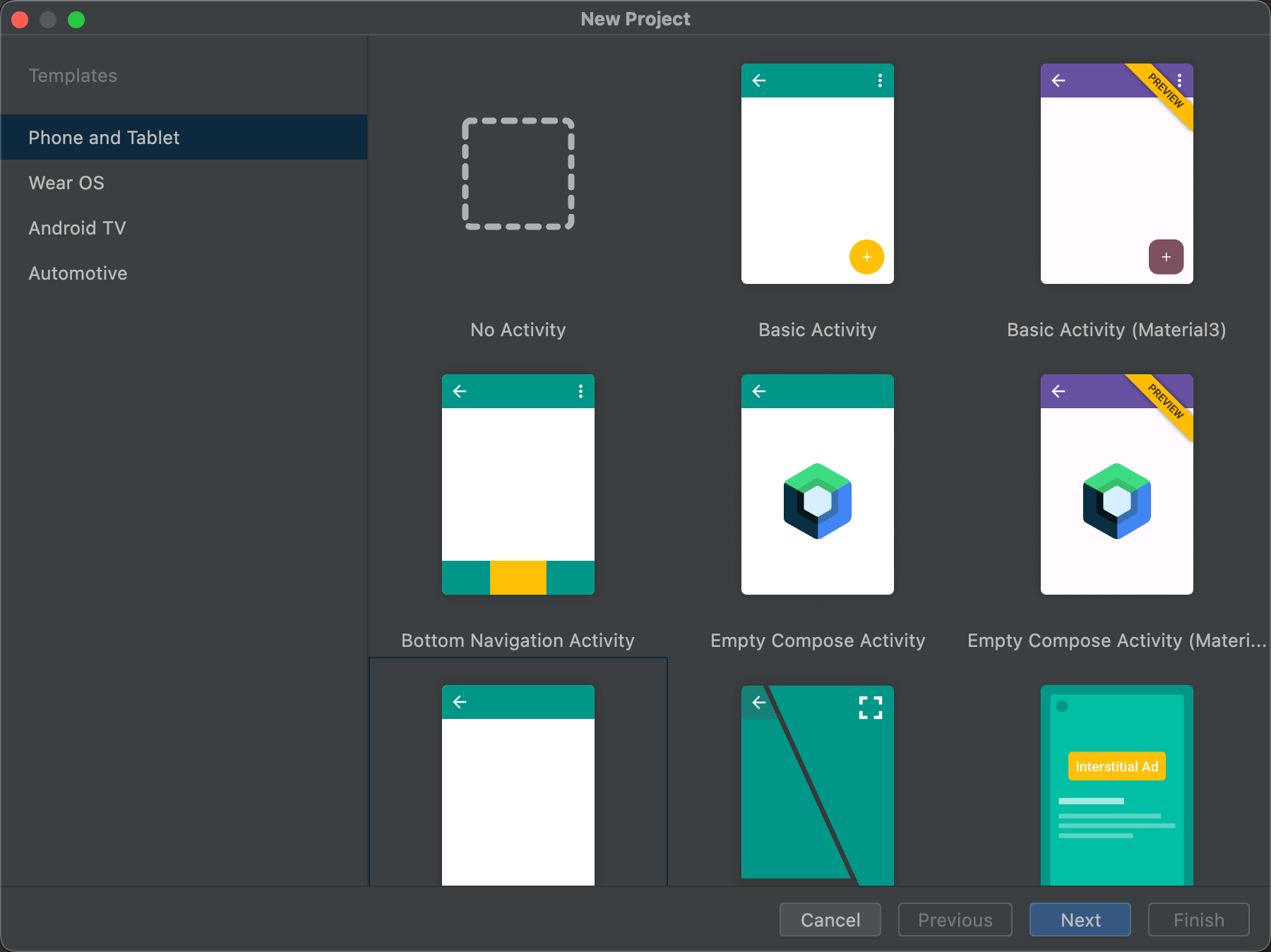
আরও তথ্যের জন্য, একটি প্রকল্প তৈরি করুন দেখুন।
প্রোফাইলার আপডেট
অ্যান্ড্রয়েড স্টুডিও ৩.৩-তে বেশ কয়েকটি পৃথক প্রোফাইলারের আপডেট অন্তর্ভুক্ত রয়েছে।
উন্নত কর্মক্ষমতা
ব্যবহারকারীর প্রতিক্রিয়ার উপর ভিত্তি করে, প্রোফাইলার ব্যবহার করার সময় রেন্ডারিং কর্মক্ষমতা অনেক উন্নত হয়েছে। অনুগ্রহ করে প্রতিক্রিয়া প্রদান চালিয়ে যান, বিশেষ করে যদি আপনি কর্মক্ষমতা সংক্রান্ত সমস্যা দেখতে পান।
প্রোফাইলার মেমরি বরাদ্দ ট্র্যাকিং বিকল্পগুলি
প্রোফাইলিং করার সময় অ্যাপের কর্মক্ষমতা উন্নত করার জন্য, মেমরি প্রোফাইলার এখন ডিফল্টভাবে পর্যায়ক্রমে মেমরি বরাদ্দের নমুনা নেয়। যদি ইচ্ছা হয়, তাহলে আপনি Android 8.0 (API লেভেল 26) বা তার বেশি চলমান ডিভাইসগুলিতে পরীক্ষা করার সময় বরাদ্দ ট্র্যাকিং ড্রপডাউন ব্যবহার করে এই আচরণটি পরিবর্তন করতে পারেন।
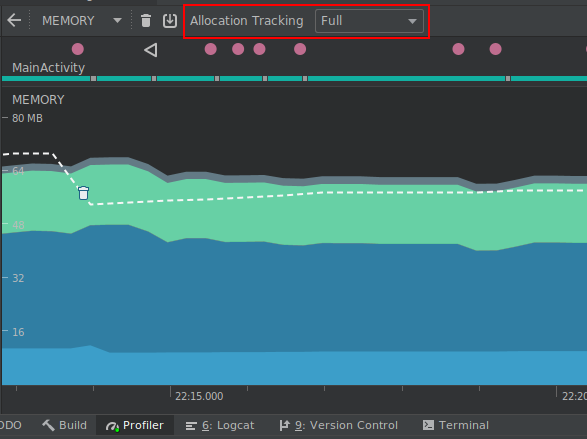
বরাদ্দ ট্র্যাকিং ড্রপডাউন ব্যবহার করে, আপনি নিম্নলিখিত মোডগুলি থেকে বেছে নিতে পারেন:
পূর্ণ: সমস্ত অবজেক্ট মেমোরি অ্যালোকেশন ক্যাপচার করে। মনে রাখবেন যে যদি আপনার এমন একটি অ্যাপ থাকে যা অনেক অবজেক্ট অ্যালোকেশন করে, তাহলে প্রোফাইলিং করার সময় আপনি উল্লেখযোগ্য পারফরম্যান্স সমস্যা দেখতে পেতে পারেন।
স্যাম্পল্ড: অবজেক্ট মেমোরি অ্যালোকেশনের একটি পর্যায়ক্রমিক নমুনা ক্যাপচার করে। এটি ডিফল্ট আচরণ এবং প্রোফাইলিংয়ের সময় অ্যাপের পারফরম্যান্সের উপর কম প্রভাব ফেলে। অল্প সময়ের মধ্যে অনেক অবজেক্ট অ্যালোকেশন করে এমন অ্যাপগুলির সাথে আপনি কিছু পারফরম্যান্স সমস্যার সম্মুখীন হতে পারেন।
বন্ধ: মেমোরি বরাদ্দ বন্ধ করে। যদি ইতিমধ্যেই নির্বাচিত না থাকে, তাহলে CPU রেকর্ডিং নেওয়ার সময় এই মোডটি স্বয়ংক্রিয়ভাবে সক্রিয় হয়ে যায় এবং রেকর্ডিং শেষ হলে পূর্ববর্তী সেটিংয়ে ফিরে আসে। আপনি CPU রেকর্ডিং কনফিগারেশন ডায়ালগে এই আচরণটি পরিবর্তন করতে পারেন।
ট্র্যাকিং জাভা অবজেক্ট এবং JNI রেফারেন্স উভয়কেই প্রভাবিত করে।
ফ্রেম রেন্ডারিং ডেটা পরীক্ষা করুন
In the CPU Profiler , you can now inspect how long it takes your Java app to render each frame on the main UI thread and RenderThread. This data might be useful when investigating bottlenecks that cause UI jank and low framerates. For example, each frame that takes longer than the 16ms required to maintain a smooth framerate is displayed in red.
To see frame rendering data, record a trace using a configuration that allows you to Trace System Calls . After recording the trace, look for info about each frame along the timeline for the recording under the section called FRAMES , as shown below.
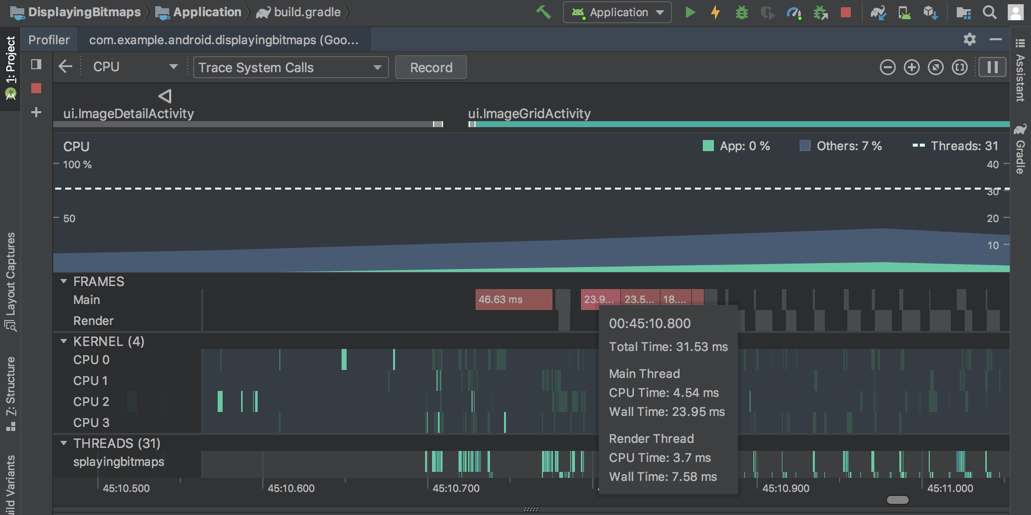
To learn more about investigating and fixing framerate issues, read Slow rendering .
Fragments in the event timeline
The event timeline now shows when fragments are attached and detached. Additionally, when you hover over a fragment, a tooltip shows you the fragment status.

View formatted text for connection payloads in the Network profiler
Previously, the Network profiler displayed only raw text from connection payloads. Android Studio 3.3 now formats certain text types by default, including JSON, XML, and HTML. In the Response and Request tabs, click the View Parsed link to display formatted text, and click the View Source link to display raw text.
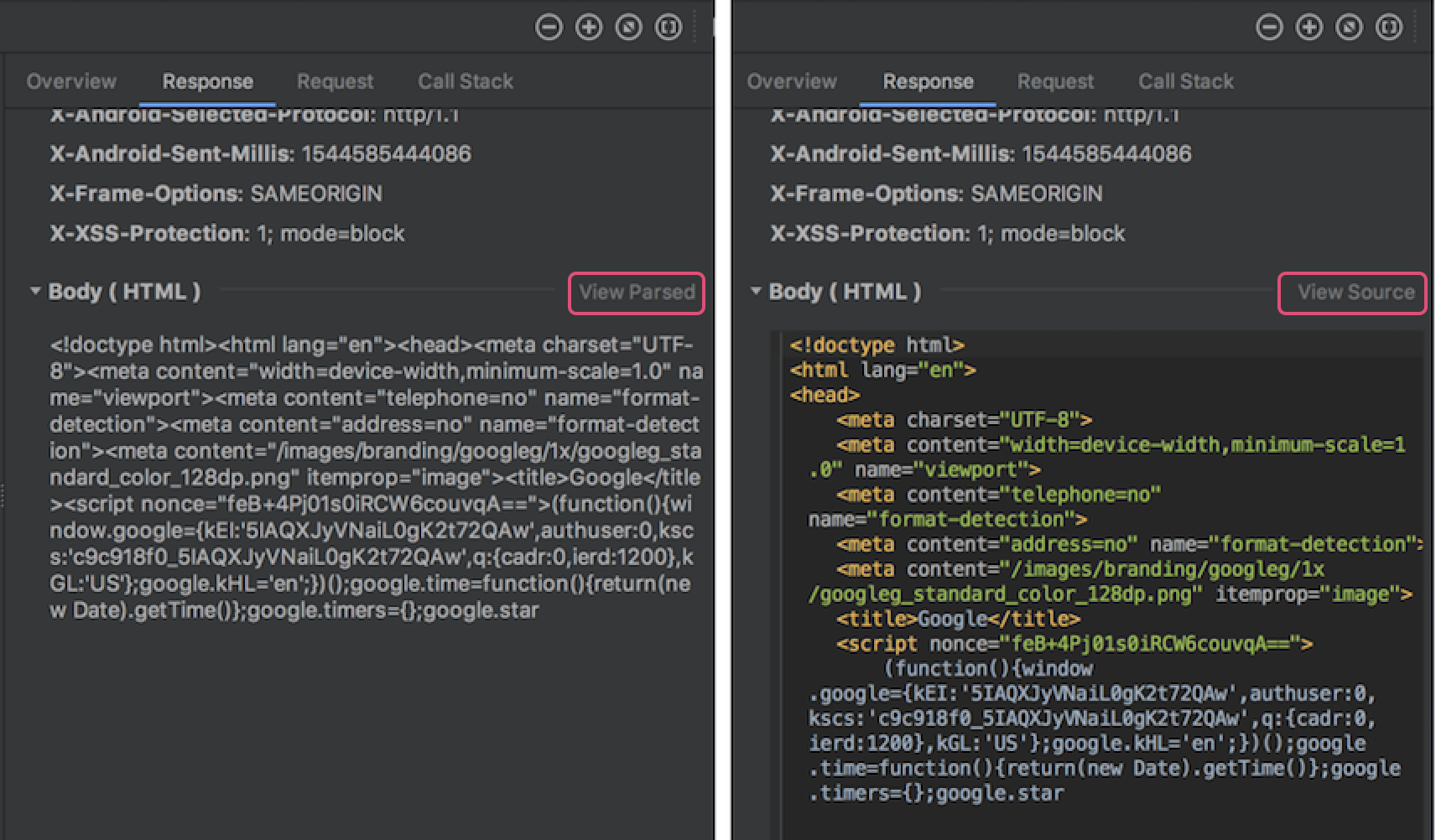
For more information, see Inspect network traffic with Network Profiler .
Automatic downloading of SDK components
When your project needs an SDK component from the SDK platforms, NDK, or CMake, Gradle now attempts to automatically download the required packages as long as you've previously accepted any related license agreements using the SDK Manager.
For more information, see Auto-download missing packages with Gradle .
Support for Clang-Tidy
Android Studio now includes support for static code analysis using Clang-Tidy for projects that include native code. To enable support for Clang-Tidy, update your NDK to r18 or higher.
You can then enable or re-enable the inspections by opening the Settings or Preferences dialog and navigating to Editor > Inspections > C/C++ > General > Clang-Tidy . When selecting this inspection in the Settings or Preferences dialog, you can also see the list of Clang-Tidy checks that are enabled and disabled under the Option section of the right-most panel. To enable additional checks , add them to the list and click Apply .
To configure Clang-Tidy with additional options , click Configure Clang-Tidy Checks Options and add them in the dialog that opens.
Removal of options for C++ customization
The following options have been removed from the Customize C++ Support dialog:
- Exceptions Support (-fexceptions)
- Runtime Type Information Support (-ftti)
The respective behaviors are enabled for all projects created through Android Studio.
CMake version 3.10.2
CMake version 3.10.2 is now included with SDK Manager. Note that Gradle still uses version 3.6.0 by default.
To specify a CMake version for Gradle to use, add the following to your module's build.gradle file:
android {
...
externalNativeBuild {
cmake {
...
version "3.10.2"
}
}
}
For more information on configuring CMake in build.gradle , see Manually configure Gradle .
New “+” syntax to specify minimum CMake versions
When specifying a version of CMake in your main module's build.gradle file, you can now append a “+” to match the behavior of CMake's cmake_minimum_required() command.
Caution: Using "+" syntax with other build dependencies is discouraged, as dynamic dependencies can cause unexpected version updates and difficulty resolving version differences.
Android App Bundles now support Instant Apps
Android Studio now lets you build Android App Bundles with full support for Google Play Instant . In other words, you can now build and deploy both installed app and instant experiences from a single Android Studio project and include them in a single Android App Bundle.
If you're creating a new Android Studio project using the Create New Project dialog, make sure you check the box next to Configure your project > This project will support instant apps . Android Studio then creates a new app project as it normally would, but includes the following properties in your manifest to add Instant app support to your app's base module:
<manifest ... xmlns:dist="http://schemas.android.com/apk/distribution">
<dist:module dist:instant="true" />
...
</manifest>
You can then create an instant-enabled feature module by selecting File > New > New Module from the menu bar and then selecting Instant Dynamic Feature Module from the Create New Module dialog. Keep in mind, creating this module also instant-enables your app's base module.
To deploy your app to a local device as an instant experience, edit your run configuration and check the box next to General > Deploy as instant app .
Single-variant project sync
Syncing your project with your build configuration is an important step in letting Android Studio understand how your project is structured. However, this process can be time-consuming for large projects. If your project uses multiple build variants, you can now optimize project syncs by limiting them to only the variant you have currently selected.
You need to use Android Studio 3.3 or higher with Android Gradle plugin 3.3.0 or higher to enable this optimization. When you meet these requirements, the IDE prompts you to enable this optimization when you sync your project. The optimization is also enabled by default on new projects.
To enable this optimization manually, click File > Settings > Experimental > Gradle ( Android Studio > Preferences > Experimental > Gradle on a Mac) and select the Only sync the active variant checkbox.
Note: This optimization currently supports projects that include only the Java programming language. If, for example, the IDE detects Kotlin or C++ code in your project, it does not automatically enable this optimization, and you should not enable it manually.
For more information, see Enable single-variant project sync .
Provide quick feedback
If you've opted into sharing usage statistics to help improve Android Studio, you'll see these two new icons in the status bar at the bottom of the IDE window:


Simply click the icon that best represents your current experience with the IDE. When you do so, the IDE sends usage statistics that allow the Android Studio team to better understand your sentiment. In some cases, such as when you indicate a negative experience with the IDE, you'll have an opportunity to provide additional feedback.
If you haven't already done so, you can enable sharing usage statistics by opening the Settings dialog Preferences on a Mac), navigating to Appearance & Behavior > System Settings > Data Sharing and checking Send usage statistics to Google .
3.2 (September 2018)
Android Studio 3.2 is a major release that includes a variety of new features and improvements.
3.2.1 (October 2018)
This update to Android Studio 3.2 includes the following changes and fixes:
- The bundled Kotlin version is now 1.2.71.
- The default build tools version is now 28.0.3.
- In the Navigation library, argument types have been renamed from
typetoargType. - The following bugs have been fixed:
- When using the Data Binding library, variable names with underscores were causing compilation errors.
- CMake was causing IntelliSense and other CLion features to fail.
- Adding a
SliceProviderwas causing compilation errors in projects that did not useandroidx.*libraries. - Some Kotlin unit tests were not being run.
- An issue with data binding was causing a
PsiInvalidElementAccessException. -
<merge>elements were sometimes causing the Layout Editor to crash.
3.2.0 known issues
Note: These issues have been resolved in Android Studio 3.2.1
We strongly recommend against using Kotlin version 1.2.70.
Kotlin version 1.2.61 fixes a bug that can cause Android Studio to hang, but Kotlin 1.2.70 does not include this fix .
Kotlin versions 1.2.71 and later, however, do include this fix.
Although you typically don't need to specify the build tools version, when using Android Gradle plugin 3.2.0 with
renderscriptSupportModeEnabledset totrue, you need to include the following in each module'sbuild.gradlefile:android.buildToolsVersion "28.0.3"
What's New Assistant
A new assistant informs you about the latest changes in Android Studio.
The assistant opens when you start Android Studio after a fresh installation or update if it detects that there is new information to show. You can also open the assistant by choosing Help > What's new in Android Studio .
Android Jetpack
Android Jetpack helps to accelerate Android development with components, tools, and guidance that eliminate repetitive tasks and enable you to more quickly and easily build high-quality, testable apps. Android Studio includes the following updates to support Jetpack. For more information, see the Jetpack documentation .
Navigation Editor
The new Navigation Editor integrates with the navigation components of Android Jetpack to provide a graphical view for creating the navigation structure of your app. The Navigation Editor simplifies the design and implementation of navigation between in-app destinations.
In Android Studio 3.2, the Navigation Editor is an experimental feature. To enable the Navigation Editor, click File > Settings ( Android Studio > Preferences on Mac), select the Experimental category in the left pane, check the box next to Enable Navigation Editor , and restart Android Studio.
To learn more, read the Navigation Editor documentation .
AndroidX migration
As part of Jetpack, we are migrating the Android Support Libraries to a new Android extension library using the androidx namespace. For more information, see the AndroidX overview .
Android Studio 3.2 helps you through this process with a new migration feature.
To migrate an existing project to AndroidX, choose Refactor > Migrate to AndroidX . If you have any Maven dependencies that have not migrated to the AndroidX namespace, the Android Studio build system also automatically converts those project dependencies.
The Android Gradle plugin provides the following global flags that you can set in your gradle.properties file:
-
android.useAndroidX: When set totrue, this flag indicates that you want to start using AndroidX from now on. If the flag is absent, Android Studio behaves as if the flag were set tofalse. -
android.enableJetifier: When set totrue, this flag indicates that you want to have tool support (from the Android Gradle plugin) to automatically convert existing third-party libraries as if they were written for AndroidX. If the flag is absent, Android Studio behaves as if the flag were set tofalse.
Both flags are set to true when you use the Migrate to AndroidX command.
If you want to start using AndroidX libraries immediately and don't need to convert existing third-party libraries, you can set the android.useAndroidX flag to true and the android.enableJetifier flag to false .
অ্যান্ড্রয়েড অ্যাপ বান্ডেল
Android App Bundle is a new upload format that includes all of your app's compiled code and resources, but defers APK generation and signing to the Google Play Store.
Google Play's new app serving model then uses your app bundle to generate and serve optimized APKs for each user's device configuration, so each user downloads only the code and resources they need to run your app. You no longer need to build, sign, and manage multiple APKs, and users get smaller, more optimized downloads.
Additionally, you can add feature modules to your app project and include them in your app bundle. Your users can then download and install your app's features on demand.
To build a bundle, choose Build > Build Bundle(s) / APK(s) > Build Bundle(s) .
For more information, including instructions for building and analyzing an Android App Bundle, see Android App Bundle .
Sample data in Layout Editor
Many Android layouts have runtime data that can make it difficult to visualize the look and feel of a layout during the design stage of app development. You can now easily see a preview of your view in the Layout Editor filled with sample data. When you add a view, a button appears below the view in the Design window. Click this button to set the design-time view attributes. You can choose from a variety of sample data templates and specify the number of sample items with which to populate the view.
appears below the view in the Design window. Click this button to set the design-time view attributes. You can choose from a variety of sample data templates and specify the number of sample items with which to populate the view.
To try using sample data, add a RecyclerView to a new layout, click the design-time attributes button below the view, and choose a selection from the carousel of sample data templates.
below the view, and choose a selection from the carousel of sample data templates.
স্লাইস
Slices provide a new way to embed portions of your app's functionality in other user interface surfaces on Android. For example, Slices make it possible to show app functionality and content in Google Search suggestions.
Android Studio 3.2 has a built-in template to help you to extend your app with the new Slice Provider APIs, as well as new lint checks to ensure that you're following best practices when constructing the Slices.
To get started right-click a project folder and choose New > Other > Slice Provider .
To learn more, including how to test your Slice interactions, read the Slices getting started guide .
Kotlin 1.2.61
Android Studio 3.2 bundles Kotlin 1.2.61, and the new Android SDK integrates better with Kotlin. For more information, see the Android Developers blog .
IntelliJ IDEA 2018.1.6
The core Android Studio IDE has been updated with improvements from IntelliJ IDEA through the 2018.1.6 release .
Android profilers
Try the following new Android Profiler features in Android Studio 3.2.
সেশন
You can now save Profiler data as sessions to revisit and inspect later. The profiler keeps your session data until you restart the IDE.
When you record a method trace or capture a heap dump , the IDE adds that data (along with your app's network activity) as a separate entry to the current session, and you can easily switch back and forth between recordings to compare data.
System Trace
In the CPU Profiler , select the new System Trace configuration to inspect your device's system CPU and thread activity. This trace configuration is built on systrace and is useful for investigating system-level issues, such as UI jank.
While using this trace configuration, you can visually mark important code routines in the profiler timeline by instrumenting your C/C++ code with the native tracing API or your Java code with the Trace class.
Inspect JNI references in the Memory Profiler
If you deploy your app to a device running Android 8.0 (API level 26) or higher, you can now inspect memory allocations for your app's JNI code using the Memory Profiler .
While your app is running, select a portion of the timeline that you want to inspect and select JNI heap from the drop-down menu above the class list, as shown below. You can then inspect objects in the heap as you normally would and double-click objects in the Allocation Call Stack tab to see where the JNI references are allocated and released in your code.
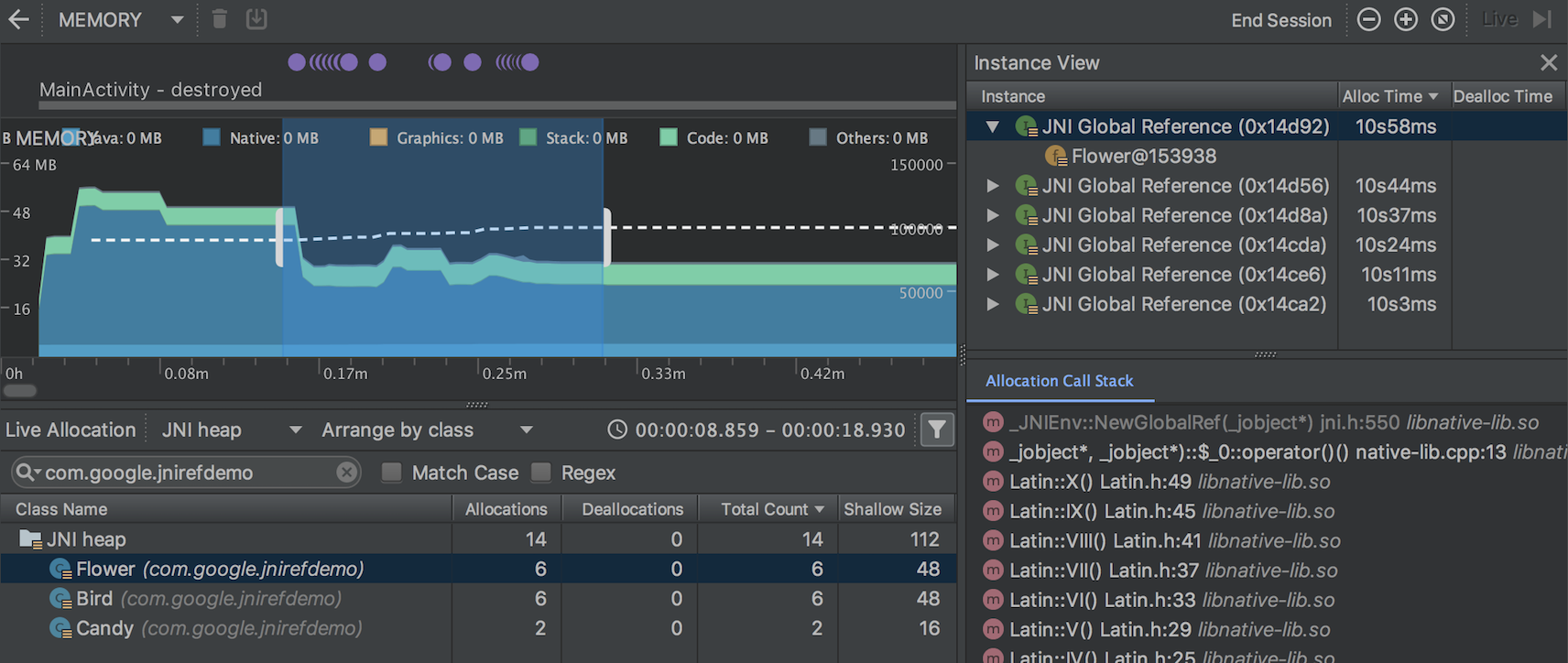
Import, export, and inspect memory heap dump files
You can now import, export, and inspect .hprof memory heap dump files created with the Memory Profiler .
Import your .hprof file by clicking Start new profiler session in the profiler's Sessions pane and then selecting Load from file . You can then inspect its data in the Memory Profiler as you would any other heap dump.
in the profiler's Sessions pane and then selecting Load from file . You can then inspect its data in the Memory Profiler as you would any other heap dump.
To save heap dump data to review later, use the Export Heap Dump button at the right of the Heap Dump entry in the Sessions pane. In the Export As dialog that appears, save the file with the .hprof filename extension.
Record CPU activity during app startup
You can now record CPU activity during your app's startup, as follows:
- Select Run > Edit Configurations from the main menu.
- Under the Profiling tab of your desired run configuration, check the box next to Start recording a method trace on startup .
- Select a CPU recording configuration to use from the dropdown menu.
- Deploy your app to a device running Android 8.0 (API level 26) or higher by selecting Run > Profile .
Export CPU traces
After you record CPU activity with the CPU Profiler, you can export the data as a .trace file to share with others or inspect later.
To export a trace after you've recorded CPU activity, do the following:
- Right-click on the recording you want to export from the CPU timeline.
- Select Export trace from the dropdown menu.
- Navigate to where you want to save the file and click Save .
Import and inspect CPU trace files
You can now import and inspect .trace files created with the Debug API or CPU Profiler . (Currently, you can't import System Trace recordings.)
Import your trace file by clicking Start new profiler session in the profiler's Sessions pane and then selecting Load from file . You can then inspect its data in the CPU Profiler similar to how you normally would, with the following exceptions:
in the profiler's Sessions pane and then selecting Load from file . You can then inspect its data in the CPU Profiler similar to how you normally would, with the following exceptions:
- CPU activity is not represented along the CPU timeline.
- The thread activity timeline indicates only where trace data is available for each thread and not actual thread states (such as running, waiting, or sleeping).
Record CPU activity using the Debug API
You can now start and stop recording CPU activity in the CPU Profiler by instrumenting your app with the Debug API . After you deploy your app to a device, the profiler automatically starts recording CPU activity when your app calls startMethodTracing(String tracePath) , and the profiler stops recording when your app calls stopMethodTracing() . While recording CPU activity that's triggered using this API, the CPU Profiler shows Debug API as the selected CPU recording configuration.
Energy Profiler
The Energy Profiler displays a visualization of the estimated energy usage of your app, as well as system events that affect energy usage, such as wakelocks, alarms, and jobs.
The Energy Profiler appears as a new row at the bottom of the Profiler window when you run your app on a connected device or Android Emulator running Android 8.0 (API 26) or higher.
Click the Energy row to maximize the Energy Profiler view. Place your mouse pointer over a bar in the timeline to see a breakdown of energy use by CPU, network, and location (GPS) resources, as well as relevant system events.
System events that affect energy usage are indicated in the System timeline below the Energy timeline. Details of system events within the specified time range are shown in the event pane when you select a time range in the Energy timeline.
To see the call stack and other details for a system event, such as a wakelock, select it in the event pane. To go to the code responsible for a system event, double-click the entry in the call stack.
Lint checking
Android Studio 3.2 includes many new and improved features for lint checking .
The new lint checks help you to find and identify common code problems, ranging from warnings about potential usability issues to high-priority errors regarding potential security vulnerabilities.
Lint checks for Java/Kotlin interoperability
To make sure that your Java code interoperates well with your Kotlin code, new lint checks enforce the best practices described in the Kotlin Interop Guide . Examples of these checks include looking for the presence of Nullability annotations, use of Kotlin hard keywords, and placing lambda parameters last.
To enable these checks, click File > Settings ( Android Studio > Preferences on Mac) to open the Settings dialog, navigate to the Editor > Inspections > Android > Lint > Interoperability > Kotlin Interoperability section, and select the rules that you want to enable.
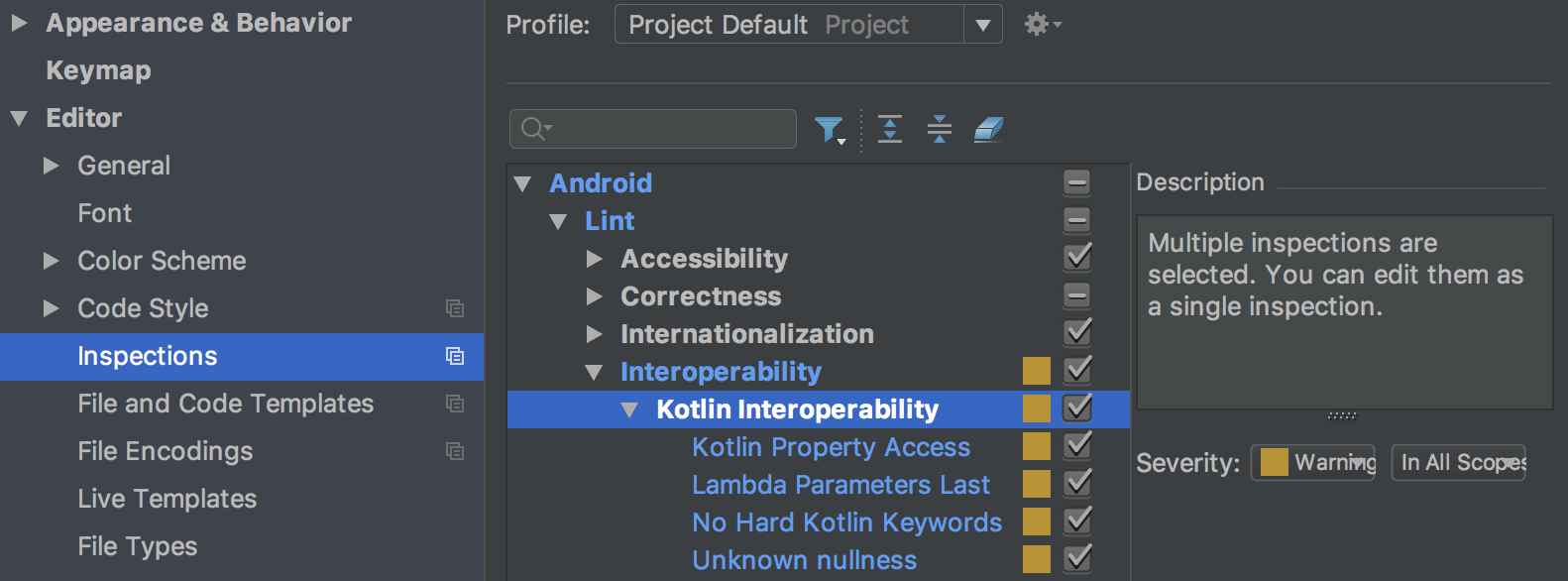
To enable these checks for command-line builds, add the following to your build.gradle file:
android {
lintOptions {
check 'Interoperability'
}
}
Lint checks for Slices
New lint checks for Slices help to ensure that you are constructing Slices correctly. For example, lint checks warn you if you have not assigned a primary action to a Slice.
New Gradle target
Use the new lintFix Gradle task to apply all of the safe fixes suggested by the lint check directly to the source code. An example of a lint check that suggests a safe fix to apply is SyntheticAccessor .
Metadata updates
Various metadata, such as the service cast check, have been updated for lint checks to work with Android 9 (API level 28).
Warning if running lint on a new variant
Lint now records which variant and version a baseline is recorded with, and lint warns you if you run it on a different variant than the one with which the baseline was created.
Improvements to existing lint checks
Android Studio 3.2 includes many improvements to existing lint checks. For example, the resource cycle checks now apply to additional resource types, and the translation detector can find missing translations on the fly, in the editor.
Issue IDs more discoverable
Issue IDs are now shown in more places now, including in the Inspection Results window. This makes it easier for you to find the information that you need to enable or disable specific checks through lintOptions in build.gradle .
For more information, see Configure lint options with Gradle .
Data Binding V2
Data Binding V2 is now enabled by default and is compatible with V1. This means that, if you have library dependencies that you compiled with V1, you can use them with projects using Data Binding V2. However, note that projects using V1 cannot consume dependencies that were compiled with V2.
D8 desugaring
In Android Studio 3.1, we integrated the desugaring step into the D8 tool as an experimental feature, reducing overall build time. In Android Studio 3.2, desugaring with D8 is turned on by default.
New code shrinker
R8 is a new tool for code shrinking and obfuscation that replaces ProGuard. You can start using the preview version of R8 by including the following in your project's gradle.properties file:
android.enableR8 = true
Changed default ABIs for multi-APKs
When building multiple APKs that each target a different ABI, the plugin no longer generates APKs for the following ABIs by default: mips , mips64 , and armeabi .
If you want to build APKs that target these ABIs, you must use NDK r16b or lower and specify the ABIs in your build.gradle file, as shown below:
splits { abi { include 'armeabi', 'mips', 'mips64' ... } }
splits { abi { include("armeabi", "mips", "mips64") ... } }
Note: This behavior change is also included in Android Studio 3.1 RC1 and higher.
Improved editor features for CMake build files
If you use CMake to add C and C++ code to your project , Android Studio now includes improved editor features to help you to edit your CMake build scripts, such as the following:
- Syntax highlighting and code completion: The IDE now highlights and suggests code completion for common CMake commands. Additionally, you can navigate to a file by clicking it while pressing the Control key (Command on Mac).
- Code reformatting: You can now use IntelliJ's code reformat option to apply code styles to your CMake build scripts.
- Safe refactoring: The IDE's built-in refactoring tools now also check if you are renaming or deleting files that you reference in your CMake build scripts.
Navigate external header files
When using the Project window in previous versions of Android Studio, you could navigate and inspect only the header files that belong to libraries you build from a local project. With this release, you can now also view and inspect header files included with external C/C++ library dependencies that you import into your app project.
If you already include C/C++ code and libraries in your project , open the Project window on the left side of the IDE by selecting View > Tool Windows > Project from the main menu and select Android from the drop-down menu. In the cpp directory, all headers that are within the scope of your app project are organized under the include node for each of your local C/C++ library dependencies, as shown below.
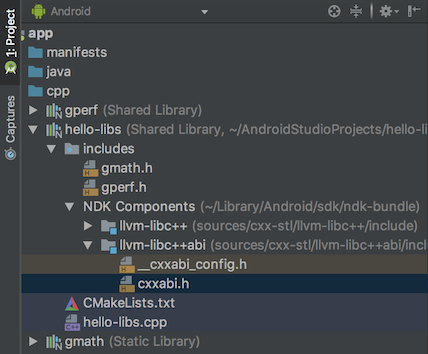
Native multidex enabled by default
Previous versions of Android Studio enabled native multidex when deploying the debug version of an app to a device running Android API level 21 or higher. Now, whether you're deploying to a device or building an APK for release, the Android plugin for Gradle enables native multidex for all modules that set minSdkVersion=21 or higher.
AAPT2 moved to Google's Maven repository
Beginning with Android Studio 3.2, the source for AAPT2 (Android Asset Packaging Tool 2) is Google's Maven repository.
To use AAPT2, make sure that you have a google() dependency in your build.gradle file, as shown here:
buildscript { repositories { google() // here jcenter() } dependencies { classpath 'com.android.tools.build:gradle:3.2.0' } } allprojects { repositories { google() // and here jcenter() } }
buildscript { repositories { google() // here jcenter() } dependencies { classpath("com.android.tools.build:gradle:3.2.0") } } allprojects { repositories { google() // and here jcenter() } }
The new version of AAPT2 fixes many issues, including improved handling of non-ASCII characters on Windows.
Removal of configuration on demand
The Configure on demand preference has been removed from Android Studio.
Android Studio no longer passes the --configure-on-demand argument to Gradle.
ADB Connection Assistant
The new ADB Connection Assistant provides step-by-step instructions to help you set up and use a device over the Android Debug Bridge (ADB) connection.
To start the assistant, choose Tools > Connection Assistant .
The ADB Connection Assistant provides instructions, in-context controls, and a list of connected devices in a series of pages in the Assistant panel.
Emulator improvements
You can now save and load snapshots of an AVD (Android virtual device) at any time in the Android Emulator, making it fast and easy to return an emulated device to a known state for testing. When you edit an AVD using the AVD Manager, you can specify which AVD snapshot to load when the AVD starts.
Controls for saving, loading, and managing AVD snapshots are now in the Snapshots tab in the emulator's Extended controls window.
For details, see Snapshots .
For additional information on what's new and changed in the Emulator, see the Emulator release notes .
3.1 (March 2018)
Android Studio 3.1.0 is a major release that includes a variety of new features and improvements.
3.1.4 (August 2018)
This update to Android Studio 3.1 includes the following changes and fixes:
- The bundled Kotlin is now version 1.2.50.
- New projects are created with
kotlin-stdlib-jdk* artifacts, rather than withkotlin-stdlib-jre*artifacts, which are deprecated. - R8 parsing of ProGuard rules has been improved.
- The following bugs have been fixed:
- Attempting to run the Kotlin Main class failed with an error:
"Error: Could not find or load main class..." - R8 entered an infinite loop while performing certain optimizations.
- Using the Rerun failed tests command in the Run window sometimes incorrectly returned the message "No tests were found".
- D8 did not correctly handle
invoke-virtualinstances, causing a crash with aVerifyError:invoke-super/virtual can't be used on private method - The Data Binding compiler was depending on an old version of
com.android.tools:annotations. The compiler now uses tools annotations from the base project when available. - Android Studio crashed during fragment transitions when using profilers.
- The debugger crashed when debugging a layout with a text box.
- D8 failed to read some ZIP files with special characters.
3.1.3 (June 2018)
This update to Android Studio 3.1 includes fixes for the following bugs:
- Memory leaks caused Android Studio to become slow and unresponsive after you had been using the Layout Editor. This update includes fixes for most of these issues. We intend to release another update soon to address additional memory leaks.
- Some applications built with D8 crashed on some Verizon Ellipsis tablets.
- Installation of applications built with D8 failed with an
INSTALL_FAILED_DEXOPTerror on devices running Android 5.0 or 5.1 (API level 21 or 22). - Some applications that used the OkHttp library and were built with D8 crashed on devices running Android 4.4 (API level 19).
- Android Studio sometimes failed to start, with a
ProcessCanceledExceptionduring class initialization forcom.intellij.psi.jsp.JspElementType.
3.1.2 (April 2018)
This update to Android Studio 3.1 includes fixes for the following bugs:
- In some cases, Android Studio hung indefinitely during exit.
Builds configured with source sets failed with the following message when Instant Run was enabled:
"The SourceSet name is not recognized by the Android Gradle Plugin."- When Instant Run was enabled, builds of new Kotlin projects failed when triggered by the Run command.
- During editing of the
build.gradlefile, there was sometimes a noticeable delay between typing a character and the character appearing on the screen. Build failures occurred during dexing in some projects with large numbers of modules or external dependencies, with the following error message:
"RejectedExecutionException: Thread limit exceeded replacing blocked worker"- The computation of the D8 main DEX list was not taking into account some reflective invocations.
This update also includes changes that make running lint checks from Gradle much faster in some scenarios.
3.1.1 (April 2018)
This update to Android Studio 3.1 includes fixes for the following bugs:
In some cases, when a project created in Android Studio 3.0 was opened for the first time in Android Studio 3.1, the Gradle-aware Make task was removed from the Before launch area in Run/Debug Configurations . The result was that projects did not build when the Run or Debug button was clicked, which in turn caused failures such as deployment of incorrect APKs and crashes when using Instant Run.
To solve this problem, Android Studio 3.1.1 adds the Gradle-aware Make task to the run configuration for projects that are missing this entry. This modification occurs after the first Gradle sync when the project is loaded.
- The debugger crashed when debugging a layout with a text box if advanced profiling was enabled.
- Android Studio froze after you clicked Build Variants .
- AAR (Android archive) files were extracted twice, once during the Gradle sync process and once during the Gradle build process.
- Elements were missing from some vector drawables imported from SVG files.
- The warning regarding the deprecation of the
compiledependency configuration has been updated with better guidance regarding theimplementationandapiconfigurations. For details of migrating away from using thecompileconfiguration, see the documentation for the new dependency configurations .
Coding/IDE
IntelliJ 2017.3.3
The core Android Studio IDE has been updated with improvements from IntelliJ IDEA through the 2017.3.3 release. Improvements include better control flow analysis for collections and strings, improved nullability inference, new quick fixes, and much more.
For details, see the JetBrains release notes for IntelliJ IDEA versions 2017.2 and 2017.3 , as well as the JetBrains release notes for bug-fix updates .
SQL editing improvements with Room
When you use the Room database library , you can take advantage of several improvements to SQL editing:
- Code completion within a
Queryunderstands SQL tables (entities), columns, query parameters, aliases, joins, subqueries, and WITH clauses. - SQL syntax highlighting now works.
- You can right-click a table name in SQL and rename it, which also rewrites the corresponding Java or Kotlin code (including, for example, the return type of the query). Renaming works in the other direction, too, so renaming a Java class or field rewrites the corresponding SQL code.
- SQL usages are shown when using Find usages (right-click and choose Find usages from the context menu).
- To navigate to an SQL entity's declaration in Java or Kotlin code, you can hold Control (Command on Mac) while clicking the entity.
For information on using SQL with Room, see Save data in a local database using Room .
Updates to data binding
This update includes several improvements for data binding :
You can now use a
LiveDataobject as an observable field in data binding expressions. TheViewDataBindingclass now includes a newsetLifecycle()method that you use to observeLiveDataobjects.The
ObservableFieldclass can now accept otherObservableobjects in its constructor.You can preview a new incremental compiler for your data binding classes. For details of this new compiler and instructions for enabling it, see Data Binding Compiler V2 .
Benefits of the new compiler include the following:
-
ViewBindingclasses are generated by the Android Plugin for Gradle before the Java compiler. - Libraries keep their generated binding classes when the app is compiled, rather than being regenerated each time. This can greatly improve performance for multi-module projects.
-
Compiler and Gradle
D8 is the default DEX compiler
The D8 compiler is now used by default for generating DEX bytecode.
This new DEX compiler brings with it several benefits, including the following:
- Faster dexing
- Lower memory usage
- Improved code generation (better register allocation, smarter string tables)
- Better debugging experience when stepping through code
You don't need to make any changes to your code or your development workflow to get these benefits, unless you had previously manually disabled the D8 compiler.
If you set android.enableD8 to false in your gradle.properties , either delete that flag or set it to true :
android.enableD8=true
For details, see New DEX compiler .
Incremental desugaring
For projects that use Java 8 language features , incremental desugaring is enabled by default, which can improve build times.
Desugaring converts syntactic sugar into a form that the compiler can process more efficiently.
You can disable incremental desugaring by specifying the following in your project's gradle.properties file:
android.enableIncrementalDesugaring=false
Simplified output window
The Gradle Console has been replaced with the Build window, which has Sync and Build tabs.
For details about how to use the new, simplified Build window, see Monitor the build process .
Batch updates and indexing concurrency
The Gradle sync and IDE indexing processes are now much more efficient, reducing time wasted on many redundant indexing operations.
C++ and LLDB
We have made many quality and performance improvements in the coding, syncing, building, and debugging phases of C++ development. Improvements include the following:
If you work with large C++ projects, you should notice a significant improvement in the reduction of time spent building symbols. Sync time is also greatly reduced for large projects.
Performance when building and syncing with CMake has been improved through more aggressive reuse of cached results.
The addition of formatters ("pretty printers") for more C++ data structures makes LLDB output easier to read.
LLDB now works with only Android 4.1 (API level 16) and higher.
Note: Native debugging with Android Studio 3.0 or greater does not work on 32-bit Windows. If you are using 32-bit Windows and need to debug native code, use Android Studio 2.3.
কোটলিন
Kotlin upgraded to version 1.2.30
Android Studio 3.1 includes Kotlin version 1.2.30 .
Kotlin code now analyzed with command-line lint check
Running lint from the command line now analyzes your Kotlin classes.
For each project that you would like to run lint on, Google's Maven repository must be included in the top-level build.gradle file. The Maven repository is already included for projects created in Android Studio 3.0 and higher.
পারফর্মেন্স টুল
Sample native C++ processes with CPU Profiler
The CPU Profiler now includes a default configuration to record sampled traces of your app's native threads. You can use this configuration by deploying your app to a device running Android 8.0 (API level 26) or higher and then selecting Sampled (Native) from the CPU Profiler's recording configurations dropdown menu. After that, record and inspect a trace as you normally would.
You can change default settings, such as the sampling interval, by creating a recording configuration .
To switch back to tracing your Java threads, select either a Sampled (Java) or Instrumented (Java) configuration.
Filter CPU traces, memory allocation results, and heap dumps
The CPU Profiler and Memory Profiler include a search feature that allows you to filter results from recording a method trace, memory allocations, or heap dump.
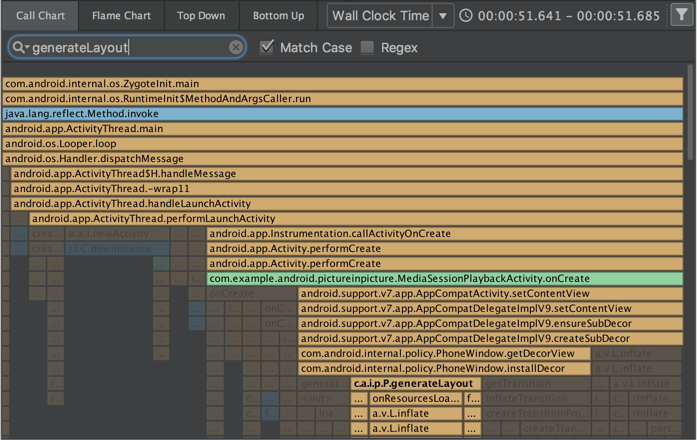
To search, click Filter in the top-right corner of the pane, type your query, and press Enter.
in the top-right corner of the pane, type your query, and press Enter.
Tip: You can also open the search field by pressing Control + F (Command + F on Mac).
In the CPU Profiler's Flame Chart tab, call stacks that include methods related to your search query are highlighted and moved to the left side of the chart.
For more information on filtering by method, class, or package name, see Record and inspect method traces .
Request tab in the Network Profiler
The Network Profiler now includes a Request tab that provides details about network requests during the selected timeline. In previous versions, the Network Profiler only provided information about network responses.
Thread View in the Network Profiler
After selecting a portion of the timeline in the Network Profiler , you can select one of the following tabs to see more detail about the network activity during that timeframe:
- Connection View : Provides the same information as previous versions of Android Studio—it lists files that were sent or received during the selected portion of the timeline across all of your app's CPU threads. For each request, you can inspect the size, type, status, and transmission duration.
- Thread View : Displays network activity of each of your app's CPU threads. This view allows you to inspect which of your app's threads are responsible for each network request.
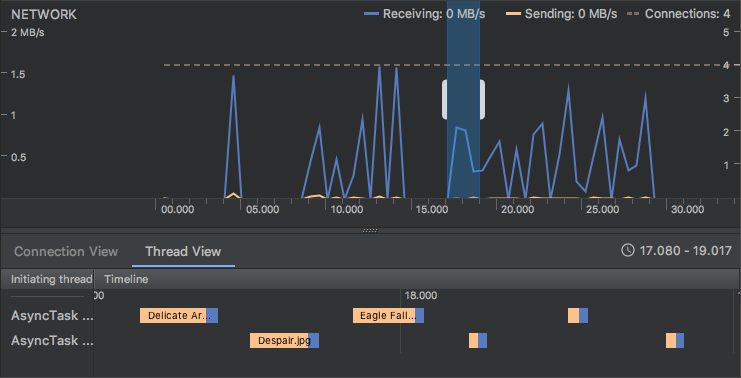
লেআউট ইন্সপেক্টর
The Layout Inspector gained new features, including some functionality previously provided by the deprecated Hierarchy Viewer and Pixel Perfect tools:
- Zoom buttons and keyboard shortcuts for navigating and inspecting layouts
- Reference grid overlay
- Ability to load a reference image and use it as an overlay (useful for comparing your layout with a UI mockup)
- Render subtree preview to isolate a view in a complex layout
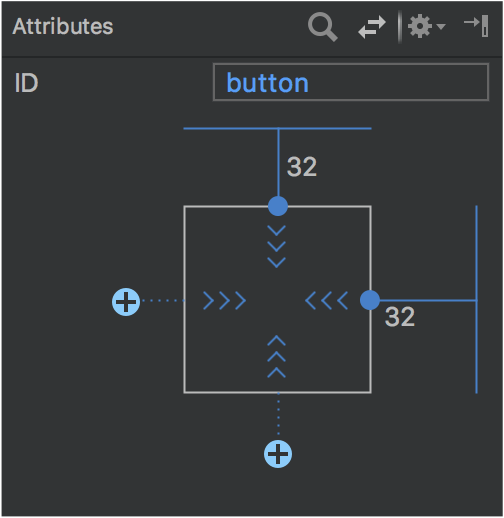
লেআউট এডিটর
The Palette in the Layout Editor has received many improvements:
- Reorganization of categories for views and layouts.
- New Common category for views and layouts, which you can add to with a Favorite command.
- Improved search for views and layouts .
- New commands for opening documentation for a specific view or layout element.
You can use the new Convert view command in the Component tree or design editor to convert a view or layout to another type of view or layout.
You can now easily create constraints to items near the selected view using the new Create a connection![]() buttons in the view inspector at the top of the Attributes window.
buttons in the view inspector at the top of the Attributes window.
Run and Instant Run
The behavior of the Use same selection for future launches option in the Select deployment target dialog has been made more consistent. If the Use same selection option is enabled, then the Select deployment target dialog opens only the first time that you use the Run command until the selected device is no longer connected.
When targeting a device running Android 8.0 (API level 26) or higher, Instant Run can deploy changes to resources without causing an application restart. This is possible because the resources are contained in a split APK.
এমুলেটর
For details of what's new and changed in the emulator since Android Studio 3.0, see the Android Emulator release notes from version 27.0.2 through version 27.1.12 .
Major improvements include the following:
- Quick Boot snapshots for saving of emulator state and faster start, with the ability to use the Save now command to save a custom start state.
- Windowless emulator screen.
- System images for Android 8.0 (API level 26), Android 8.1 (API level 27), and Android P Developer Preview.
User interface and user experience improvements
More tooltips, keyboard shortcuts, and helpful messages
We have added tooltips and helpful message overlays in many places throughout Android Studio.
To see keyboard shortcuts for many commands, just hold the mouse pointer over a button until the tooltip appears.
Tools > Android menu removed
The Tools > Android menu has been removed. Commands that were previously under this menu have been moved.
- Many commands moved to directly under the Tools menu.
- The Sync project with gradle files command moved to the File menu.
- The Device Monitor command has been removed, as described below.
Device Monitor available from the command line
In Android Studio 3.1, the Device Monitor serves less of a role than it previously did. In many cases, the functionality available through the Device Monitor is now provided by new and improved tools.
See the Device Monitor documentation for instructions for invoking the Device Monitor from the command line and for details of the tools available through the Device Monitor.
3.0 (October 2017)
অ্যান্ড্রয়েড স্টুডিও 3.0.0 একটি প্রধান রিলিজ যাতে বিভিন্ন ধরণের নতুন বৈশিষ্ট্য এবং উন্নতি অন্তর্ভুক্ত রয়েছে।
macOS ব্যবহারকারীরা: যদি আপনি Android Studio-এর একটি পুরোনো সংস্করণ আপডেট করেন, তাহলে আপনি একটি আপডেট ত্রুটির ডায়ালগের সম্মুখীন হতে পারেন যেখানে লেখা আছে "Some conflicts were found in installation area"। কেবল এই ত্রুটিটি উপেক্ষা করুন এবং ইনস্টলেশন পুনরায় শুরু করতে বাতিল করুন ক্লিক করুন।
৩.০.১ (নভেম্বর ২০১৭)
এটি অ্যান্ড্রয়েড স্টুডিও 3.0 এর একটি ছোট আপডেট যাতে সাধারণ বাগ সংশোধন এবং কর্মক্ষমতা উন্নতি অন্তর্ভুক্ত রয়েছে।
গ্রেডল ৩.০.০ এর জন্য অ্যান্ড্রয়েড প্লাগইন
গ্রেডলের জন্য নতুন অ্যান্ড্রয়েড প্লাগইনটিতে বিভিন্ন ধরণের উন্নতি এবং নতুন বৈশিষ্ট্য অন্তর্ভুক্ত রয়েছে, তবে এটি মূলত এমন প্রকল্পগুলির জন্য বিল্ড কর্মক্ষমতা উন্নত করে যেগুলিতে প্রচুর সংখ্যক মডিউল রয়েছে। এই বৃহৎ প্রকল্পগুলির সাথে নতুন প্লাগইন ব্যবহার করার সময়, আপনার নিম্নলিখিত অভিজ্ঞতাগুলি অনুভব করা উচিত:
- নতুন বিলম্বিত নির্ভরতা রেজোলিউশনের কারণে দ্রুত বিল্ড কনফিগারেশন সময়।
- শুধুমাত্র আপনার তৈরি করা প্রকল্প এবং ভেরিয়েন্টের জন্য ভেরিয়েন্ট-সচেতন নির্ভরতা রেজোলিউশন ।
- কোড বা রিসোর্সে সহজ পরিবর্তন প্রয়োগ করার সময় দ্রুত ক্রমবর্ধমান বিল্ড টাইম।
দ্রষ্টব্য: এই উন্নতিগুলির জন্য উল্লেখযোগ্য পরিবর্তন প্রয়োজন ছিল যা প্লাগইনের কিছু আচরণ, DSL এবং API গুলিকে ভেঙে দেয়। সংস্করণ 3.0.0 এ আপগ্রেড করার জন্য আপনার বিল্ড ফাইল এবং গ্রেডল প্লাগইনগুলিতে পরিবর্তনের প্রয়োজন হতে পারে।
এই সংস্করণে নিম্নলিখিতগুলিও অন্তর্ভুক্ত রয়েছে:
- অ্যান্ড্রয়েড ৮.০ এর জন্য সমর্থন।
- ভাষা সম্পদের উপর ভিত্তি করে পৃথক APK তৈরির জন্য সমর্থন।
- জাভা 8 লাইব্রেরি এবং জাভা 8 ভাষার বৈশিষ্ট্যগুলির জন্য সমর্থন (জ্যাক কম্পাইলার ছাড়া)।
- অ্যান্ড্রয়েড টেস্ট সাপোর্ট লাইব্রেরি ১.০ (অ্যান্ড্রয়েড টেস্ট ইউটিলিটি এবং অ্যান্ড্রয়েড টেস্ট অর্কেস্ট্রেটর ) এর জন্য সমর্থন।
- উন্নত ndk-build এবং cmake বিল্ড গতি।
- উন্নত গ্রেডল সিঙ্ক গতি।
- AAPT2 এখন ডিফল্টরূপে সক্রিয়।
-
ndkCompileব্যবহার এখন আরও সীমাবদ্ধ। আপনার APK-তে প্যাকেজ করতে চান এমন নেটিভ কোড কম্পাইল করার জন্য CMake অথবা ndk-build ব্যবহার করে মাইগ্রেট করা উচিত। আরও জানতে, ndkcompile থেকে Migrate পড়ুন।
কী পরিবর্তন করা হয়েছে সে সম্পর্কে আরও তথ্যের জন্য, গ্র্যাডলের জন্য অ্যান্ড্রয়েড প্লাগইন রিলিজ নোট দেখুন।
আপনি যদি নতুন প্লাগইনে আপগ্রেড করতে প্রস্তুত হন, তাহলে Gradle 3.0.0 এর জন্য Android Plugin এ মাইগ্রেট করুন দেখুন।
কোটলিন সাপোর্ট
গুগল আই/ও ২০১৭ তে ঘোষণা করা হয়েছে যে, কোটলিন প্রোগ্রামিং ভাষা এখন আনুষ্ঠানিকভাবে অ্যান্ড্রয়েডে সমর্থিত। তাই এই রিলিজের মাধ্যমে, অ্যান্ড্রয়েড স্টুডিওতে অ্যান্ড্রয়েড ডেভেলপমেন্টের জন্য কোটলিন ভাষা সমর্থন অন্তর্ভুক্ত করা হয়েছে।
আপনি আপনার প্রকল্পে কোটলিনকে অন্তর্ভুক্ত করতে পারেন একটি জাভা ফাইলকে কোটলিনে রূপান্তর করে ( কোড > জাভা ফাইলকে কোটলিন ফাইলে রূপান্তর করুন ক্লিক করুন) অথবা নতুন প্রকল্প উইজার্ড ব্যবহার করে একটি নতুন কোটলিন-সক্ষম প্রকল্প তৈরি করে।
শুরু করতে, আপনার প্রকল্পে কোটলিন কীভাবে যুক্ত করবেন তা পড়ুন।
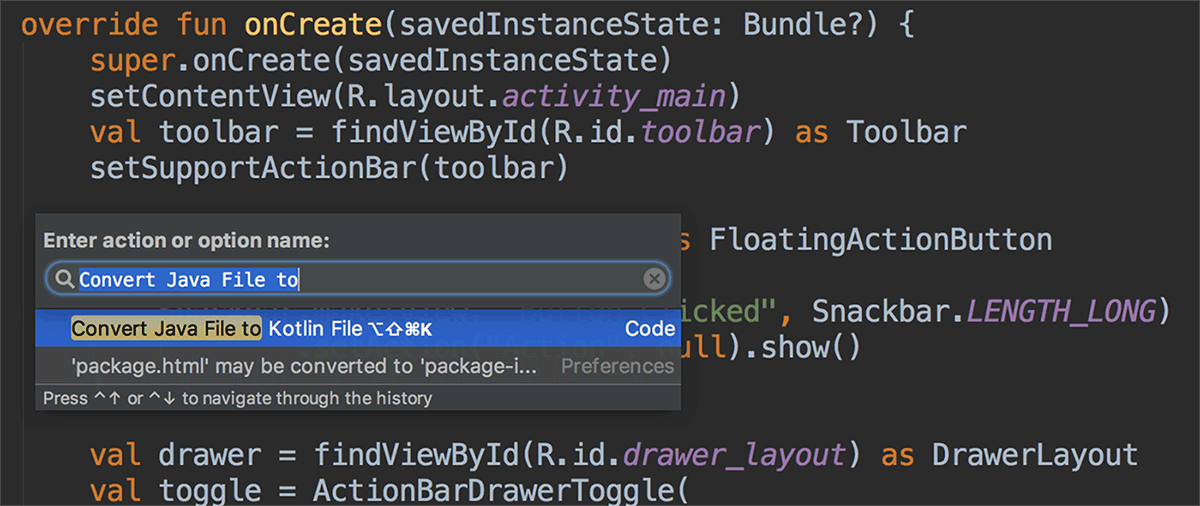
Java 8 language features support
আপনি এখন জাভা ৮ ভাষার কিছু বৈশিষ্ট্য ব্যবহার করতে পারবেন এবং জাভা ৮ দিয়ে তৈরি লাইব্রেরি ব্যবহার করতে পারবেন । জ্যাকের আর প্রয়োজন নেই , এবং ডিফল্ট টুলচেইনে তৈরি উন্নত জাভা ৮ সমর্থন ব্যবহার করার জন্য আপনাকে প্রথমে জ্যাককে অক্ষম করতে হবে।
নতুন জাভা ৮ ভাষার টুলচেইন সমর্থন করার জন্য আপনার প্রকল্পটি আপডেট করতে, প্রকল্প কাঠামো ডায়ালগে সোর্স সামঞ্জস্যতা এবং লক্ষ্য সামঞ্জস্যতা ১.৮ এ আপডেট করুন ( ফাইল > প্রকল্প কাঠামো ক্লিক করুন)। আরও জানতে, জাভা ৮ ভাষার বৈশিষ্ট্যগুলি কীভাবে ব্যবহার করবেন তা পড়ুন।
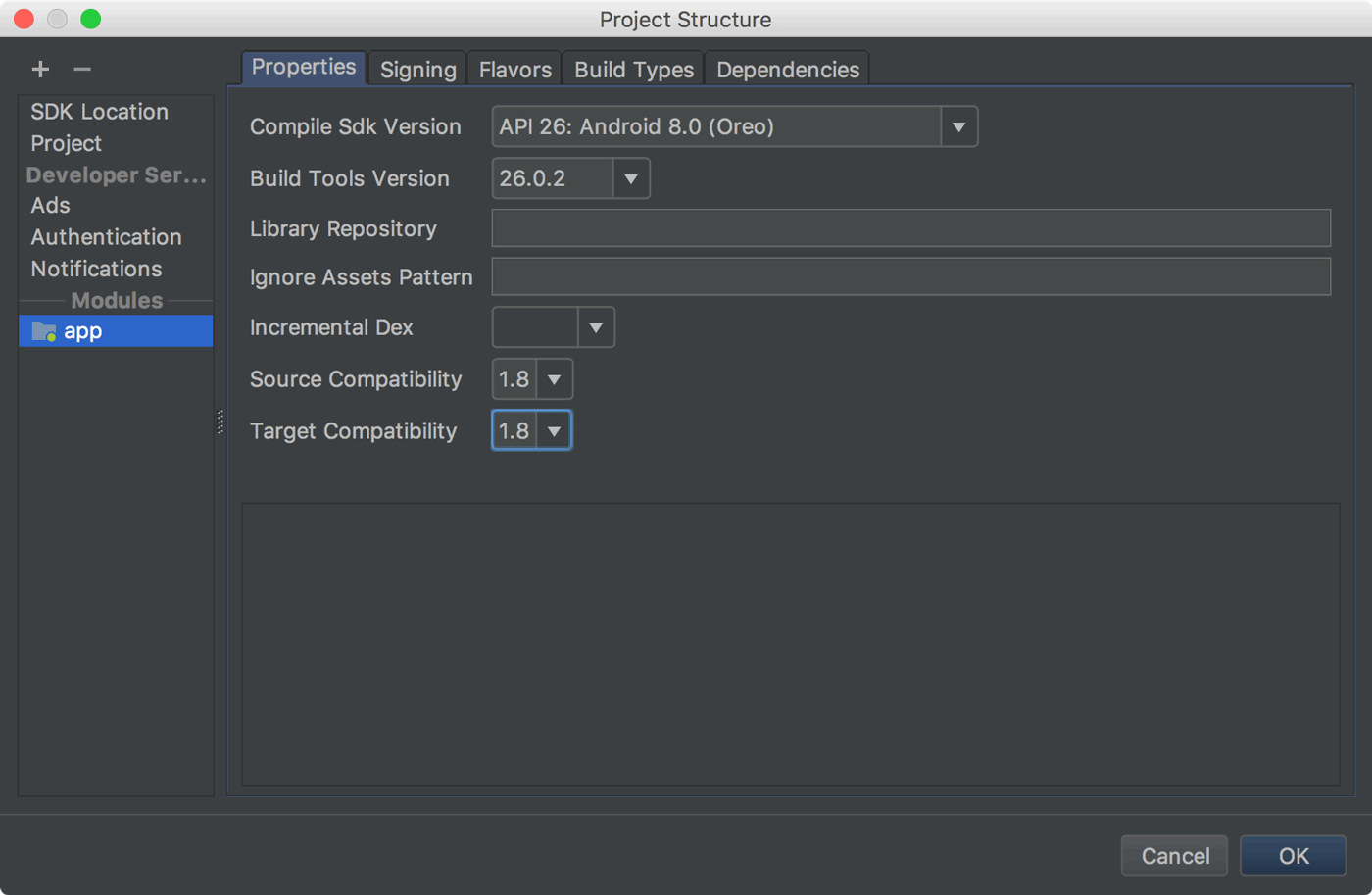
অ্যান্ড্রয়েড প্রোফাইলার
নতুন অ্যান্ড্রয়েড প্রোফাইলার অ্যান্ড্রয়েড মনিটর টুলকে প্রতিস্থাপন করে এবং রিয়েলটাইমে আপনার অ্যাপের সিপিইউ, মেমোরি এবং নেটওয়ার্ক ব্যবহার পরিমাপ করার জন্য একটি নতুন সরঞ্জাম সরবরাহ করে। আপনি আপনার কোড এক্সিকিউশনের সময় অনুসারে নমুনা-ভিত্তিক পদ্ধতি ট্রেসিং করতে পারেন, হিপ ডাম্প ক্যাপচার করতে পারেন, মেমোরি বরাদ্দ দেখতে পারেন এবং নেটওয়ার্ক-প্রেরিত ফাইলগুলির বিশদ পরিদর্শন করতে পারেন।
খুলতে, View > Tool Windows > Android Profiler এ ক্লিক করুন (অথবা টুলবারে Android Profiler এ ক্লিক করুন)।
উইন্ডোর উপরের ইভেন্ট টাইমলাইনে টাচ ইভেন্ট, কী প্রেস এবং অ্যাক্টিভিটির পরিবর্তনগুলি দেখানো হয় যাতে টাইমলাইনে অন্যান্য পারফর্ম্যান্স ইভেন্টগুলি বোঝার জন্য আপনার কাছে আরও প্রসঙ্গ থাকে।
দ্রষ্টব্য: লগক্যাট ভিউটিও একটি পৃথক উইন্ডোতে সরানো হয়েছে (এটি আগে অ্যান্ড্রয়েড মনিটরের ভিতরে ছিল, যা সরানো হয়েছে)।
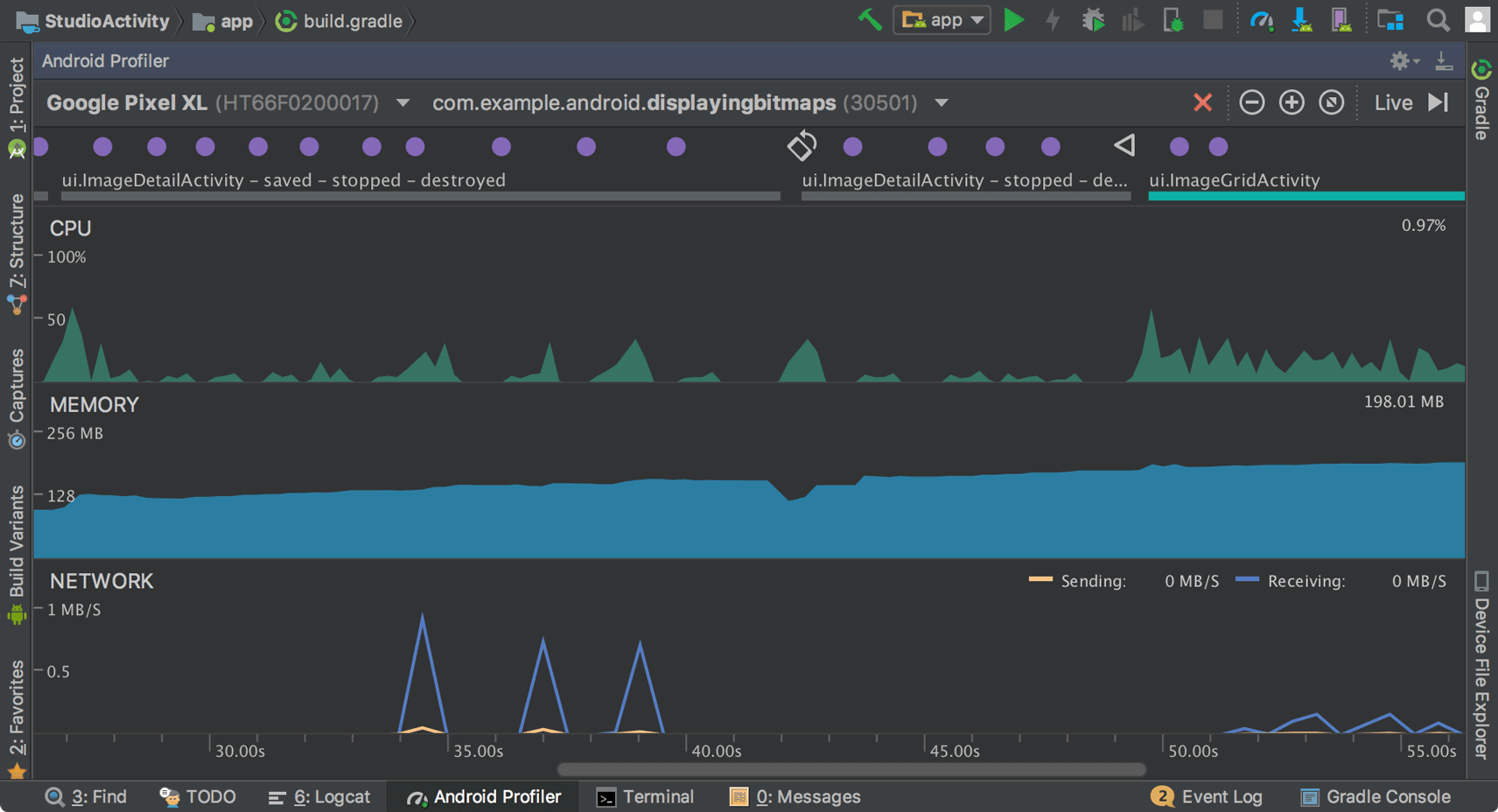
অ্যান্ড্রয়েড প্রোফাইলারের ওভারভিউ টাইমলাইন থেকে, সংশ্লিষ্ট প্রোফাইলার টুলগুলি অ্যাক্সেস করতে CPU , MEMORY , অথবা NETWORK টাইমলাইনে ক্লিক করুন।
সিপিইউ প্রোফাইলার
CPU প্রোফাইলার আপনার অ্যাপের CPU থ্রেড ব্যবহার বিশ্লেষণ করতে সাহায্য করে একটি নমুনা বা ইন্সট্রুমেন্টেড CPU ট্রেস ট্রিগার করে। তারপর, আপনি বিভিন্ন ডেটা ভিউ এবং ফিল্টার ব্যবহার করে CPU কর্মক্ষমতা সমস্যা সমাধান করতে পারেন।
আরও তথ্যের জন্য, CPU প্রোফাইলার নির্দেশিকা দেখুন।
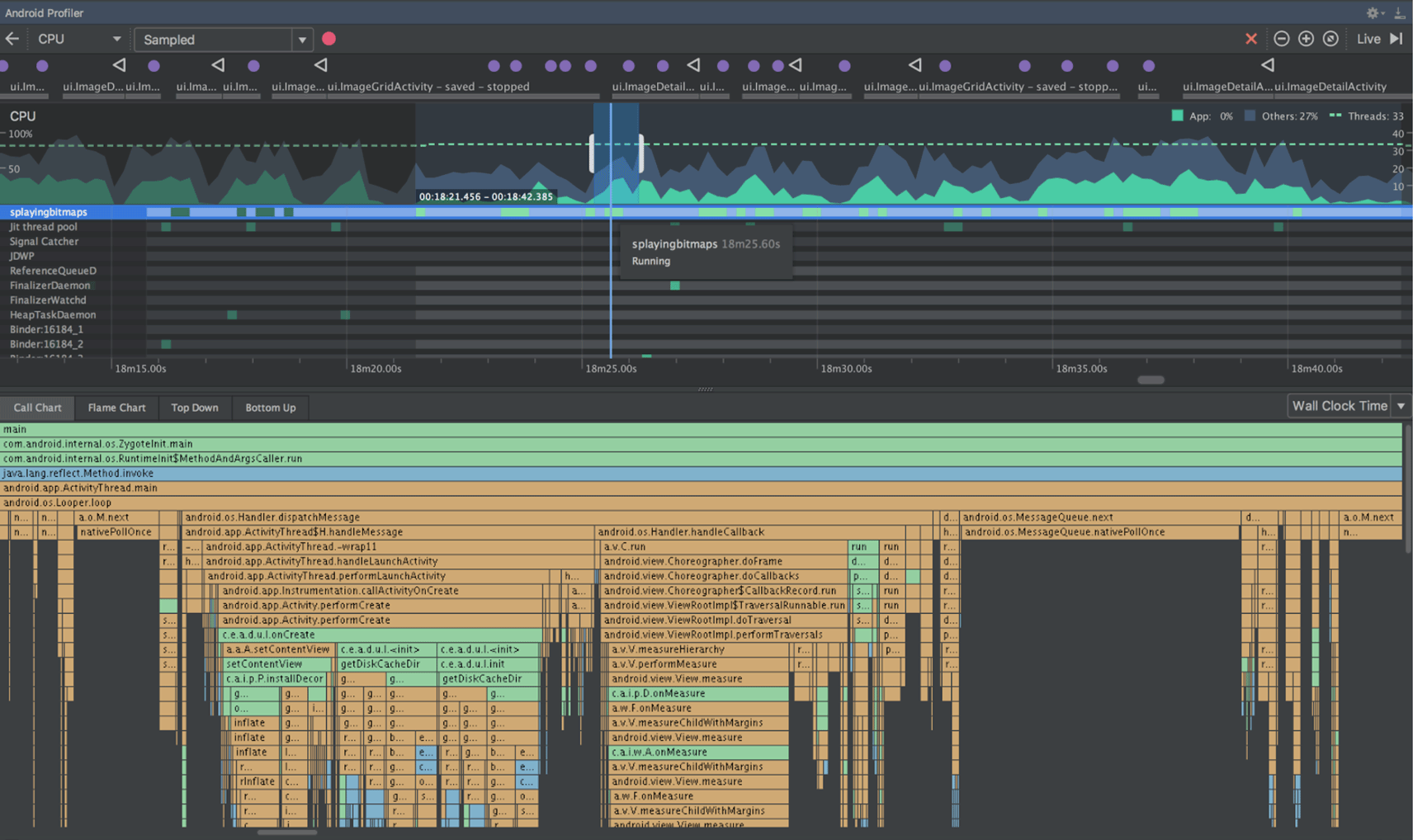
মেমোরি প্রোফাইলার
মেমোরি প্রোফাইলার আপনাকে মেমোরি লিক এবং মেমোরি পরিবর্তন সনাক্ত করতে সাহায্য করে যা তোতলানো, জমে যাওয়া এবং এমনকি অ্যাপ ক্র্যাশের কারণ হতে পারে। এটি আপনার অ্যাপের মেমোরি ব্যবহারের একটি রিয়েলটাইম গ্রাফ দেখায়, আপনাকে একটি হিপ ডাম্প ক্যাপচার করতে, জোর করে আবর্জনা সংগ্রহ করতে এবং মেমোরি বরাদ্দ ট্র্যাক করতে দেয়।
আরও তথ্যের জন্য, মেমরি প্রোফাইলার গাইড দেখুন।
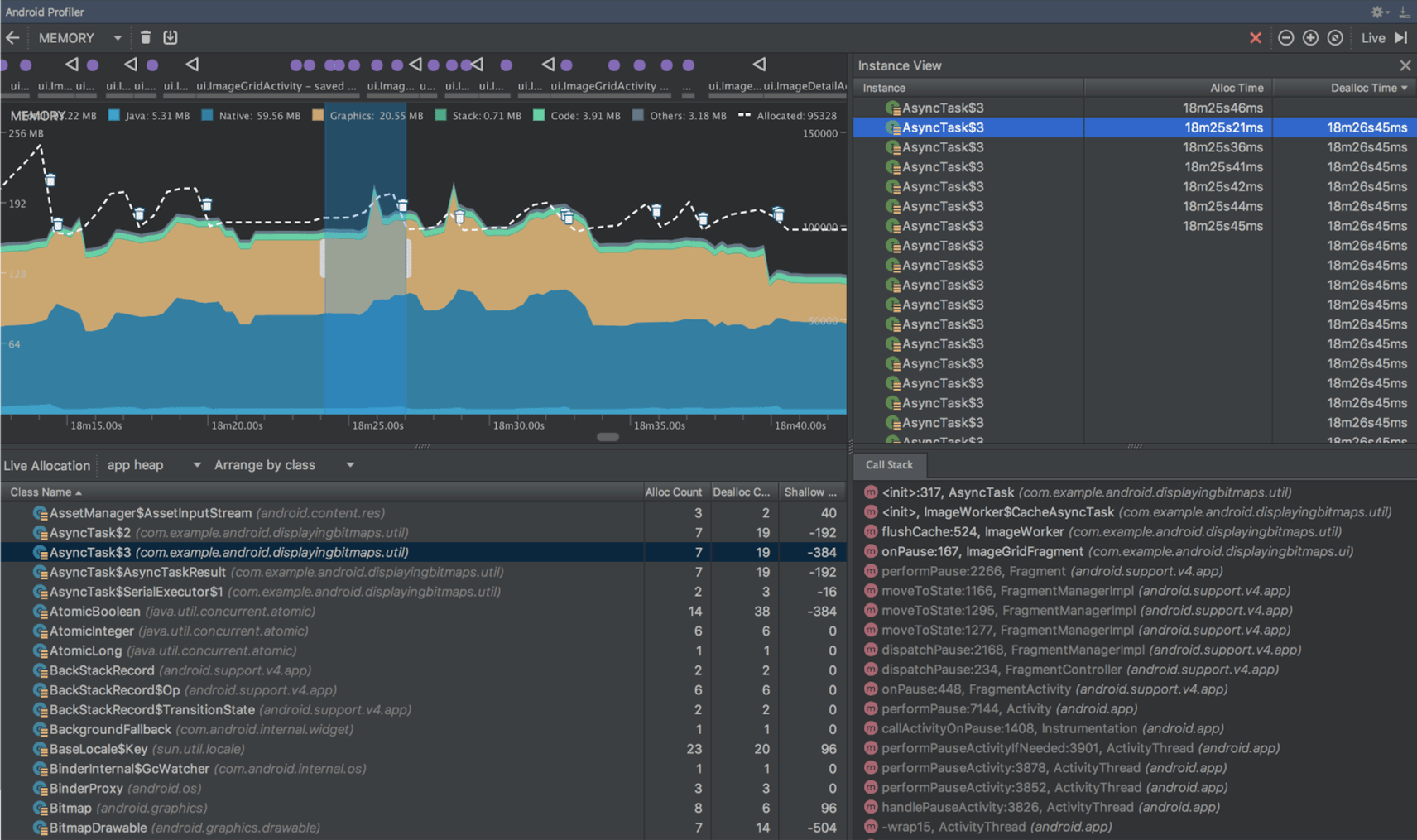
নেটওয়ার্ক প্রোফাইলার
নেটওয়ার্ক প্রোফাইলার আপনাকে আপনার অ্যাপের নেটওয়ার্ক কার্যকলাপ পর্যবেক্ষণ করতে, আপনার প্রতিটি নেটওয়ার্ক অনুরোধের পেলোড পরীক্ষা করতে এবং নেটওয়ার্ক অনুরোধ তৈরি করা কোডের সাথে লিঙ্ক করতে দেয়।
আরও তথ্যের জন্য, নেটওয়ার্ক প্রোফাইলার নির্দেশিকা দেখুন।
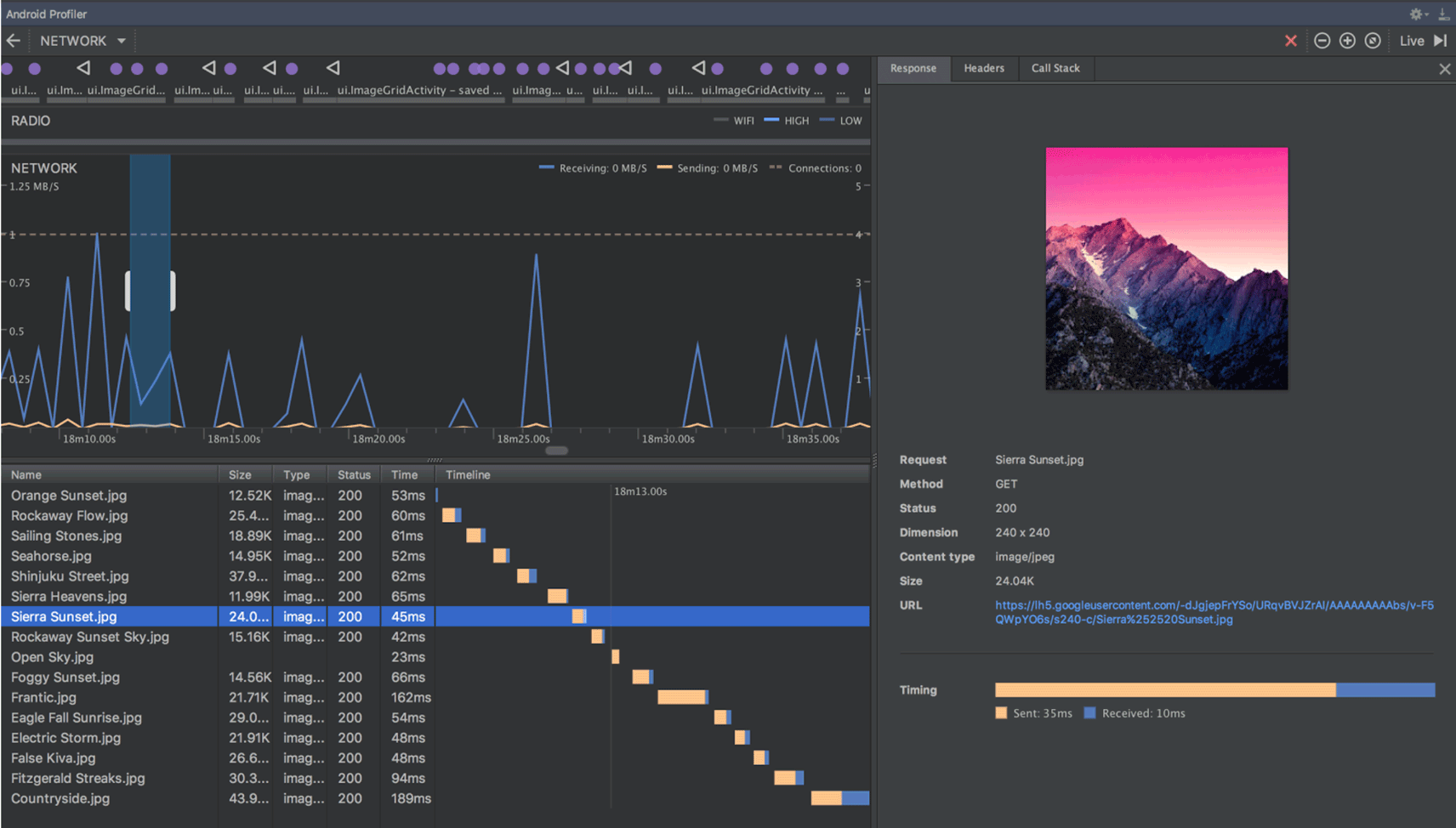
APK প্রোফাইলিং এবং ডিবাগিং
অ্যান্ড্রয়েড স্টুডিও এখন আপনাকে অ্যান্ড্রয়েড স্টুডিও প্রকল্প থেকে তৈরি না করেই যেকোনো APK প্রোফাইল এবং ডিবাগ করার অনুমতি দেয়—যদি APKটি ডিবাগিং সক্ষম করার জন্য তৈরি করা হয় এবং আপনার ডিবাগ প্রতীক এবং উৎস ফাইলগুলিতে অ্যাক্সেস থাকে।
শুরু করতে, Android Studio Welcome স্ক্রিন থেকে Profile অথবা debug APK এ ক্লিক করুন। অথবা, যদি আপনার ইতিমধ্যেই একটি প্রজেক্ট খোলা থাকে, তাহলে মেনু বার থেকে File > Profile অথবা debug APK এ ক্লিক করুন। এটি আনপ্যাক করা APK ফাইলগুলি প্রদর্শন করে, কিন্তু এটি কোডটি ডিকম্পাইল করে না। সুতরাং, সঠিকভাবে ব্রেকপয়েন্ট যোগ করতে এবং স্ট্যাক ট্রেস দেখতে, আপনাকে জাভা সোর্স ফাইল এবং নেটিভ ডিবাগ প্রতীক সংযুক্ত করতে হবে।
আরও তথ্যের জন্য, প্রোফাইল এবং ডিবাগ প্রি-বিল্ট APK দেখুন।
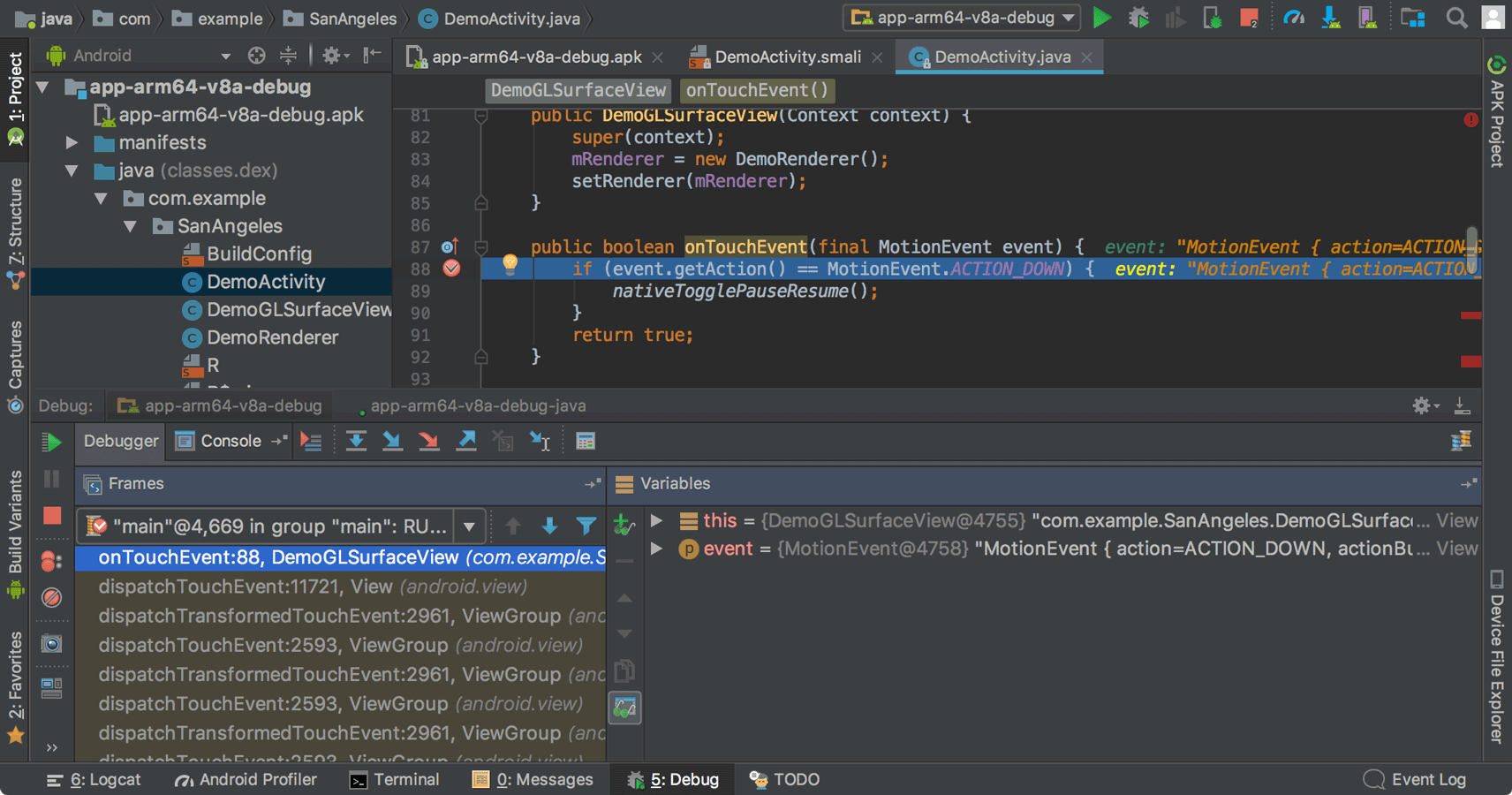
ডিভাইস ফাইল এক্সপ্লোরার
নতুন ডিভাইস ফাইল এক্সপ্লোরার আপনাকে আপনার সংযুক্ত ডিভাইসের ফাইল সিস্টেম পরিদর্শন করতে এবং ডিভাইস এবং আপনার কম্পিউটারের মধ্যে ফাইল স্থানান্তর করতে দেয়। এটি DDMS-এ উপলব্ধ ফাইল সিস্টেম টুলটিকে প্রতিস্থাপন করে।
খুলতে, View > Tool Windows > Device File Explorer এ ক্লিক করুন।
আরও তথ্যের জন্য, ডিভাইস ফাইল এক্সপ্লোরার নির্দেশিকা দেখুন।
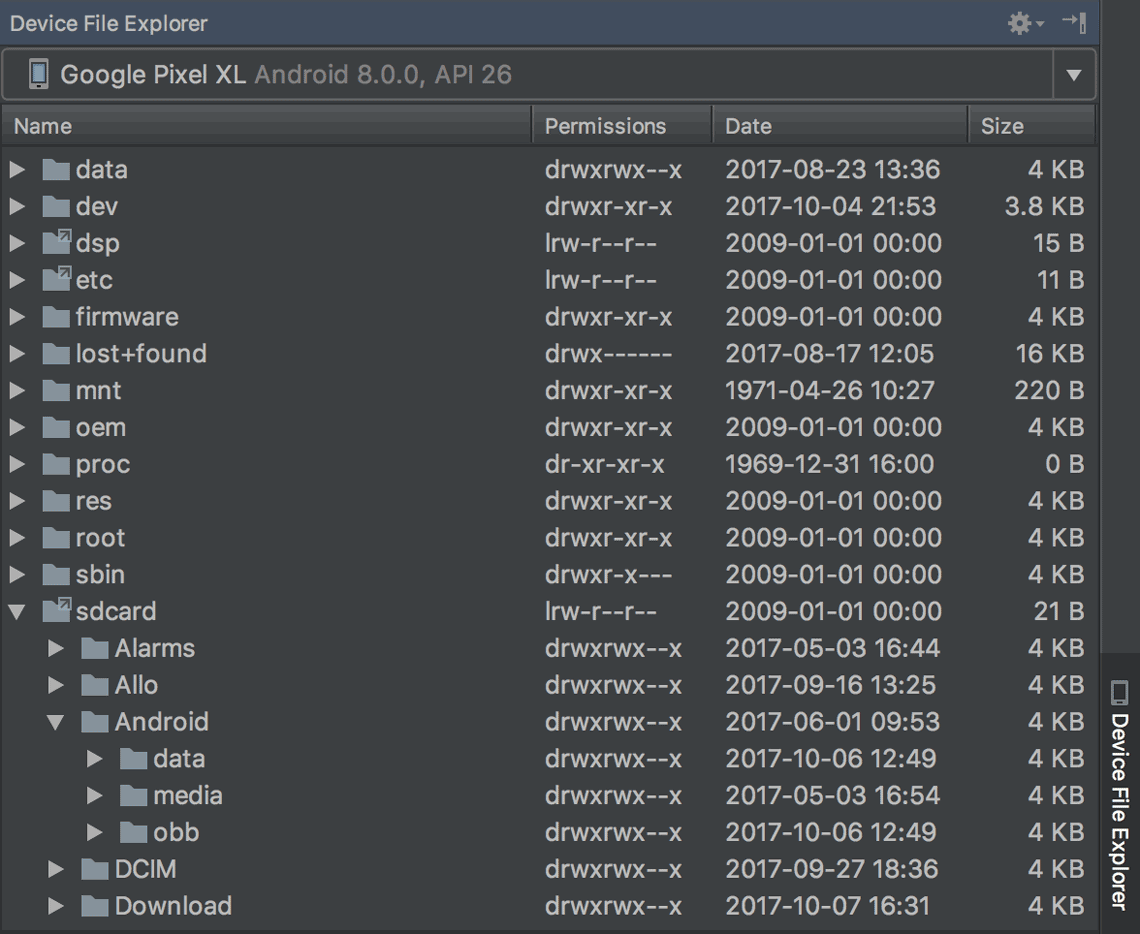
তাৎক্ষণিক অ্যাপস সাপোর্ট
অ্যান্ড্রয়েড ইনস্ট্যান্ট অ্যাপসের জন্য নতুন সমর্থন আপনাকে দুটি নতুন মডিউল ধরণের ব্যবহার করে আপনার প্রকল্পে ইনস্ট্যান্ট অ্যাপ তৈরি করতে দেয়: ইনস্ট্যান্ট অ্যাপ মডিউল এবং ফিচার মডিউল (এগুলির জন্য আপনাকে ইনস্ট্যান্ট অ্যাপস ডেভেলপমেন্ট SDK ইনস্টল করতে হবে)।
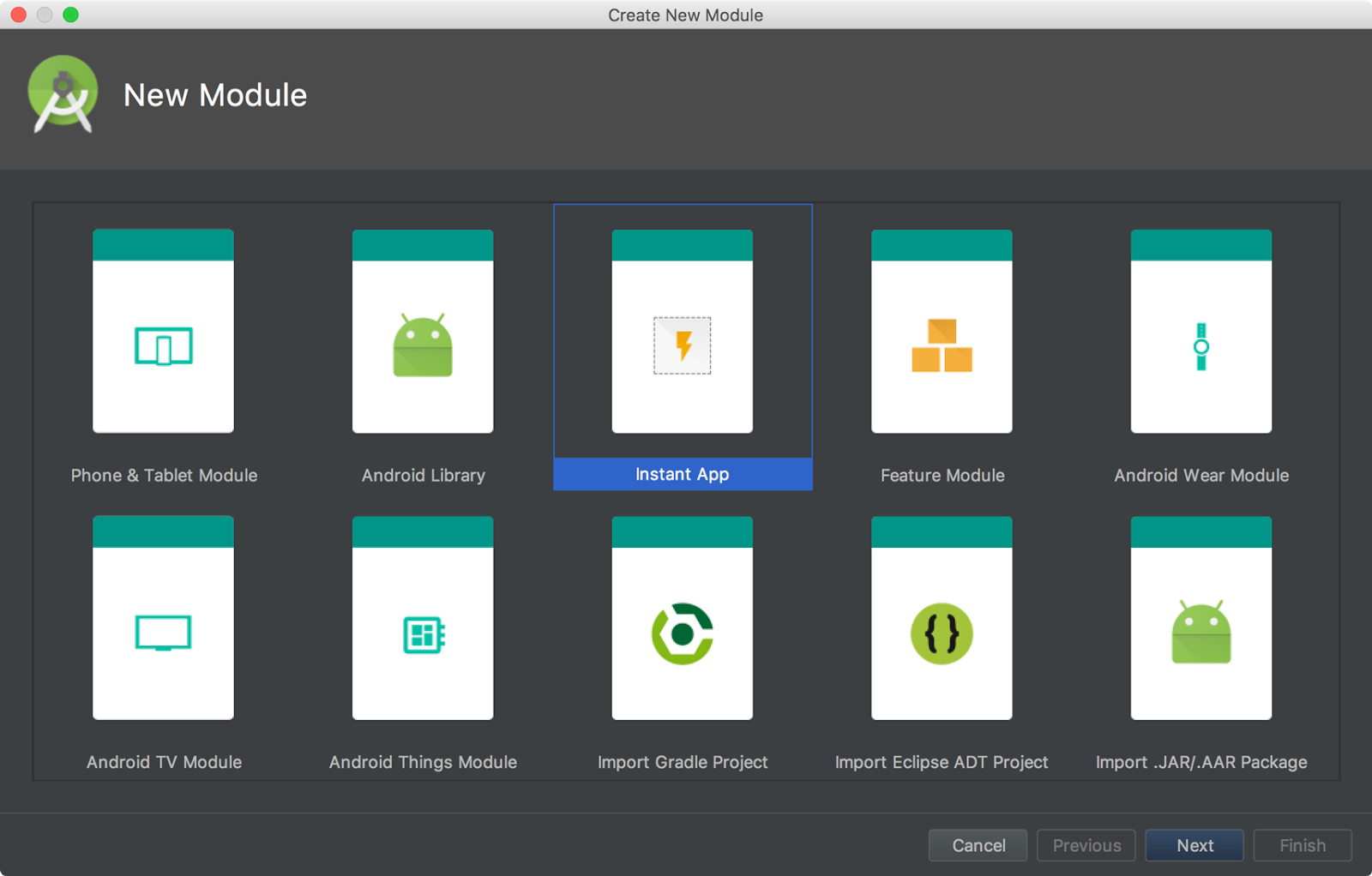
অ্যান্ড্রয়েড স্টুডিওতে একটি নতুন মডুলারাইজ রিফ্যাক্টরিং অ্যাকশনও অন্তর্ভুক্ত রয়েছে যা আপনাকে একটি বিদ্যমান প্রকল্পে ইনস্ট্যান্ট অ্যাপের জন্য সমর্থন যোগ করতে সাহায্য করবে। উদাহরণস্বরূপ, যদি আপনি আপনার প্রকল্পটিকে একটি ইনস্ট্যান্ট অ্যাপ বৈশিষ্ট্য মডিউলে কিছু ক্লাস স্থাপন করার জন্য রিফ্যাক্টর করতে চান, তাহলে প্রজেক্ট উইন্ডোতে ক্লাসগুলি নির্বাচন করুন এবং Refactor > Modularize এ ক্লিক করুন। প্রদর্শিত ডায়ালগে, ক্লাসগুলি কোথায় যাওয়া উচিত সেই মডিউলটি নির্বাচন করুন এবং OK এ ক্লিক করুন।
এবং যখন আপনি আপনার Instant App পরীক্ষা করার জন্য প্রস্তুত হন, তখন আপনি run কনফিগারেশন লঞ্চ বিকল্পগুলির মধ্যে Instant App এর URL নির্দিষ্ট করে একটি সংযুক্ত ডিভাইসে আপনার Instant App মডিউল তৈরি এবং চালাতে পারেন: Run > Edit Configurations নির্বাচন করুন, আপনার Instant App মডিউল নির্বাচন করুন এবং তারপর Launch Options এর অধীনে URL সেট করুন।
আরও তথ্যের জন্য, অ্যান্ড্রয়েড ইনস্ট্যান্ট অ্যাপস দেখুন।
অ্যান্ড্রয়েড থিংস মডিউল
নতুন প্রকল্পে নতুন অ্যান্ড্রয়েড থিংস টেমপ্লেট এবং নতুন মডিউল উইজার্ড যা আপনাকে অ্যান্ড্রয়েড-চালিত IOT ডিভাইসগুলির জন্য ডেভেলপমেন্ট শুরু করতে সাহায্য করবে।
আরও তথ্যের জন্য, কীভাবে একটি Android Things প্রকল্প তৈরি করবেন তা দেখুন।
অভিযোজিত আইকন উইজার্ড
ইমেজ অ্যাসেট স্টুডিও এখন ভেক্টর ড্রয়েবল সমর্থন করে এবং আপনাকে অ্যান্ড্রয়েড 8.0 এর জন্য অ্যাডাপ্টিভ লঞ্চার আইকন তৈরি করার পাশাপাশি পুরানো ডিভাইসের জন্য ঐতিহ্যবাহী আইকন ("লেগ্যাসি" আইকন) তৈরি করার অনুমতি দেয়।
শুরু করতে, আপনার প্রোজেক্টের res ফোল্ডারে ডান-ক্লিক করুন, এবং তারপর New > Image Asset এ ক্লিক করুন। Asset Studio উইন্ডোতে, আইকনের ধরণ হিসেবে Launcher Icons (Adaptive and Legacy) নির্বাচন করুন।
Note: You must set compileSdkVersion to 26 or higher to use adaptive launcher icons.
আরও তথ্যের জন্য, অ্যাডাপ্টিভ আইকন সম্পর্কে পড়ুন।
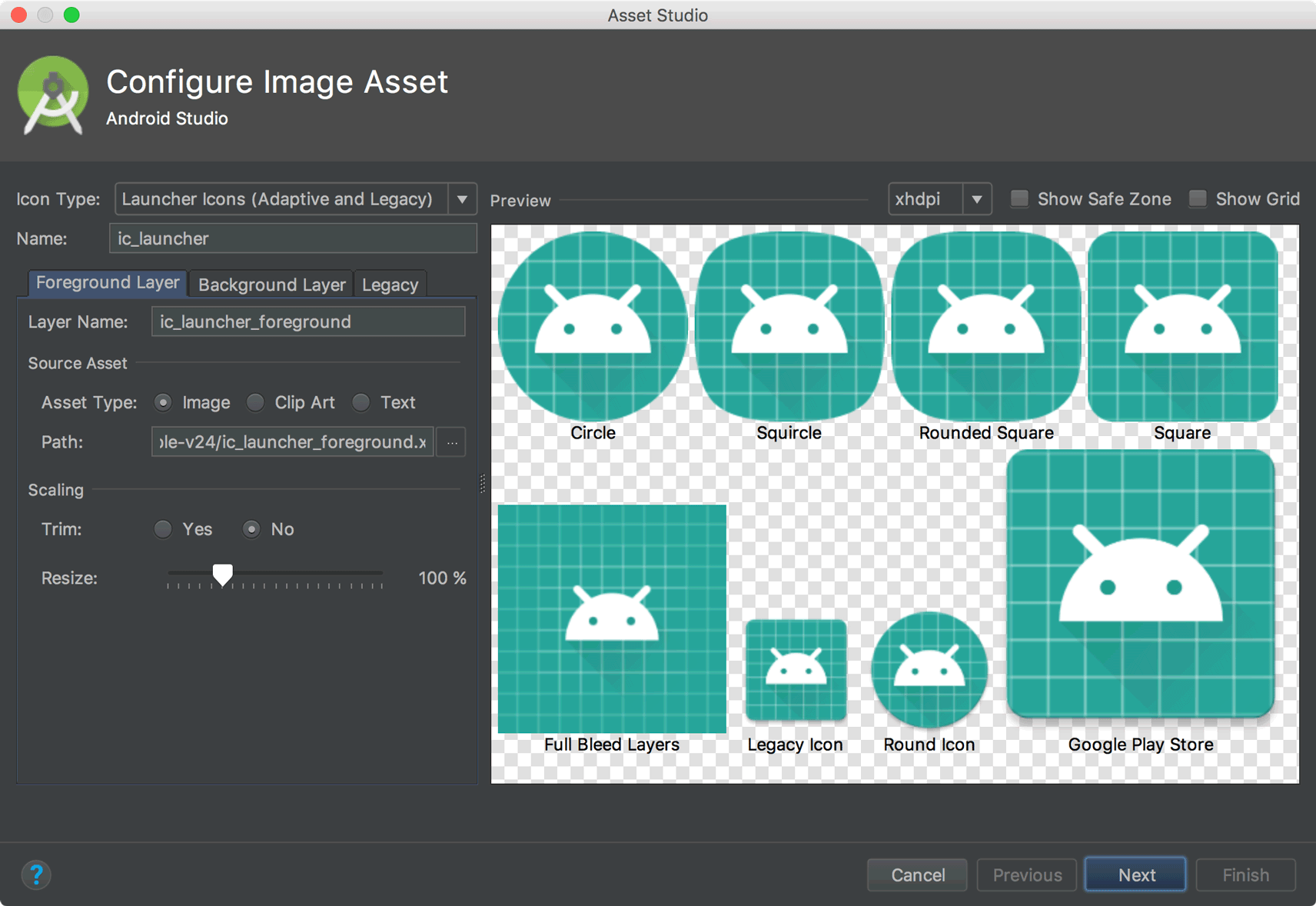
ফন্ট রিসোর্সের জন্য সমর্থন
অ্যান্ড্রয়েড ৮.০-তে নতুন ফন্ট রিসোর্সগুলিকে সমর্থন করার জন্য, অ্যান্ড্রয়েড স্টুডিওতে একটি ফন্ট রিসোর্স নির্বাচক অন্তর্ভুক্ত করা হয়েছে যা আপনার অ্যাপে ফন্টগুলিকে বান্ডিল করতে বা ডিভাইসে ফন্টগুলি ডাউনলোড করার জন্য আপনার প্রকল্পটি কনফিগার করতে সহায়তা করে (যখন উপলব্ধ থাকে)। লেআউট সম্পাদক আপনার লেআউটের ফন্টগুলিও প্রিভিউ করতে পারে।
ডাউনলোডযোগ্য ফন্ট ব্যবহার করে দেখতে, নিশ্চিত করুন যে আপনার ডিভাইস বা এমুলেটরটি Google Play Services v11.2.63 বা তার উচ্চতর সংস্করণে চলছে। আরও তথ্যের জন্য, ডাউনলোডযোগ্য ফন্ট সম্পর্কে পড়ুন।
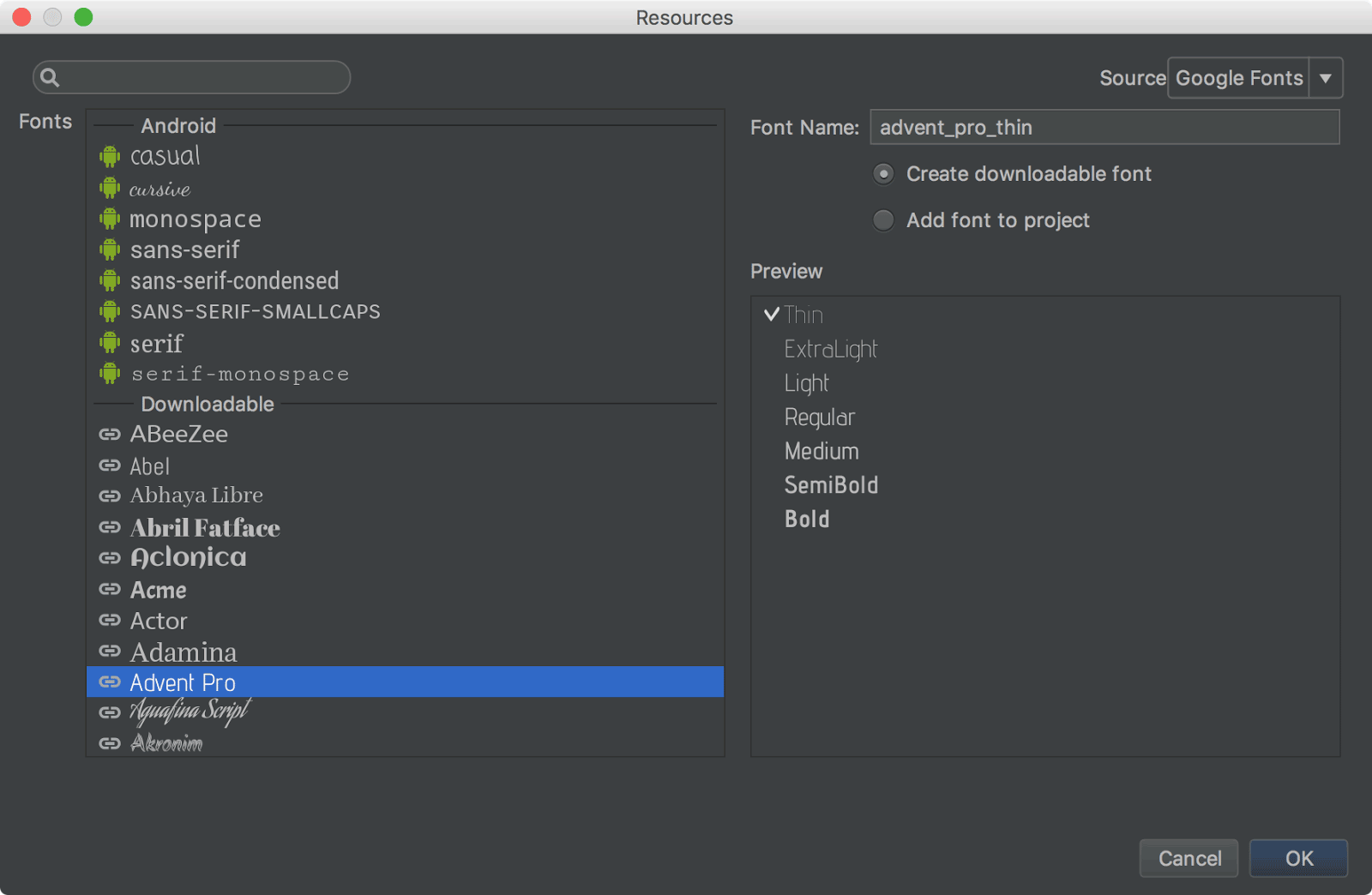
ফায়ারবেস অ্যাপ ইনডেক্সিং সহকারী
অ্যাপ ইনডেক্সিং পরীক্ষা করার জন্য ফায়ারবেস অ্যাসিস্ট্যান্টকে একটি নতুন টিউটোরিয়াল দিয়ে আপডেট করা হয়েছে। অ্যাসিস্ট্যান্ট খুলতে, টুলস > ফায়ারবেস নির্বাচন করুন। তারপর অ্যাপ ইনডেক্সিং > টেস্ট অ্যাপ ইনডেক্সিং নির্বাচন করুন।
টিউটোরিয়ালে আপনার পাবলিক এবং ব্যক্তিগত কন্টেন্ট ইন্ডেক্সিং পরীক্ষা করার জন্য নতুন বোতাম অন্তর্ভুক্ত রয়েছে:
- ধাপ ২-এ, আপনার URL গুলি Google অনুসন্ধান ফলাফলে দেখানো হচ্ছে কিনা তা যাচাই করতে অনুসন্ধান ফলাফলের পূর্বরূপ দেখুন- এ ক্লিক করুন।
- ধাপ ৩-এ, আপনার অ্যাপের ইনডেক্সেবল অবজেক্টগুলি ব্যক্তিগত সামগ্রী সূচীতে যোগ করা হয়েছে কিনা তা যাচাই করতে ত্রুটির জন্য পরীক্ষা করুন ক্লিক করুন।
অ্যান্ড্রয়েড অ্যাপ লিংক সহকারী
অ্যাপ লিংক অ্যাসিস্ট্যান্ট নিম্নলিখিত নতুন বৈশিষ্ট্যগুলির সাথে আপডেট করা হয়েছে:
আপনার ইনটেন্ট ফিল্টারগুলি বাস্তব-বিশ্বের URL গুলি পরিচালনা করে কিনা তা নিশ্চিত করতে প্রতিটি URL ম্যাপিংয়ের জন্য URL পরীক্ষা যোগ করুন ।
আপনি নিচে বর্ণিত
<tools:validation>ট্যাগ ব্যবহার করে হাতে এই URL পরীক্ষাগুলি সংজ্ঞায়িত করতে পারেন।Google Smart Lock সমর্থন করার জন্য উপযুক্ত অবজেক্ট এন্ট্রি সহ একটি ডিজিটাল অ্যাসেট লিঙ্ক ফাইল তৈরি করুন এবং আপনার ম্যানিফেস্ট ফাইলে সংশ্লিষ্ট
asset_statements<meta-data>ট্যাগ যোগ করুন।
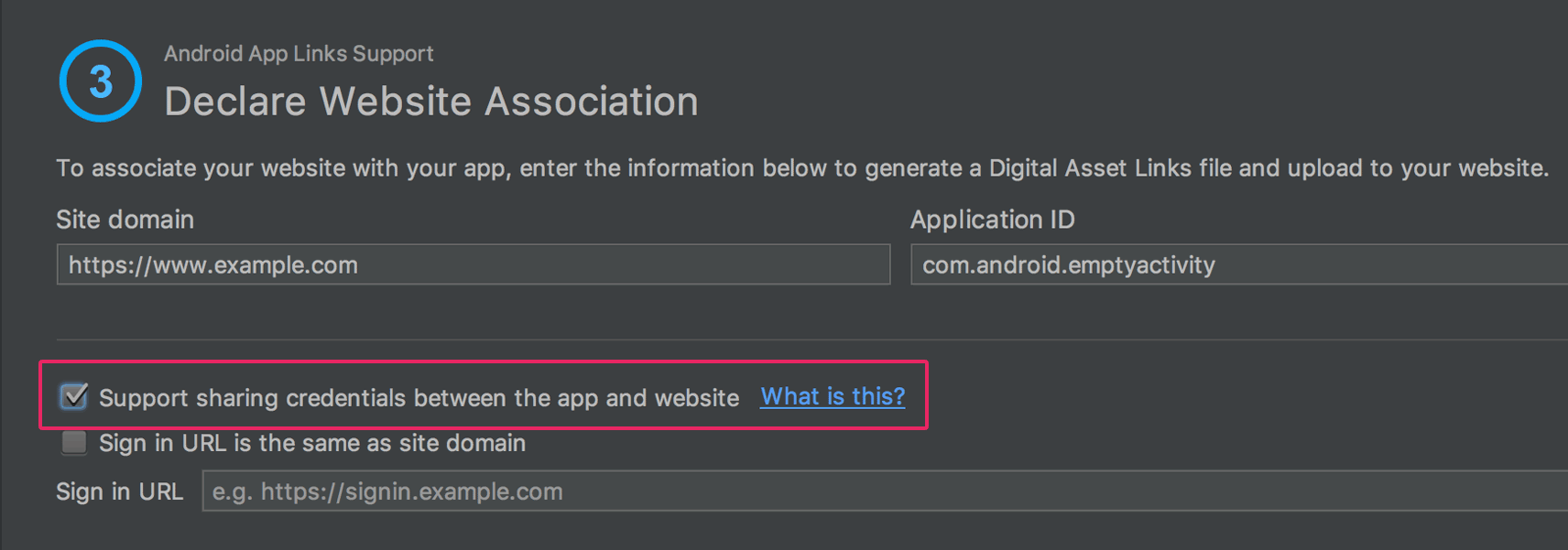
URL ইন্টেন্ট-ফিল্টার ভ্যালিডেটর
অ্যান্ড্রয়েড স্টুডিও এখন ম্যানিফেস্ট ফাইলে একটি বিশেষ ট্যাগ সমর্থন করে যা আপনাকে আপনার ইন্টেন্ট ফিল্টার URL গুলি পরীক্ষা করতে দেয়। এই একই ট্যাগগুলি অ্যাপ লিংক সহকারী আপনার জন্য তৈরি করতে পারে ।
একটি ইন্টেন্ট ফিল্টারের জন্য একটি পরীক্ষামূলক URL ঘোষণা করতে, সংশ্লিষ্ট <intent-filter> উপাদানের পাশাপাশি একটি <tools:validation> উপাদান যোগ করুন। উদাহরণস্বরূপ:
<activity ...>
<intent-filter>
...
</intent-filter>
<tools:validation testUrl="https://www.example.com/recipe/1138" />
</activity>
<manifest> ট্যাগে xmlns:tools="http://schemas.android.com/tools" অন্তর্ভুক্ত করতে ভুলবেন না।
যদি কোনও একটি পরীক্ষার URL ইন্টেন্ট ফিল্টার সংজ্ঞা পাস না করে, তাহলে একটি লিন্ট ত্রুটি দেখা দেয়। এই ধরনের ত্রুটি আপনাকে ডিবাগ ভেরিয়েন্ট তৈরি করতে দেয়, তবে এটি আপনার রিলিজ বিল্ডগুলিকে ভেঙে ফেলবে।
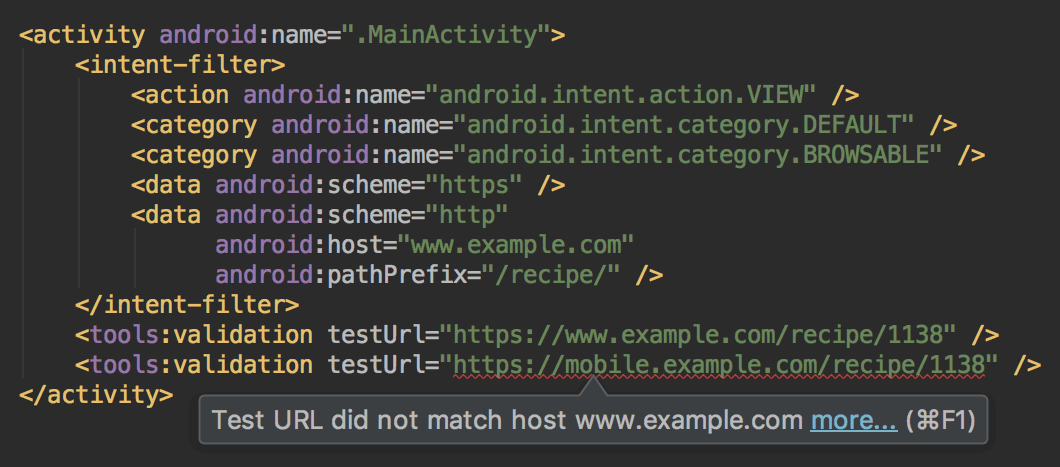
লেআউট এডিটর
লেআউট এডিটরটি বেশ কিছু উন্নত বৈশিষ্ট্য সহ আপডেট করা হয়েছে, যার মধ্যে নিম্নলিখিতগুলি অন্তর্ভুক্ত রয়েছে:
- নতুন টুলবার লেআউট এবং আইকন।
- Updated layout in the component tree.
- উন্নত ড্র্যাগ-এন্ড-ড্রপ ভিউ সন্নিবেশ।
- সম্পাদকের নীচে নতুন ত্রুটি প্যানেল, যেখানে সমস্ত সমস্যা দেখাচ্ছে এবং সমাধানের পরামর্শ (যদি উপলব্ধ থাকে)।
-
ConstraintLayoutদিয়ে নির্মাণের জন্য বিভিন্ন UI বর্ধিতকরণ, যার মধ্যে নিম্নলিখিতগুলি অন্তর্ভুক্ত রয়েছে:- বাধা তৈরির জন্য নতুন সমর্থন।
- গ্রুপ তৈরির জন্য নতুন সাপোর্ট: টুলবারে, নির্দেশিকা > গ্রুপ যোগ করুন নির্বাচন করুন ( ConstraintLayout 1.1.0 বিটা 2 বা উচ্চতর প্রয়োজন)
- চেইন তৈরির জন্য নতুন UI: একাধিক ভিউ নির্বাচন করুন, এবং তারপর ডান-ক্লিক করুন এবং চেইন নির্বাচন করুন।
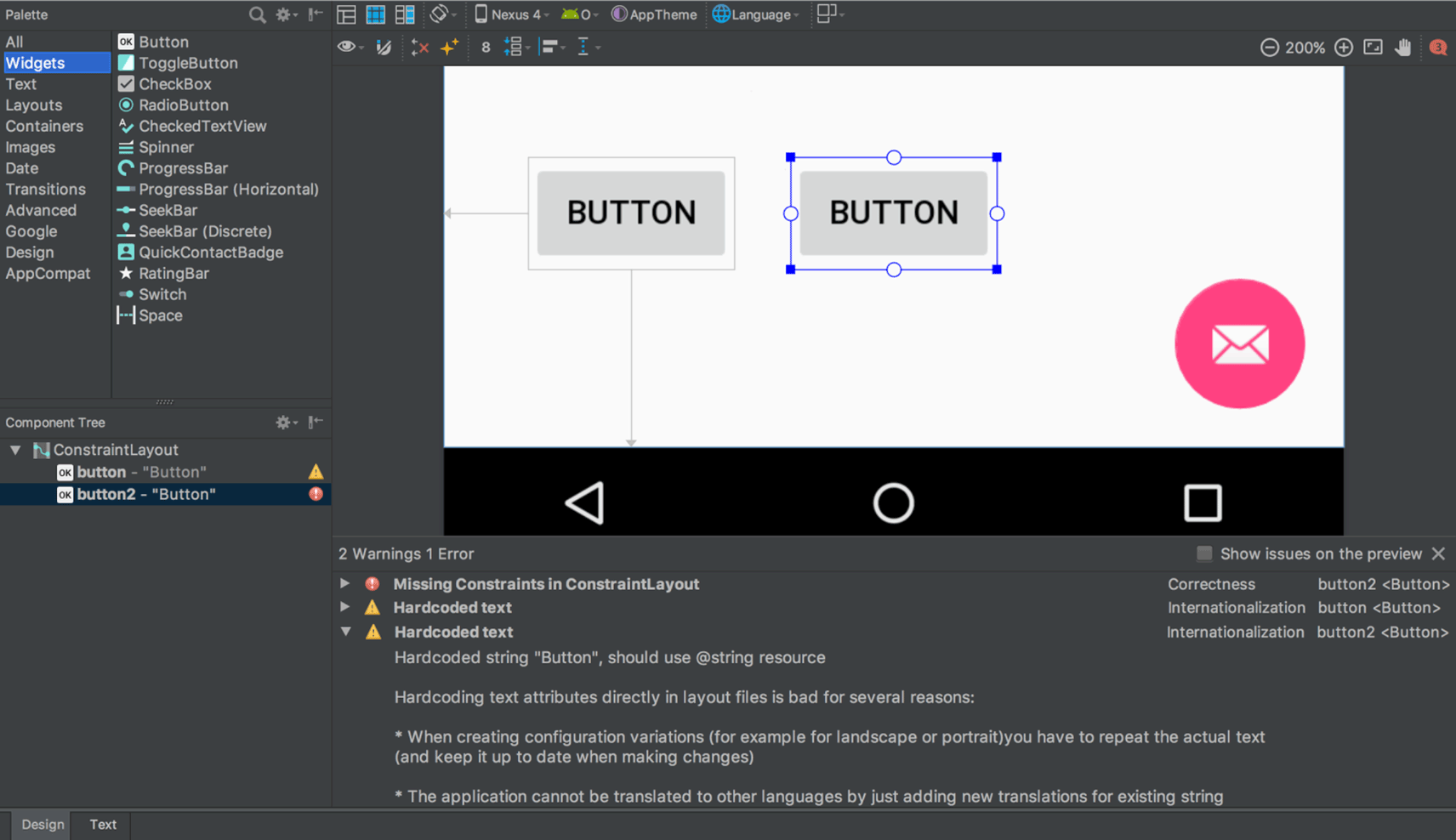
লেআউট ইন্সপেক্টর
লেআউট ইন্সপেক্টরটিতে আপনার অ্যাপ লেআউটের সমস্যাগুলি ডিবাগ করা সহজ করার জন্য উন্নত বৈশিষ্ট্য অন্তর্ভুক্ত রয়েছে, যার মধ্যে রয়েছে সাধারণ বিভাগে বৈশিষ্ট্যগুলিকে গোষ্ঠীভুক্ত করা এবং ভিউ ট্রি এবং প্রোপার্টিজ প্যান উভয় ক্ষেত্রেই নতুন অনুসন্ধান কার্যকারিতা।
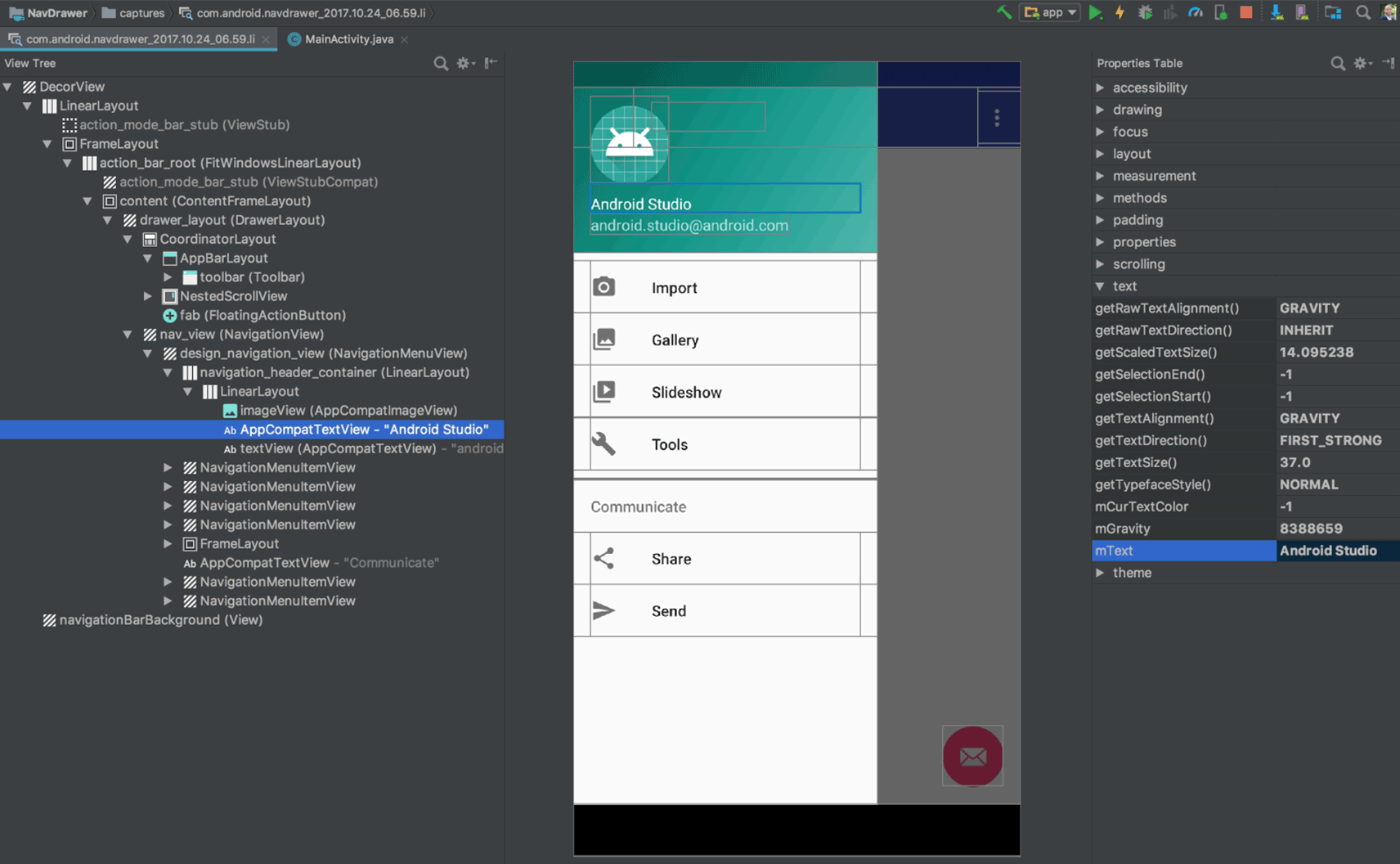
APK বিশ্লেষক
আপনি এখন apkanalyzer টুলের সাহায্যে কমান্ড লাইন থেকে APK বিশ্লেষক ব্যবহার করতে পারেন।
APK অ্যানালাইজারটি নিম্নলিখিত উন্নতিগুলির সাথে আপডেট করা হয়েছে:
- ProGuard দিয়ে তৈরি APK গুলির জন্য, আপনি ProGuard ম্যাপিং ফাইলগুলি লোড করতে পারেন যা DEX ভিউয়ারে ক্ষমতা যোগ করে, যার মধ্যে রয়েছে:
- কোড সঙ্কুচিত করার সময় নোডগুলি সরানো উচিত নয় তা বোঝাতে নোডগুলিকে বোল্ড করা হয়েছে।
- সঙ্কুচিত প্রক্রিয়ার সময় সরানো নোডগুলি দেখানোর জন্য একটি বোতাম।
- একটি বোতাম যা ট্রি ভিউতে থাকা নোডগুলির আসল নামগুলি পুনরুদ্ধার করে যা ProGuard দ্বারা অস্পষ্ট করা হয়েছিল।
- DEX ভিউয়ার এখন প্রতিটি প্যাকেজ, ক্লাস এবং পদ্ধতির আনুমানিক আকারের প্রভাব দেখায়।
- ক্ষেত্র এবং পদ্ধতিগুলি দেখানো এবং লুকানোর জন্য উপরে নতুন ফিল্টারিং বিকল্প।
- ট্রি ভিউতে, DEX ফাইলে সংজ্ঞায়িত নয় এমন রেফারেন্স নোডগুলি ইটালিক হরফে প্রদর্শিত হয়।
আরও তথ্যের জন্য, APK বিশ্লেষক দিয়ে আপনার বিল্ড বিশ্লেষণ করুন দেখুন।
D8 DEX কম্পাইলারের প্রিভিউ
অ্যান্ড্রয়েড স্টুডিও 3.0-তে D8 নামে একটি ঐচ্ছিক নতুন DEX কম্পাইলার অন্তর্ভুক্ত রয়েছে। এটি অবশেষে DX কম্পাইলারকে প্রতিস্থাপন করবে, তবে আপনি এখনই নতুন D8 কম্পাইলারটি ব্যবহার করতে পারেন।
DEX কম্পাইলেশন সরাসরি আপনার অ্যাপের বিল্ড টাইম, .dex ফাইল সাইজ এবং রানটাইম পারফর্ম্যান্সের উপর প্রভাব ফেলে। এবং নতুন D8 কম্পাইলারকে বর্তমান DX কম্পাইলারের সাথে তুলনা করলে, D8 দ্রুত কম্পাইল করে এবং ছোট .dex ফাইল আউটপুট করে, একই বা আরও ভালো অ্যাপ রানটাইম পারফর্ম্যান্স থাকে।
এটি চেষ্টা করার জন্য, আপনার প্রকল্পের gradle.properties ফাইলে নিম্নলিখিতগুলি সেট করুন:
android.enableD8=true
আরও তথ্যের জন্য, D8 কম্পাইলার সম্পর্কে ব্লগ পোস্টটি দেখুন।
গুগলের ম্যাভেন রিপোজিটরি
অ্যান্ড্রয়েড স্টুডিও এখন অ্যান্ড্রয়েড সাপোর্ট লাইব্রেরি, গুগল প্লে সার্ভিসেস, ফায়ারবেস এবং অন্যান্য নির্ভরতার জন্য আপডেট পেতে অ্যান্ড্রয়েড এসডিকে ম্যানেজারের উপর নির্ভর করার পরিবর্তে ডিফল্টরূপে গুগলের ম্যাভেন রিপোজিটরি ব্যবহার করে। এটি আপনার লাইব্রেরিগুলিকে আপ টু ডেট রাখা সহজ করে তোলে, বিশেষ করে যখন একটি ক্রমাগত ইন্টিগ্রেশন (CI) সিস্টেম ব্যবহার করা হয়।
এখন থেকে সকল নতুন প্রজেক্টে ডিফল্টভাবে গুগল ম্যাভেন রিপোজিটরি অন্তর্ভুক্ত থাকবে। আপনার বিদ্যমান প্রজেক্ট আপডেট করতে, টপ-লেভেল build.gradle ফাইলের repositories ব্লকে google() যোগ করুন:
allprojects {
repositories {
google()
}
}
গুগলের ম্যাভেন রিপোজিটরি সম্পর্কে আরও জানুন এখানে ।
Other changes
- অ্যান্ড্রয়েড স্টুডিওর সাথে নেটিভ ডিবাগিং আর ৩২-বিট উইন্ডোজ সমর্থন করে না। আমরা অন্যান্য প্ল্যাটফর্মগুলিতে ফোকাস করার সিদ্ধান্ত নিয়েছি কারণ খুব কম ডেভেলপারই এই প্ল্যাটফর্মটি ব্যবহার করছেন। আপনি যদি ৩২-বিট উইন্ডোজ ব্যবহার করেন এবং নেটিভ কোড ডিবাগ করার পরিকল্পনা করেন, তাহলে আপনার অ্যান্ড্রয়েড স্টুডিও ২.৩ ব্যবহার করা চালিয়ে যাওয়া উচিত।
- Upgraded the base IDE to IntelliJ 2017.1.2 , which adds a number of new features from 2016.3 and 2017.1 , such as Java 8 language refactoring, parameter hints, semantic highlighting, draggable breakpoints, instant results in search, and much more.
- অনেক নতুন লিন্ট চেক যোগ করা হয়েছে।
- এছাড়াও সর্বশেষ অ্যান্ড্রয়েড এমুলেটর আপডেটগুলি দেখুন।
2.3 (March 2017)
অ্যান্ড্রয়েড স্টুডিও ২.৩.০ মূলত একটি বাগ ফিক্স এবং স্থিতিশীলতা রিলিজ, তবে এতে বেশ কিছু নতুন বৈশিষ্ট্যও অন্তর্ভুক্ত রয়েছে।
২.৩.৩ (জুন ২০১৭)
এটি অ্যান্ড্রয়েড ও (এপিআই লেভেল ২৬) এর জন্য সমর্থন যোগ করার জন্য একটি ছোটখাটো আপডেট।
২.৩.২ (এপ্রিল ২০১৭)
নিম্নলিখিত পরিবর্তনগুলির জন্য এটি অ্যান্ড্রয়েড স্টুডিও 2.3 এর একটি ছোটখাটো আপডেট:
- সিস্টেম ইমেজে গুগল প্লে সাপোর্ট করার জন্য AVD ম্যানেজার আপডেট।
- NDK-এর R14+ ব্যবহার করার সময় NDK বিল্ডের বাগ সংশোধন করা হয়েছে।
অ্যান্ড্রয়েড এমুলেটর 26.0.3 এর জন্য সংশ্লিষ্ট আপডেটগুলিও দেখুন।
২.৩.১ (এপ্রিল ২০১৭)
এটি অ্যান্ড্রয়েড স্টুডিও 2.3 এর একটি ছোট আপডেট যা এমন একটি সমস্যার সমাধান করে যেখানে কিছু ভৌত অ্যান্ড্রয়েড ডিভাইস ইনস্ট্যান্ট রানের সাথে সঠিকভাবে কাজ করেনি ( ইস্যু #235879 দেখুন)।
<h3 class="hide-from-toc">
New
</h3>
<div class="video-wrapper-left">
<iframe class="devsite-embedded-youtube-video" data-video-id="VFyKclKBGf0"
data-autohide="1" data-showinfo="0" frameborder="0" allowfullscreen>
</iframe>
</div>
<ul>
<li>Android Studio can now convert PNG, BMP, JPG, and static GIF files to
WebP format. WebP is an image file format from Google that provides lossy
compression (like JPEG) as well as transparency (like PNG) but can provide
better compression than either JPEG or PNG. For more information, see
<a href="/studio/write/convert-webp.html">Convert images to WebP in Android
Studio</a>.
</li>
<li>The new <a href="/studio/write/app-link-indexing.html">App Links
Assistant</a> simplifies the process of adding Android App Links to your app
into a step-by-step wizard. Android App Links are HTTP URLs that bring users
directly to specific content in your Android app.
</li>
<li>The Layout Editor now includes support for two new ConstraintLayout
features:
<ul>
<li>Define a view size based on an aspect ratio.
</li>
<li>Create packed, spread, and weighted linear groups with constraint
chains.
</li>
</ul>
For more information, see <a href=
"/training/constraint-layout/index.html">Build a Responsive UI with
ConstraintLayout</a>.
</li>
<li>The Layout Editor also now lets you create a list of <a href=
"/studio/write/layout-editor.html#edit-properties">favorite attributes</a> so
you don't have to click <b>View all attributes</b> to access the attributes
you use most.
</li>
<li>When adding a material icon using the Vector Import Dialog (<b>File >
New > Vector Asset</b>), you can now filter the list of available icons by
category or by icon name. For more information, see <a href=
"/studio/write/vector-asset-studio.html#materialicon">Adding a material
icon</a>.
</li>
<li>
<a href="/studio/write/annotations.html#accessibility">New and updated
annotations</a>. The new <code>@RestrictTo</code> annotation for methods,
classes, and packages lets you restrict an API. The updated
<code>@VisibleForTesting</code> annotation now has an optional
<code>otherwise</code> argument that lets you designate what the visibility
of a method should be if not for the need to make it visible for testing.
Lint uses the <code>otherwise</code> option to enforce the intended
visibility of the method.
</li>
<li>New <a href="/studio/write/lint.html#snapshot">lint baseline support</a>
allows you to use a snapshot of your project's current set of warnings as a
baseline for future inspection runs so only new issues are reported. The
baseline snapshot lets you start using lint to fail the build for new issues
without having to go back and address all existing issues first.
</li>
<li>New lint checks, including the following:
<ul>
<li>Obsolete <code>SDK_INT</code> Checks: Android Studio removes obsolete
code that checks for SDK versions.
</li>
<li>Object Animator Validation: Lint analyzes your code to make sure that
your <code>ObjectAnimator</code> calls reference valid methods with the
right signatures and checks that those methods are annotated with <code>
@Keep</code> to prevent ProGuard from renaming or removing them during
release builds.
</li>
<li>Unnecessary Item Decorator Copy: Older versions of the
<code>RecyclerView</code> library did not include a divider decorator
class, but one was provided as a sample in the support demos. Recent
versions of the library have a divider decorator class. Lint looks for
the old sample and suggests replacing it with the new one.
</li>
<li>WifiManager Leak: Prior to Android 7.0 (API level 24), initializing
the <code>WifiManager</code> with <code><a href="/reference/android/content/Context.html#getSystemService(java.lang.Class<T>)">Context.getSystemService()</a></code>
can cause a memory leak if the context is not the application context.
Lint looks for these initializations, and if it <em>cannot</em> determine
that the context is the application context, it suggests you use <code><a href="/reference/android/content/Context.html#getApplicationContext()">Context.getApplicationContext()</a></code> to get the proper context for the
initialization.
</li>
<li>Improved Resource Prefix: The existing <code>resourcePrefix</code>
lint check had many limitations. You can now configure your project with
a prefix, such as <code>android { resourcePrefix '<var>my_lib</var>'
}</code>, and lint makes sure that all of your resources are using this
prefix. You can use variations of the name for styles and themes. For
example for the <var>my_lib</var> prefix, you can have themes named
<code>MyLibTheme</code>, <code>myLibAttr</code>,
<code>my_lib_layout</code>, and so on.
</li>
<li>Switch to WebP: This check identifies images in your project that can
be converted to WebP format based on your project’s
<code>minSdkVersion</code> setting. An associated quickfix can
automatically convert the images, or you can <a href=
"/studio/write/convert-webp.html">convert images to WebP</a> manually.
</li>
<li>Unsafe WebP: If your project already includes WebP images, this check
analyzes your project to ensure that your <code>minSdkVersion</code>
setting is high enough to support the included images. For more
information about WebP support in Android and Android Studio, see
<a class="external" href=
"https://developers.google.com/speed/webp/faq#which_web_browsers_natively_support_webp">
Which browsers natively support WebP?</a> and <a href=
"/studio/write/convert-webp.html">Create WebP Images Using Android
Studio</a>.
</li>
</ul>
</li>
</ul>
<h3 class="hide-from-toc">
Changes
</h3>
<ul>
<li>A separate button to push changes with Instant Run: After deploying your
app, you now click <b>Apply Changes</b> <img src=
"/studio/images/buttons/toolbar-apply-changes.svg" alt="" class=
"inline-icon"> to quickly push incremental changes to your running app using
Instant Run. The <b>Run</b> <img src="/studio/images/buttons/toolbar-run.png"
alt="" class="inline-icon"> and <b>Debug</b> <img src=
"/studio/images/buttons/toolbar-debug.png" alt="" class="inline-icon">
buttons are always available to you when you want to reliably push your
changes and force an app restart.
<ul>
<li>Instant Run is supported only when deploying your app to a target
device running Android 5.0 (API level 21) or higher.
</li>
<li>Instant Run is no longer disabled for projects that <a href=
"/studio/projects/add-native-code.html">link to external native
projects</a> using CMake or ndk-build. However, you can only use Instant
Run to push incremental changes to your Java code, not your native code.
</li>
<li>Cold swaps (which you can force for a running app by clicking
<strong>Run</strong> <img src="/studio/images/buttons/toolbar-run.png"
alt="" class="inline-icon">) are now more reliable. Forcing a cold swap
also fixes the issue where changes to notification and widget UIs were
not updated on the target device.
</li>
<li>Includes optimizations that make app startup much faster. These
optimizations may affect profiling, so you should temporarily <a href=
"/studio/run/index.html#disable-ir">disable Instant Run</a> whenever
profiling your app.
</li>
</ul>
</li>
<li>
<p>
The <b>AVD Manager</b> <img src=
"/studio/images/buttons/toolbar-avd-manager.png" alt="" class=
"inline-icon"> and <b>SDK Manager</b> <img src=
"/studio/images/buttons/toolbar-sdk-manager.png" alt="" class=
"inline-icon"> buttons are now included in the lean Navigation Bar as
well as the full Toolbar. To use the lean Navigation Bar, click
<b>View</b> to open the View menu, then ensure that <b>Navigation Bar</b>
is selected and <b>Toolbar</b> is <em>not</em> selected.
</p>
<img src="/studio/images/releases/navigationbar_sdkavd_2x.png" width="757">
</li>
<li>The "Hybrid" debugger has been renamed to "Dual" debugger.
</li>
<li>In the <a href="/studio/run/rundebugconfig.html">Run/Debug
Configurations</a> dialog, under Defaults in the left pane, the following run
configuration names have changed with no behavior changes:
<ul>
<li>The JUnit name has changed to Android JUnit. If you have a project
that uses JUnit run configurations, those configurations are transformed
to Android JUnit run configurations the first time you open the project
with Android Studio. A dialog appears to inform you of the name change.
</li>
<li>The Android Tests name has changed to Android Instrumented Tests.
</li>
</ul>
</li>
<li>The <a href="/studio/debug/am-gpu-debugger.html">GPU Debugger</a> has
been removed from Android Studio as of version 2.3. An open-source,
standalone version of the tool is now available on <a href=
"https://github.com/google/gapid" class="external-link">GitHub</a>.
</li>
<li>The Run/Debug option is no longer available when you right-click a <code>
*.gradle build</code> script.
</li>
<li>All templates now use <code>ConstraintLayout</code> as the default
layout.
</li>
<li>The Widgets palette in the Layout Editor has been redesigned.
</li>
</ul>
<p>
This release also includes a number of bug fixes. <a href=
"https://code.google.com/p/android/issues/list?can=1&q=target%3D2.3+status%3DReleased&colspec=ID+Status+Priority+Owner+Summary+Stars+Reporter+Opened&cells=tiles">
See all bug fixes in 2.3.0.</a>
</p>
<p class="note">
<b>Known issue:</b> Some device manufacturers block apps from automatically
launching after being installed on the device. When deploying your app to a
physical device using Android Studio 2.3, this restriction breaks the
intended behavior of Instant Run and causes the following error output:
<code>Error: Not found; no service started</code>. To avoid this issue,
either <a href="/studio/run/emulator.html">use the emulator</a> or enable
automatic launching for your app in your device's settings. The procedure
for doing this is different for each device, so check the instructions
provided by the manufacturer. To learn more about this issue, see
<a href="https://code.google.com/p/android/issues/detail?id=235879">Issue
#235879</a>.
</p>
2.2 (September 2016)
২.২.৩ (ডিসেম্বর ২০১৬)
<p>
This is a minor update to Android Studio 2.2. It includes a bug fixes
focused around gradle, the core IDE, and lint.
</p>
<p>
Highlighted build changes:
</p>
<ul>
<li>ProGuard version rollback. Due to a <a href=
"https://sourceforge.net/p/proguard/bugs/625/">correctness issue</a>
discovered in ProGuard 5.3.1, we have rolled back to ProGuard 5.2.1. We
have worked with the ProGuard team on getting a fix quickly, and we expect
to roll forward to ProGuard 5.3.2 in Android Studio 2.3 Canary 3.
</li>
<li>Bug fix for <code>aaptOptions</code> <code>IgnoreAssetsPattern</code>
not working properly (<a href="http://b.android.com/224167">issue
224167</a>)
</li>
<li>Bug fix for Gradle autodownload for Constraint Layout library
(<a href="https://code.google.com/p/android/issues/detail?id=212128">issue
212128</a>)
</li>
<li>Bug fix for a JDK8/Kotlin compiler + dx issue (<a href=
"http://b.android.com/227729">issue 227729</a>)
</li>
</ul>
<p>
<a href=
"https://code.google.com/p/android/issues/list?can=1&q=target%3D2.2.3+status%3AReleased+&colspec=ID+Status+Priority+Owner+Summary+Stars+Reporter+Opened&cells=tiles">
See all bug fixes in 2.2.3</a>.
</p>
২.২.২ (অক্টোবর ২০১৬)
<p>
This is a minor update to Android Studio 2.2. It includes a number of small
changes and bug fixes, including:
</p>
<ul>
<li>When reporting Instant Run issues through the IDE, the report now also
includes logcat output for <code>InstantRun</code> events. To help us
improve Instant Run, please <a href=
"/studio/run/index.html#submit-feedback">enable extra logging and report
any issues</a>.
</li>
<li>A number of small bug fixes for Gradle.
</li>
<li>A fix for problems with generating multiple APKs.
</li>
</ul>
২.২.১ (অক্টোবর ২০১৬)
<p>
This is a minor update to Android Studio 2.2. It includes several bug fixes
and a new feature to enable extra logging to help us troubleshoot Instant
Run issues—to help us improve Instant Run, please <a href=
"/studio/run/index.html#submit-feedback">enable extra logging and report
any issues</a>.
</p>
নতুন
- ConstraintLayout সমর্থন করার জন্য কাস্টম-বিল্ট টুল সহ সম্পূর্ণ নতুন লেআউট এডিটর ।
<li>New <strong><a href=
"http://tools.android.com/tech-docs/layout-inspector">Layout
Inspector</a></strong> lets you examine snapshots of your layout hierarchy
while your app is running on the emulator or a device.
</li>
<li>New <strong><a href="/studio/write/firebase.html">Assistant</a></strong>
window to help you integrate Firebase services into your app.
</li>
<li>New <strong><a href="/studio/debug/apk-analyzer.html">APK
Analyzer</a></strong> tool so you can inspect the contents of your packaged
app.
</li>
<li>New <strong><a href=
"http://tools.android.com/tech-docs/test-recorder">Espresso Test
Recorder</a></strong> tool (currently in beta) to help you create UI tests by
recording your own interactions.
</li>
<li>New <strong><a href=
"http://tools.android.com/tech-docs/build-cache">build cache</a></strong>
(currently experimental) to speed up build performance.
</li>
<li>New <strong>C/C++ build integration with CMake and ndk-build</strong>.
Compile and build new or existing native code into libraries packaged into
your APK, and debug using lldb. For new projects, Android Studio uses CMake
by default, but also supports ndk-build for existing projects. To learn how
to include native code in your Android application, read <a href=
"/studio/projects/add-native-code.html">Add C and C++ Code to Your
Project</a>. To learn how to debug native code with lldb, see <a href=
"/studio/debug/index.html#debug-native">Debug Native Code</a>.
</li>
<li>New <strong><a href="/studio/intro/index.html#sample-code">Samples
Browser</a></strong> so you can easily look up Google Android sample code
from within Android Studio to jump start app development.
</li>
<li>New <strong>Merged Manifest Viewer</strong> to help you diagnose how your
manifest file merges with your app dependencies across project build
variants.
</li>
<li>The <strong>Run</strong> window now contains log messages for the current
running app. Note that you can configure the <a href=
"/studio/debug/am-logcat.html">logcat Monitor</a> display, but not the
<strong>Run</strong> window.
</li>
<li>New <strong><a href="/studio/run/emulator.html">Android
Emulator</a></strong> features:
<ul>
<li>Added new <strong>Virtual</strong> <strong>Sensors</strong> and
<strong>Cellular</strong> > <strong>Signal Strength</strong> controls.
</li>
<li>Added an <strong>LTE</strong> option to the <strong>Cellular</strong>
> <strong>Network type</strong> control.
</li>
<li>Added simulated vertical swipes for scrolling through vertical menus
with a mouse wheel.
</li>
</ul>
</li>
<li>New <strong><a href="/studio/run/rundebugconfig.html">Run/Debug
Configuration</a></strong> features:
<ul>
<li>The <strong>Debugger</strong> tab of the Android App and Android
Tests templates now contain several new options for debugging with LLDB.
</li>
<li>The <strong>Profiling</strong> tab of the Android App and Android
Tests templates now contain a <strong>Capture GPU Commands</strong>
option for enabling GPU tracing. You can display GPU traces in the GPU
Debugger (a beta feature).
</li>
<li>The Android Tests template now has a <strong>Firebase Test Lab Device
Matrix</strong> option for the <strong>Deployment Target</strong>.
</li>
<li>The Native Application template has been deprecated. If you use this
template in a project, Android Studio automatically converts it to the
Android App template.
</li>
<li>The Android Application template has been renamed to Android App.
</li>
</ul>
</li>
<li>Improved installation, configuration, performance, and UI features in the
<strong><a href="/studio/debug/am-gpu-debugger.html">GPU
Debugger</a></strong> (currently in beta).
</li>
<li>Android Studio now comes bundled with <strong>OpenJDK 8</strong>.
Existing projects still use the JDK specified in <strong>File > Project
Structure > SDK Location</strong>. You can switch to use the new bundled
JDK by clicking <strong>File > Project Structure > SDK
Location</strong> and checking the <strong>Use embedded JDK</strong>
checkbox.
</li>
<li>Added new <strong>help menus and buttons</strong> in the UI so you can
more easily find the online documentation.
</li>
Changes
- IDE কোডবেস IntelliJ 15 থেকে IntelliJ 2016.1 এ আপডেট করা হয়েছে।
- ইনস্ট্যান্ট রানের জন্য এখন টার্গেট ডিভাইস API স্তরের সাথে সম্পর্কিত প্ল্যাটফর্ম SDK ইনস্টল করা প্রয়োজন।
- ব্যবহারকারী যদি কোনও কাজের প্রোফাইলের অধীনে বা গৌণ ব্যবহারকারী হিসাবে অ্যাপটি চালাচ্ছেন তবে তাৎক্ষণিক রান স্বয়ংক্রিয়ভাবে অক্ষম হয়ে যাবে।
- ইনস্ট্যান্ট রানের জন্য অনেক নির্ভরযোগ্যতা সমস্যা সমাধান করা হয়েছে যেখানে পরিবর্তনগুলি স্থাপন করা হচ্ছিল না বা অ্যাপটি ক্র্যাশ হয়ে যেত:
- আপনার চলমান অ্যাপে কিছু অ্যাপ অ্যাসেট স্থাপন করা হয়নি। ( বাগ: #213454 )
- ব্যবহারকারী যখন ইনস্ট্যান্ট রান এবং নন-ইনস্ট্যান্ট রান সেশনের মধ্যে ট্রানজিশন করে, যেখানে সিরিয়ালাইজেবল ক্লাসে সিরিয়ালভার্সনইউআইডি সংজ্ঞায়িত থাকে না, তখন অ্যাপটি ক্র্যাশ হয়ে যায়। ( বাগ: #209006 )
- ইন্সট্যান্ট রানের মাধ্যমে স্টাইলের পরিবর্তনগুলি প্রতিফলিত হয় না। ( বাগ: #210851 )
- ইনস্ট্যান্ট রান সেশন অবিশ্বস্ত এবং FileNotFoundException সৃষ্টি করে। ( বাগ: #213083 )
- কিটক্যাটের সম্পূর্ণ পুনর্নির্মাণ না হওয়া পর্যন্ত ড্রয়েবলের পরিবর্তনগুলি প্রতিফলিত হবে না। ( বাগ: #21530 )
- কাস্টম সোর্সসেটগুলিতে নেস্টেড পাথ থাকলে ইনস্ট্যান্ট রানের মাধ্যমে রিসোর্স পরিবর্তনগুলি প্রতিফলিত হয় না। ( বাগ: #219145 )
- পরিবর্তিত ক্লাসে enum মান সহ টীকা থাকলে গরম এবং উষ্ণ সোয়াপ কাজ করে না। ( বাগ: #209047 )
- ইনস্ট্যান্ট রানের মাধ্যমে অ্যানোটেশন ডেটাতে পরিবর্তনগুলি প্রতিফলিত হয় না। ( বাগ: #210089 )
- IDE এর বাইরে পরিবর্তন করলে Instant Run কোডের পরিবর্তনগুলি গ্রহণ করে না। ( বাগ: #213205 )
- নিরাপত্তা টোকেনের অমিলের কারণে ইনস্ট্যান্ট রান সেশনটি অবিশ্বস্ত। ( বাগ: #211989
- যেসব ডিভাইস সঠিকভাবে রান-অ্যাস সমর্থন করে না, তাদের ক্ষেত্রে কোল্ড সোয়াপ ব্যর্থ হয়। ( বাগ: #210875 )
- তাৎক্ষণিকভাবে রান রিস্টার্ট করার পর অ্যাপ ক্র্যাশ। ( বাগ: #219744 )
- ইনস্ট্যান্ট রান থেকে ইনস্ট্যান্ট ডিবাগে স্যুইচ করার সময় ClassNotFoundException পরিলক্ষিত হয়েছে। ( বাগ: #215805 )
<li>Improved performance for <strong>Gradle sync</strong> within the IDE,
especially for large projects.
</li>
<li>Improved build times for both full and incremental builds with new app
packaging code.
</li>
<li>Improved <strong>Jack compiler performance and features</strong>,
including support for annotation processors and dexing in process. To learn
more, read the <a href=
"/studio/releases/gradle-plugin.html#revisions">Android plugin for Gradle
2.2.0 release notes</a>.
</li>
<li>Removed the <strong>Scale</strong> AVD property from the AVD Manager.
</li>
<li>The Android Emulator <strong>-port</strong> and <strong>-ports</strong>
command-line options now report which ports and serial number the emulator
instance is using, and warn if there are any issues with the values you
provided.
</li>
<li>Improved the <strong><a href=
"/studio/write/create-java-class.html">Create New Class dialog</a></strong>
and the corresponding file templates. <strong>Note:</strong> If you've
previously customized the <strong>AnnotationType</strong>,
<strong>Class</strong>, <strong>Enum</strong>, <strong>Interface</strong>, or
<strong>Singleton</strong> file templates, you need to modify your templates
to comply with the new templates or you won’t be able to use the new fields
in the <strong>Create New Class</strong> dialog.
</li>
<li>Improved the <strong><a href=
"/studio/write/vector-asset-studio.html">Vector Asset Studio</a></strong>
user interface and added support for Adobe Photoshop Document (PSD) files.
</li>
<li>Improved the <strong><a href=
"/studio/write/image-asset-studio.html">Image Asset Studio</a></strong> user
interface.
</li>
<li>Improved the <strong>Theme Editor</strong>'s Resource Picker.
</li>
<li>Fixed memory leaks and reduced overall memory usage in Android Studio.
</li>
<li>Added a <strong>Background</strong> button in the <strong><a href=
"/studio/intro/update.html#sdk-manager">SDK Manager</a></strong> so you can
get back to work and install your packages in the background.
</li>
<li>Improved <strong><a href="/studio/intro/accessibility.html">Accessibility
features</a></strong>, including support for screen readers and keyboard
navigation.
</li>
<li>Enhanced <strong>Code Analysis</strong> includes code quality checks for
Java 8 language usage and more cross-file analysis.
</li>
<li>Several toolbar icons have changed.
</li>
2.1 (April 2016)
The primary changes in this update provide support for development with the Android N Preview.
2.1.3 (August 2016)
This update adds compatibility with Gradle 2.14.1, which includes performance improvements, new features, and an important security fix . For more details, see the Gradle release notes .
By default, new projects in Android Studio 2.1.3 use Gradle 2.14.1. For existing projects, the IDE prompts you to upgrade to Gradle 2.14.1 and Android plugin for Gradle 2.1.3 , which is required when using Gradle 2.14.1 and higher.
2.1.2 (June 2016)
This update includes a number of small changes and bug fixes:
- Instant Run updates and bug fixes.
- Improvements to LLDB performance and crash notifications.
- Fixed a regression in the Android Studio 2.1.1 security update that caused
git rebaseto fail.
2.1.1 (May 2016)
Security release update.
The Android N platform adds support for Java 8 language features , which require a new experimental compiler called Jack. The latest version of Jack is currently supported only in Android Studio 2.1. So if you want to use Java 8 language features, you need to use Android Studio 2.1 to build your app.
Note: Instant Run is disabled when you enable the Jack compiler because they currently are not compatible.
Although Android Studio 2.1 is now stable, the Jack compiler is still experimental and you must enable it with the jackOptions property in your build.gradle file.
Other than the changes to support the N Preview, Android Studio 2.1 includes minor bug fixes and the following enhancements:
- The Java-aware C++ debugger is now enabled by default when you're using an N device or emulator and select Native debugger mode (in the Debugger tab for your run/debug configuration).
For other build enhancements, including incremental Java compilation and dexing-in-process,update your Android plugin for Gradle to version 2.1.0.
2.0 (April 2016)
Note: If you are developing for the N Developer Preview, you should use Android Studio 2.1 Preview. Android Studio 2.0 does not support all the features required to target the N Preview.
Instant Run :
- Android Studio now deploys clean builds faster than ever before. Additionally, pushing incremental code changes to the emulator or a physical device is now almost instantaneous. Review your updates without redeploying a new debug build or, in many cases, without restarting the app.
- Instant Run supports pushing the following changes to a running app:
- Changes to the implementation of an existing instance method or static method
- Changes to an existing app resource
- Changes to structural code, such as a method signature or a static field (requires a target device running API level 21 or higher).
- Read the documentation to learn more about Instant Run .
Note: Instant Run is supported only when you deploy the debug build variant, use Android plugin for Gradle version 2.0.0 or higher, and configure your app's module-level
build.gradlefile forminSdkVersion 15or higher. For the best performance, configure your app forminSdkVersion 21or higher.
New additions to Lint:
- Inspection of
switchstatements using@IntDefannotated integers to make sure all constants are handled. To quickly add any missing statements, use the intention action drop-down menu and select Add Missing @IntDef Constants . - Flags for incorrect attempts to use string interpolation to insert version numbers in the
build.gradlefile. - Flags for anonymous classes that extend the
Fragmentclass. - Flags for native code in unsafe locations, such as the
res/andasset/folders. This flag encourages storing native code in thelibs/folder, which is then securely packaged into the application'sdata/app-lib/folder at install time. AOSP: #169950 - Flags for unsafe calls to
Runtime.load()andSystem.load()calls. AOSP: #179980 - Find and remove any unused resources by selecting Refactor > Remove Unused Resources from the menu bar. Unused resource detection now supports resources only referenced by unused resources, references in raw files such as
.htmlimage references, andtools:keepandtools:discardattributes used by the Gradle resource shrinker, while considering inactive source sets (such as resources used in other build flavors) and properly handling static field imports. - Checks that implicit API references are supported on all platforms targeted by
minSdkVersion. - Flags improper usage of
RecyclerViewandParcelable. -
@IntDef,@IntRange, and@Sizeinspections are now also checked forintarrays and varargs.
Additional Improvements :
- Optimized for Android Emulator 2.0, which is faster than ever before, supports a wider range of virtual devices, and features a drastically improved UI. To learn more about the new emulator, read the SDK Tools release notes .
- Improvements to the Android Virtual Device Manager :
- System images are now categorized under the following tabs: Recommended , x86 , and Other .
- Under advanced settings, you can enable multi-core support and specify the number of cores the emulator can use.
- Under advanced settings, you can determine how graphics are rendered on the emulator by selecting one of the following options:
- Hardware: use you computer's graphics card for faster rendering.
- Software: use software-based rendering.
- Auto: let the emulator decide the best option. This is the default setting.
- Improved AAPT packaging times by specifying deploy target before the app is built. This allows Android Studio to efficiently package only the resources required by the specified device.
- Added Cloud Test Lab integration to provide on-demand app testing with the convenience and scalability of a cloud service. Learn more about how you can use Cloud Test Lab with Android Studio .
- Added a preview of the new GPU Debugger . For graphics intensive applications, you can now visually step through your OpenGL ES code to optimize your app or game.
- Added Google App Indexing Test. Add support for URLs, app indexing, and search functionality to your apps to help drive more traffic to your app, discover which app content is used most, and attract new users. Test and validate URLs in your app all within Android Studio. See Supporting URLs and App Indexing in Android Studio .
- Upgrades from the latest IntelliJ 15 release, including improved code analysis and performance. See What's New in IntelliJ for a complete description of the new features and enhancements.
- XML editor auto-complete now adds quotations marks when completing attributes. To check if this option is enabled, open the Setting or Preferences dialogue, navigate to Editor > General > Smart Keys , and check the box next to Add quotes for attribute value on attribute completion . Issue: 195113
- The XML editor now supports code completion for data binding expressions.
অ্যান্ড্রয়েড স্টুডিও সংস্করণ ১.৫.১ (ডিসেম্বর ২০১৫)
সংশোধন এবং বর্ধন:
- লেআউট এডিটরে রেন্ডারিং ব্যর্থতার সমস্যা সমাধান করা হয়েছে। সমস্যা: 194612
- কনফিগারেশন অনুসারে
descriptionম্যানিফেস্ট বৈশিষ্ট্যগুলি পরিবর্তন করার ক্ষমতা যুক্ত করা হয়েছে। ইস্যু: 194705 - ভেক্টর অ্যাসেট স্টুডিওতে অ্যান্ড্রয়েড স্টুডিও ডারকুলা অ্যাপিয়ারেন্স থিমের কন্ট্রাস্ট উন্নত করা হয়েছে। ইস্যু: ১৯১৮১৯
- ভেক্টর অ্যাসেট স্টুডিওতে সহায়তা বোতাম সমর্থন যোগ করা হয়েছে।
- ডেটা বাইন্ডিংয়ের জন্য
%অপারেটরের জন্য সমর্থন যোগ করা হয়েছে। ইস্যু: 194045 - ডিবাগিংয়ের জন্য একটি অ্যাপ চালু করার ফলে ডিবাগারটি ভুল ডিভাইসের সাথে সংযুক্ত হওয়ার একটি সমস্যা সমাধান করা হয়েছে। সমস্যা: 195167
- নির্দিষ্ট পরিস্থিতিতে অ্যাপ চালানোর চেষ্টা করার সময় ঘটতে পারে এমন একটি নাল পয়েন্টার ব্যতিক্রম ঠিক করা হয়েছে।
Android Studio v1.5.0 (November 2015)
সংশোধন এবং বর্ধন:
- Added new Memory Monitor analysis abilities to Android Monitor. When you view an HPROF file captured from this monitor, the display is now more helpful so you can more quickly locate problems, such as memory leaks. To use this monitor, click Android Monitor at the bottom of the main window. In Android Monitor, click the Memory tab. While the monitor is running, click the Dump Java Heap icon, and then click Captures in the main window and double-click the file to view it. Click Capture Analysis on the right. (The Android Device Monitor can't be running at the same time as Android Monitor.)
- Added new deep link and app link support. The Code Editor can automatically create an intent filter for deep linking in the
AndroidManifest.xmlfile. It can also generate code to help you integrate with the App Indexing API in an activity in a Java file. A deep link testing feature helps you verify that a specified deep link can launch an app. In the General tab of the Run/Debug Configurations dialog, you can specify deep link launch options. You can also test App Indexing API calls in an activity by using the Android Monitor logcat display. The Androidlinttool now has warnings for certain issues involving deep links and the App Indexing API. - Added the ability to use short names when code-completing custom views in the Code Editor.
- Added support for more
VectorDrawableelements to Vector Asset Studio for backward-compatibility. Vector Asset Studio can use these elements to convert vector drawables into PNG raster images to use with Android 4.4 (API level 20) and lower. - Added new
lintchecks for Android TV and Android Auto to give you immediate, actionable feedback in Android Studio, along with several quick fixes. For example, for Android TV, it can report and provide a quick fix for permissions, unsupported hardware,uses-featureelement, and missing banner issues. For Android Auto, it can validate the correct usage in the descriptor file referred from yourAndroidManifest.xmlfile, report if there isn't an intent filter for theMediaBrowserServiceclass, and identify certain voice actions issues. - Added new
lintchecks for insecure broadcast receivers,SSLCertificateSocketFactoryandHostnameVerifierclass uses, andFile.setReadable()andFile.setWritable()calls. It also detects invalid manifest resource lookups, especially for resources that vary by configuration. - Fixed a number of stability issues.
অ্যান্ড্রয়েড স্টুডিও সংস্করণ ১.৪.১ (অক্টোবর ২০১৫)
সংশোধন এবং বর্ধন:
- IDE পুনরায় চালু করার সময় অতিরিক্ত গ্রেডল সিঙ্কিং হতে পারে এমন একটি গ্রেডল মডেল ক্যাশিং সমস্যা সমাধান করা হয়েছে।
- একটি নেটিভ ডিবাগিং অচলাবস্থার সমস্যা সমাধান করা হয়েছে।
- সাবভার্সন ১.৯ ভার্সন কন্ট্রোল সিস্টেম ব্যবহারকারীদের ব্লক করার সমস্যা সমাধান করা হয়েছে।
- একটি ডিভাইস চয়নকারী ডায়ালগ সমস্যা সমাধান করা হয়েছে যেখানে অননুমোদিত ডিভাইস সংযোগ করার পরে আপনি আর এমুলেটর নির্বাচন করতে পারবেন না। সমস্যা: 189658
- যেসব লোকেলের জন্য একটি অঞ্চলের যোগ্যতা এবং অঞ্চলে একটি অনুবাদ আছে (কিন্তু বেস লোকেলে নয়) সেগুলির জন্য ভুল অনুবাদ ত্রুটি রিপোর্টিং ঠিক করা হয়েছে। সমস্যা: 188577
- থিম এডিটরের লেআউট এডিটরের সাথে ইন্টারঅ্যাকশন সম্পর্কিত একটি অচলাবস্থার সমস্যা সমাধান করা হয়েছে। সমস্যা: 188070
- থিম এডিটর রিলোড এবং এডিট দ্বন্দ্বের কারণে অ্যাট্রিবিউটগুলি সঠিকভাবে আপডেট না হওয়ার সমস্যা সমাধান করা হয়েছে। সমস্যা: 187726
- উন্নত থিম এডিটর কর্মক্ষমতা।
- ম্যানিফেস্টে
android:requiredঅ্যাট্রিবিউট উপেক্ষা করার সমস্যাটি সমাধান করা হয়েছে। সমস্যা: 187665
Android Studio v1.4.0 (September 2015)
সংশোধন এবং বর্ধন:
- Added the Vector Asset Studio tool for importing vector graphics, such as material icons and SVG files. To use this tool, in the Android view of the Project window, right-click the res folder and select New > Vector Asset .
- Added new Android Monitor functions, GPU and Network. To use these monitors, click Android Monitor at the bottom of the main window. The Android Device Monitor can't be running at the same time as Android Monitor.
- Added an early preview of the new Theme Editor. To use this feature, select Tools > Android > Theme Editor .
- Updated the Android templates for the Design Support Library. Templates now include support for the Material Design specification, as well as the
appcompatSupport Library for backwards compatibility.
Android Studio v1.3.2 (August 2015)
সংশোধন এবং বর্ধন:
- Added support for Android 6.0 (API level 23), including new icons and AVD Manager support for creating devices with new screen densities.
- Fixed an exception that was occurring during update checks. Issue: 183068
- Fixed problem where unresolved view coordinates could cause the layout editor to crash. Issue: 178690
- Fixed issue with invalid resource type warnings. Issue: 182433
- Fixed lint check that was incorrectly flagging resources as private. Issue: 183120
Android Studio v1.3.1 (August 2015)
সংশোধন এবং বর্ধন:
- Fixed support for creating an Android Wear Android Virtual Device (AVD) on Windows.
- Updated the Project Wizard to use the entered project name.
- Added support to allow the Android SDK to be stored in a read-only directory.
- Updated Android plugin for Gradle version to 1.3.0.
- Fixed issues with launching a debug session from the Android Debug Bridge (adb) Unix shell.
- Fixed the Java package renaming message to show the correct package name.
Android Studio v1.3.0 (July 2015)
সংশোধন এবং বর্ধন:
- Added options to enable developer services , such as Google AdMob and Analytics , in your app from within Android Studio.
- Added additional annotations , such as
@RequiresPermission,@CheckResults, and@MainThread. - Added the capability to generate Java heap dumps and analyze thread allocations from the Memory Monitor . You can also convert Android-specific HPROF binary format files to standard HPROF format from within Android Studio.
- Integrated the SDK Manager into Android Studio to simplify package and tools access and provide update notifications.
Note: The standalone SDK Manager is still available from the command line, but is recommended for use only with standalone SDK installations.
- Added the
fingercommand in the emulator console to simulate fingerprint authentication. - Added a
<public>resource declaration to designate library resources as public and private resources.Note: Requires Android plugin for Gradle version 1.3 or higher.
- Added data binding support to create declarative layouts that bind your application logic to layout elements.
- Added support for a separate test APK module to build test APKs in Android Studio.
- Updated the AVD Manager with HAXM optimizations and improved notifications.
- Added 64-bit ARM and MIPS emulator support for QEMU 2.1.
- Simplified the resolution of Lint warnings by adding quick fixes, such as the automatic generation of Parcelable implementation.
- Added live template support for quick insertion of code snippets.
Android Studio v1.2.2(June 2015)
সংশোধন এবং বর্ধন:
- Fixed build issues that were blocking builds from completing.
Android Studio v1.2.1 (May 2015)
সংশোধন এবং বর্ধন:
- ছোটখাটো কর্মক্ষমতা এবং বৈশিষ্ট্য সংক্রান্ত সমস্যাগুলি সমাধান করা হয়েছে।
Android Studio v1.2.0 (April 2015)
সংশোধন এবং বর্ধন:
- Updated the Android runtime window to include the Memory Monitor tool and added a tab for CPU performance monitoring.
- Added a Captures tab in the left margin to display the captured memory and CPU performance data files, such as CPU method tracking and memory heap snapshots.
- Expanded annotation support with additional metadata annotations and inferred nullability.
- Enhanced the Translations Editor with additional support for Best Current Practice (BCP) 47, which uses 3-letter language and region codes.
- Integrated IntelliJ 14 and 14.1 features for improved code analysis and performance:
- Enhanced debugging to show inline values for variables and referring objects, as well as perform inline evaluation of lambda and operator expressions.
- Added code style detection for tab and indent sizes.
- Added scratch files for code experiments and prototyping without project files.
- Added the simultaneous insertion of opening and closing tags in HTML and XML files.
- Added a built-in Java class decompiler so you can look at what's inside a library for which the source code is not available.
See What's New in IntelliJ for a complete description of the new features and enhancements.
- Added additional Project Views for Scratches , Project Files , Problems , Production , and Tests to enhance project management and access.
- Enhanced the File > Settings menu and dialogs for improved settings access and management.
- Added support for high-density displays for Windows and Linux.
- Added support for 280 dpi resources in the
res/drawable-280dpi/folder.
Android Studio v1.1.0 (February 2015)
Various fixes and enhancements:
- Added support for the Android Wear watch template.
- Modified new project and module creation to include
res/mipmapfolders for density-specific launcher icons. Theseres/mipmapfolders replace theres/drawablefolders for launcher icons. - Updated launcher icons to have a Material Design look and added an
xxxhdpilauncher icon. - Added and enhanced Lint checks for region and language combinations, launcher icons, resource names, and other common code problems.
- Added support for Best Current Practice (BCP) language tag 47.
Android Studio v1.0.1 (December 2014)
Various fixes and enhancements:
- Fixed AVD Manager and device.xml file lock issue.
- Fixed the emulator log on Windows systems.
- Fixed issue with creating AVDs with Android Studio and Android SDK installed on different drives on Windows systems.
- Sets the default update channel for new downloads to Stable . If you installed the 1.0.0 version of Android Studio and would like stable, production-ready version updates, use File > Settings > Updates to change to the Stable update channel.
Android Studio v1.0 (December 2014)
Initial release of Android Studio.
Android Studio v0.8.14 (October 2014)
See tools.android.com for a full list of changes.
Android Studio v0.8.6 (August 2014)
See tools.android.com for a full list of changes.
Android Studio v0.8.0 (June 2014)
Added support for Android Wear projects.
See tools.android.com for a full list of changes.
Android Studio v0.5.2 (May 2014)
- See tools.android.com for a full list of changes.
Android Studio v0.4.6 (March 2014)
- See tools.android.com for a full list of changes.
Android Studio v0.4.2 (Jan 2014)
- See tools.android.com for a full list of changes.
Android Studio v0.3.2 (Oct 2013)
- See tools.android.com for a full list of changes.
Android Studio v0.2.x (July 2013)
- Merged in the latest IntelliJ codebase changes. Includes fixes for issues reported by Studio users such as tweaks to Linux font sizes and font rendering.
- Android Gradle plug-in updated to 0.5.0.
Caution: This new version is not backwards compatible. When opening a project that uses an older version of the plug-in, Studio will show an error stating Gradle <project_name> project refresh failed.
The updated Gradle plug-in includes the following changes:
- Fixed IDE model to contain the output file even if it's customized through the DSL. Also fixed the DSL to get/set the output file on the variant object so that it's not necessary to use
variant.packageApplication or variant.zipAlign - Fixed dependency resolution so that we resolved the combination of (default config, build types, flavor(s)) together instead of separately.
- Fixed dependency for tests of library project to properly include all the dependencies of the library itself.
- Fixed case where two dependencies have the same leaf name.
- Fixed issue where Proguard rules file cannot be applied on flavors.
All Gradle plugin release notes are available are here: http://tools.android.com/tech-docs/new-build-system .
- Fixed IDE model to contain the output file even if it's customized through the DSL. Also fixed the DSL to get/set the output file on the variant object so that it's not necessary to use
- Gradle errors from aapt no longer point to merged output files in the build/ folder, they point back to the real source locations.
- Parallel Builds. It's now possible to use Gradle's parallel builds. Please be aware that parallel builds are in "incubation" (see Gradle's documentation .) This feature is off by default. To enable it, go to Preferences > Compiler and check the box Compile independent modules in parallel .
- Further work on the new resource repository used for layout rendering, resource folding in the editor, and more:
- Basic support for .aar library dependencies (eg using a library without a local copy of the sources). Still not working for resource XML validation and navigation in source editors.
- Cycle detection in resource references.
- Quick Documentation (F1), which can show all translations of the string under the caret, will now also show all resource overlays from the various Gradle flavors and build types, as well as libraries. They are listed in reverse resource overlay order, with strikethrough on the versions of the string that are masked.
- Fixes to handle updating the merged resources when the set of module dependencies change.
- XML rendering fixes to properly handle character entity declarations and XML and unicode escapes.
- Save screenshot support for the layout preview and layout editor windows.
- Template bug fixes.
- Lint bug fixes.
- Various fixes for crash reports. Thank you, and keep filing crash reports!
Android Studio v0.1.x (May 2013)
- Various bug fixes, including a fix for a common Windows installation issue.
Older releases of Android Gradle Plugin
3.6.0 (February 2020)
This version of the Android plugin requires the following:
Gradle 5.6.4 . To learn more, read the section about updating Gradle .
SDK Build Tools 28.0.3 or higher.
3.6.4 (July 2020)
This minor update supports compatibility with new default settings and features for package visibility in Android 11 .
See the 4.0.1 release notes for details.
নতুন বৈশিষ্ট্য
This version of the Android Gradle plugin includes the following new features.
View Binding
View binding provides compile-time safety when referencing views in your code. You can now replace findViewById() with the auto-generated binding class reference. To start using View binding, include the following in each module's build.gradle file:
android { viewBinding.enabled = true }
android { viewBinding.enabled = true }
To learn more, read the View Binding documentation .
Support for the Maven Publish plugin
The Android Gradle plugin includes support for the Maven Publish Gradle plugin , which allows you to publish build artifacts to an Apache Maven repository. The Android Gradle plugin creates a component for each build variant artifact in your app or library module that you can use to customize a publication to a Maven repository.
To learn more, go to the page about how to use the Maven Publish plugin .
New default packaging tool
When building the debug version of your app, the plugin uses a new packaging tool, called zipflinger , to build your APK. This new tool should provide build speed improvements. If the new packaging tool doesn't work as you expect, please report a bug . You can revert to using the old packaging tool by including the following in your gradle.properties file:
android.useNewApkCreator=false
Native build attribution
You can now determine the length of time it takes Clang to build and link each C/C++ file in your project. Gradle can output a Chrome trace that contains timestamps for these compiler events so you can better understand the time required to build your project. To output this build attribution file, do the following:
Add the flag
-Pandroid.enableProfileJson=truewhen running a Gradle build. For example:gradlew assembleDebug -Pandroid.enableProfileJson=trueOpen the Chrome browser and type
chrome://tracingin the search bar.Click the Load button and navigate to
<var>project-root</var>/build/android-profileto find the file. The file is namedprofile-<var>timestamp</var>.json.gz.
You can see the native build attribution data near the top of the viewer:
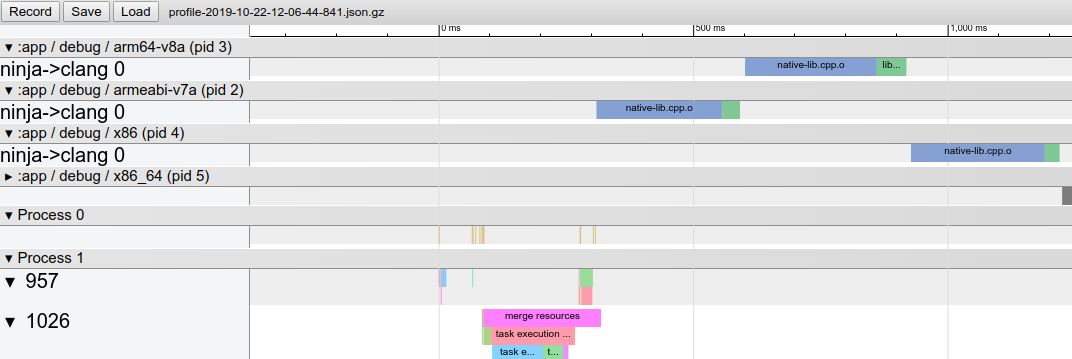
আচরণগত পরিবর্তন
When using this version of the plugin, you might encounter the following changes in behavior.
Native libraries packaged uncompressed by default
When you build your app, the plugin now sets extractNativeLibs to "false" by default. That is, your native libraries are page aligned and packaged uncompressed. While this results in a larger upload size, your users benefit from the following:
- Smaller app install size because the platform can access the native libraries directly from the installed APK, without creating a copy of the libraries.
- Smaller download size because Play Store compression is typically better when you include uncompressed native libraries in your APK or Android App Bundle.
If you want the Android Gradle plugin to instead package compressed native libraries, include the following in your app's manifest:
<application
android:extractNativeLibs="true"
... >
</application>
Note: The extractNativeLibs manifest attribute has been replaced by the useLegacyPackaging DSL option. For more information, see the release note Use the DSL to package compressed native libraries .
Default NDK version
If you download multiple versions of the NDK, the Android Gradle plugin now selects a default version to use in compiling your source code files. Previously, the plugin selected the latest downloaded version of the NDK. Use the android.ndkVersion property in the module's build.gradle file to override the plugin-selected default.
Simplified R class generation
The Android Gradle plugin simplifies the compile classpath by generating only one R class for each library module in your project and sharing those R classes with other module dependencies. This optimization should result in faster builds, but it requires that you keep the following in mind:
- Because the compiler shares R classes with upstream module dependencies, it's important that each module in your project uses a unique package name.
- The visibility of a library's R class to other project dependencies is determined by the configuration used to include the library as a dependency. For example, if Library A includes Library B as an 'api' dependency, Library A and other libraries that depend on Library A have access to Library B's R class. However, other libraries might not have access to Library B's R class. If Library A uses the
implementationdependency configuration. To learn more, read about dependency configurations .
Remove resources missing from default configuration
For Library modules, if you include a resource for a language that you do not include in the default set of resources—for example, if you include hello_world as a string resource in /values-es/strings.xml but you don't define that resource in /values/strings.xml —the Android Gradle plugin no longer includes that resource when compiling your project. This behavior change should result in fewer Resource Not Found runtime exceptions and improved build speed.
D8 now respects CLASS retention policy for annotations
When compiling your app, D8 now respects when annotations apply a CLASS retention policy, and those annotations are no longer available at runtime. This behavior also exists when setting the app's target SDK to API level 23, which previously allowed access to these annotations during runtime when compiling your app using older versions of the Android Gradle plugin and D8.
Other behavior changes
-
aaptOptions.noCompressis no longer case sensitive on all platforms (for both APK and bundles) and respects paths that use uppercase characters. Data binding is now incremental by default. To learn more, see issue #110061530 .
All unit tests, including Roboelectric unit tests, are now fully cacheable. To learn more, see issue #115873047 .
বাগ সংশোধন
This version of the Android Gradle plugin includes the following bug fixes:
- Robolectric unit tests are now supported in library modules that use data binding. To learn more, see issue #126775542 .
- You can now run
connectedAndroidTesttasks across multiple modules while Gradle's parallel execution mode is enabled.
জ্ঞাত সমস্যা
This section describes known issues that exist in Android Gradle plugin 3.6.0.
Slow performance of Android Lint task
Android Lint can take much longer to complete on some projects due to a regression in its parsing infrastructure, resulting in slower computation of inferred types for lambdas in certain code constructs.
The issue is reported as a bug in IDEA and will be fixed in Android Gradle Plugin 4.0.
Missing Manifest class {:#agp-missing-manifest}
If your app defines custom permissions in its manifest, the Android Gradle plugin typically generates a Manifest.java class that includes your custom permissions as string constants. The plugin packages this class with your app, so you can more easily reference those permissions at runtime.
Generating the manifest class is broken in Android Gradle plugin 3.6.0. If you build your app with this version of the plugin, and it references the manifest class, you might see a ClassNotFoundException exception. To resolve this issue, do one of the following:
Reference your custom permissions by their fully-qualified name. For example,
"com.example.myapp.permission.DEADLY_ACTIVITY".Define your own constants, as shown below:
public final class CustomPermissions { public static final class permission { public static final String DEADLY_ACTIVITY="com.example.myapp.permission.DEADLY_ACTIVITY"; } }
3.5.0 (August 2019)
Android Gradle plugin 3.5.0, along with Android Studio 3.5 , is a major release and a result of Project Marble, which is a focus on improving three main areas of the Android developer tools: system health, feature polish, and fixing bugs. Notably, improving project build speed was a main focus for this update.
For information about these and other Project Marble updates, read the Android Developers blog post or the sections below.
This version of the Android plugin requires the following:
Gradle 5.4.1 . To learn more, read the section about updating Gradle .
SDK Build Tools 28.0.3 or higher.
3.5.4 (July 2020)
This minor update supports compatibility with new default settings and features for package visibility in Android 11 .
See the 4.0.1 release notes for details.
3.5.3 (December 2019)
This minor update supports Android Studio 3.5.3 and includes various bug fixes and performance improvements.
3.5.2 (November 2019)
This minor update supports Android Studio 3.5.2 and includes various bug fixes and performance improvements. To see a list of noteable bug fixes, read the related post on the Release Updates blog .
3.5.1 (October 2019)
This minor update supports Android Studio 3.5.1 and includes various bug fixes and performance improvements. To see a list of noteable bug fixes, read the related post on the Release Updates blog .
Incremental annotation processing
The Data Binding annotation processor supports incremental annotation processing if you set android.databinding.incremental=true in your gradle.properties file. This optimization results in improved incremental build performance. For a full list of optimized annotation processors, refer to the table of incremental annotation processors .
Additionally, KAPT 1.3.30 and higher also support incremental annotation processors, which you can enable by including kapt.incremental.apt=true in your gradle.properties file.
Cacheable unit tests
When you enable unit tests to use Android resources, assets, and manifests by setting includeAndroidResources to true , the Android Gradle plugin generates a test config file containing absolute paths, which breaks cache relocatability. You can instruct the plugin to instead generate the test config using relative paths, which allows the AndroidUnitTest task to be fully cacheable, by including the following in your gradle.properties file:
android.testConfig.useRelativePath = true
জ্ঞাত সমস্যা
When using Kotlin Gradle plugin 1.3.31 or earlier, you might see the following warning when building or syncing your project:
WARNING: API 'variant.getPackageLibrary()' is obsolete and has been replaced with 'variant.getPackageLibraryProvider()'.To resolve this issue , upgrade the plugin to version 1.3.40 or higher.
3.4.0 (April 2019)
This version of the Android plugin requires the following:
Gradle 5.1.1 or higher. To learn more, read the section about updating Gradle .
Note: When using Gradle 5.0 and higher, the default Gradle daemon memory heap size decreases from 1 GB to 512 MB. This might result in a build performance regression. To override this default setting, specify the Gradle daemon heap size in your project's
gradle.propertiesfile.SDK Build Tools 28.0.3 or higher.
3.4.3 (July 2020)
This minor update supports compatibility with new default settings and features for package visibility in Android 11 .
See the 4.0.1 release notes for details.
৩.৪.২ (জুলাই ২০১৯)
This minor update supports Android Studio 3.4.2 and includes various bug fixes and performance improvements. To see a list of noteable bug fixes, read the related post on the Release Updates blog .
৩.৪.১ (মে ২০১৯)
This minor update supports Android Studio 3.4.1 and includes various bug fixes and performance improvements. To see a list of noteable bug fixes, read the related post on the Release Updates blog .
নতুন বৈশিষ্ট্য
New lint check dependency configurations: The behavior of
lintCheckshas changed and a new dependency configuration,lintPublish, has been introduced to give you more control over which lint checks are packaged in your Android libraries.-
lintChecks: This is an existing configuration that you should use for lint checks you want to only run when building your project locally. If you were previously using thelintChecksdependency configuration to include lint checks in the published AAR, you need to migrate those dependencies to instead use the newlintPublishconfiguration described below. -
lintPublish: Use this new configuration in library projects for lint checks you want to include in the published AAR, as shown below. This means that projects that consume your library also apply those lint checks.
The following code sample uses both dependency configurations in a local Android library project.
dependencies { // Executes lint checks from the ':lint' project at build time. lintChecks project(':lint') // Packages lint checks from the ':lintpublish' in the published AAR. lintPublish project(':lintpublish') }
dependencies { // Executes lint checks from the ':lint' project at build time. lintChecks(project(":lint")) // Packages lint checks from the ':lintpublish' in the published AAR. lintPublish(project(":lintpublish")) }
In general, packaging and signing tasks should see an overall build speed improvement. If you notice a performance regression related to these tasks, please report a bug .
-
আচরণগত পরিবর্তন
Android Instant Apps Feature plugin deprecation warning: If you're still using the
com.android.featureplugin to build your instant app, Android Gradle plugin 3.4.0 will give throw you a deprecation warning. To make sure you can still build you instant app on future versions of the plugin, migrate your instant app to using the dynamic feature plugin , which also allows you to publish both your installed and instant app experiences from a single Android App Bundle.R8 enabled by default: R8 integrates desugaring, shrinking, obfuscating, optimizing, and dexing all in one step—resulting in noticeable build performance improvements . R8 was introduced in Android Gradle plugin 3.3.0 and is now enabled by default for both app and Android library projects using plugin 3.4.0 and higher.
নীচের ছবিটি R8 চালু হওয়ার আগে কম্পাইল প্রক্রিয়ার একটি উচ্চ-স্তরের ওভারভিউ প্রদান করে।

এখন, R8 এর সাহায্যে, ডিসুগারিং, সঙ্কুচিতকরণ, অস্পষ্টকরণ, অপ্টিমাইজেশন এবং ডেক্সিং (D8) সবই এক ধাপে সম্পন্ন হয়, যেমনটি নীচে দেখানো হয়েছে।

মনে রাখবেন, R8 আপনার বিদ্যমান ProGuard নিয়মগুলির সাথে কাজ করার জন্য ডিজাইন করা হয়েছে, তাই R8 থেকে উপকৃত হওয়ার জন্য আপনাকে সম্ভবত কোনও পদক্ষেপ নেওয়ার প্রয়োজন হবে না। তবে, যেহেতু এটি ProGuard থেকে আলাদা একটি প্রযুক্তি যা বিশেষভাবে Android প্রকল্পগুলির জন্য ডিজাইন করা হয়েছে, তাই সঙ্কুচিত এবং অপ্টিমাইজেশনের ফলে এমন কোড সরানো হতে পারে যা ProGuard-এর কাছে নাও থাকতে পারে। তাই, এই অপ্রত্যাশিত পরিস্থিতিতে, আপনার বিল্ড আউটপুটে সেই কোডটি রাখার জন্য আপনাকে অতিরিক্ত নিয়ম যোগ করতে হতে পারে।
যদি আপনার R8 ব্যবহারে কোনও সমস্যা হয়, তাহলে আপনার সমস্যার সমাধান আছে কিনা তা পরীক্ষা করার জন্য R8 সামঞ্জস্যতা সম্পর্কিত FAQ পড়ুন। যদি কোনও সমাধান নথিভুক্ত না থাকে, তাহলে দয়া করে একটি বাগ রিপোর্ট করুন । আপনার প্রকল্পের gradle.properties ফাইলে নিম্নলিখিত লাইনগুলির মধ্যে একটি যোগ করে আপনি R8 অক্ষম করতে পারেন:
# Disables R8 for Android Library modules only.
android.enableR8.libraries = false
# Disables R8 for all modules.
android.enableR8 = false
দ্রষ্টব্য: একটি নির্দিষ্ট বিল্ড টাইপের জন্য, যদি আপনি আপনার অ্যাপ মডিউলের build.gradle ফাইলে useProguard কে false এ সেট করেন, তাহলে Android Gradle প্লাগইনটি আপনার প্রোজেক্টের gradle.properties ফাইলে R8 অক্ষম করুন না কেন, সেই বিল্ড টাইপের জন্য আপনার অ্যাপের কোড সঙ্কুচিত করতে R8 ব্যবহার করে।
-
ndkCompileis deprecated: You now get a build error if you try to usendkBuildto compile your native libraries. You should instead use either CMake or ndk-build to Add C and C++ code to your project .
জ্ঞাত সমস্যা
The correct usage of unique package names are currently not enforced but will become more strict on later versions of the plugin. On Android Gradle plugin version 3.4.0, you can opt-in to check whether your project declares acceptable package names by adding the line below to your
gradle.propertiesfile.android.uniquePackageNames = trueTo learn more about setting a package name through the Android Gradle plugin, see Set the application ID .
3.3.0 (January 2019)
This version of the Android plugin requires the following:
Gradle 4.10.1 or higher. To learn more, read the section about updating Gradle .
Note: When using Gradle 5.0 and higher, the default Gradle daemon memory heap size decreases from 1 GB to 512 MB. This might result in a build performance regression. To override this default setting, specify the Gradle daemon heap size in your project's
gradle.propertiesfile.SDK Build Tools 28.0.3 or higher.
3.3.3 (July 2020)
This minor update supports compatibility with new default settings and features for package visibility in Android 11 .
See the 4.0.1 release notes for details.
3.3.2 (March 2019)
This minor update supports Android Studio 3.3.2 and includes various bug fixes and performance improvements. To see a list of noteable bug fixes, read the related post on the Release Updates blog .
3.3.1 (February 2019)
This minor update supports Android Studio 3.3.1 and includes various bug fixes and performance improvements.
নতুন বৈশিষ্ট্য
Improved classpath synchronization: When resolving dependencies on your runtime and compile time classpaths, the Android Gradle plugin attempts to fix certain downstream version conflicts for dependencies that appear across multiple classpaths.
For example, if the runtime classpath includes Library A version 2.0 and the compile classpath includes Library A version 1.0, the plugin automatically updates the dependency on the compile classpath to Library A version 2.0 to avoid errors.
However, if the runtime classpath includes Library A version 1.0 and the compile includes Library A version 2.0, the plugin does not downgrade the dependency on the compile classpath to Library A version 1.0, and you will get an error. To learn more, see Fix conflicts between classpaths .
Improved incremental Java compilation when using annotation processors: This update decreases build time by improving support for incremental Java compilation when using annotation processors.
Note: This feature is compatible with Gradle 4.10.1 and higher, except Gradle 5.1 due to Gradle issue 8194 .
For projects using Kapt (most Kotlin-only projects and Kotlin-Java hybrid projects): Incremental Java compilation is enabled, even when you use data binding or the retro-lambda plugin. Annotation processing by the Kapt task is not yet incremental.
For projects not using Kapt (Java-only projects): If the annotation processors you use all support incremental annotation processing , incremental Java compilation is enabled by default. To monitor incremental annotation processor adoption, watch Gradle issue 5277 .
If, however, one or more annotation processors do not support incremental builds, incremental Java compilation is not enabled. Instead, you can include the following flag in your
gradle.propertiesfile:android.enableSeparateAnnotationProcessing=trueWhen you include this flag, the Android Gradle plugin executes the annotation processors in a separate task and allows the Java compilation task to run incrementally.
Better debug info when using obsolete API: When the plugin detects that you're using an API that's no longer supported, it can now provide more-detailed information to help you determine where that API is being used. To see the additional info, you need to include the following in your project's
gradle.propertiesfile:android.debug.obsoleteApi=trueYou can also enable the flag by passing
-Pandroid.debug.obsoleteApi=truefrom the command line.You can run instrumentation tests on feature modules from the command line.
আচরণগত পরিবর্তন
Lazy task configuration: The plugin now uses Gradle's new task creation API to avoid initializing and configuring tasks that are not required to complete the current build (or tasks not on the execution task graph). For example, if you have multiple build variants, such as “release” and “debug” build variants, and you're building the “debug” version of your app, the plugin avoids initializing and configuring tasks for the “release” version of your app.
Calling certain older methods in the Variants API, such as
variant.getJavaCompile(), might still force task configuration. To make sure that your build is optimized for lazy task configuration, invoke new methods that instead return a TaskProvider object, such asvariant.getJavaCompileProvider().If you execute custom build tasks, learn how to adapt to Gradle's new task-creation API .
For a given build type, when setting
useProguard false, the plugin now uses R8 instead of ProGuard to shrink and obfuscate your app's code and resources. To learn more about R8, read this blog post from the Android Developer's Blog.Faster R class generation for library projects: Previously, the Android Gradle plugin would generate an
R.javafile for each of your project's dependencies and then compile those R classes alongside your app's other classes. The plugin now generates a JAR containing your app's compiled R class directly, without first building intermediateR.javaclasses. This optimization may significantly improve build performance for projects that include many library subprojects and dependencies, and improve the indexing speed in Android Studio.When building an Android App Bundle , APKs generated from that app bundle that target Android 6.0 (API level 23) or higher now include uncompressed versions of your native libraries by default. This optimization avoids the need for the device to make a copy of the library and thus reduces the on-disk size of your app. If you'd rather disable this optimization, add the following to your
gradle.propertiesfile:android.bundle.enableUncompressedNativeLibs = falseThe plugin enforces minimum versions of some third-party plugins.
Single-variant project sync : Syncing your project with your build configuration is an important step in letting Android Studio understand how your project is structured. However, this process can be time-consuming for large projects. If your project uses multiple build variants, you can now optimize project syncs by limiting them to only the variant you have currently selected.
You need to use Android Studio 3.3 or higher with Android Gradle Plugin 3.3.0 or higher to enable this optimization. When you meet these requirements, the IDE prompts you to enable this optimization when you sync your project. The optimization is also enabled by default on new projects.
To enable this optimization manually, click File > Settings > Experimental > Gradle ( Android Studio > Preferences > Experimental > Gradle on a Mac) and select the Only sync the active variant checkbox.
Note : This optimization fully supports projects that include Java and C++ languages, and has some support for Kotlin. When enabling the optimization for projects with Kotlin content, Gradle sync falls back to using full variants internally.
Automatic downloading of missing SDK packages : This functionality has been expanded to support NDK. To learn more, read Auto-download missing packages with Gradle .
বাগ ফিক্স
Android Gradle plugin 3.3.0 fixes the following issues:
- The build process calling
android.support.v8.renderscript.RenderScriptinstead of the AndroidX version, despite Jetifier being enabled - Clashes due to
androidx-rs.jarincluding statically bundledannotation.AnyRes - When using RenderScript, you no longer have to manually set the Build Tools version in your
build.gradlefiles
- The build process calling
3.2.0 (September 2018)
This version of the Android plugin requires the following:
- Gradle 4.6 or higher. To learn more, read the section about updating Gradle .
- SDK Build Tools 28.0.3 or higher.
3.2.1 (October 2018)
With this update, you no longer need to specify a version for the SDK Build Tools. The Android Gradle plugin now uses version 28.0.3 by default.
নতুন বৈশিষ্ট্য
Support for building Android App Bundles: The app bundle is a new upload format that includes all your app's compiled code and resources while deferring APK generation and signing to the Google Play Store. You no longer have to build, sign, and manage multiple APKs, and users get smaller downloads that are optimized for their device. To learn more, read About Android App Bundles .
Support for improved incremental build speeds when using annotation processors: The
AnnotationProcessorOptionsDSL now extendsCommandLineArgumentProvider, which enables either you or the annotation processor author to annotate arguments for the processor using incremental build property type annotations . Using these annotations improves the correctness and performance of incremental and cached clean builds. To learn more, read Pass arguments to annotation processors .Migration tool for AndroidX: When using Android Gradle plugin 3.2.0 with Android 3.2 and higher, you can migrate your project's local and Maven dependencies to use the new AndroidX libraries by selecting Refactor > Migrate to AndroidX from the menu bar. Using this migration tool also sets the following flags to
truein yourgradle.propertiesfile:android.useAndroidX: When set totrue, the Android plugin uses the appropriate AndroidX library instead of a Support Library. When this flag is not specified, the plugin sets it tofalseby default.android.enableJetifier: When set totrue, the Android plugin automatically migrates existing third-party libraries to use AndroidX by rewriting their binaries. When this flag is not specified, the plugin sets it tofalseby default. You can set this flag totrueonly whileandroid.useAndroidXis also set totrue, otherwise you get a build error.To learn more, read the AndroidX overview .
New code shrinker, R8: R8 is a new tool for code shrinking and obfuscation that replaces ProGuard. You can start using the preview version of R8 by including the following in your project's
gradle.propertiesfile:android.enableR8 = true
android.enableR8 = true
আচরণগত পরিবর্তন
Desugaring with D8 is now enabled by default.
AAPT2 is now on Google's Maven repo. To use AAPT2, make sure that you have the
google()dependency in yourbuild.gradlefile, as shown below:buildscript { repositories { google() // here jcenter() } dependencies { classpath 'com.android.tools.build:gradle:3.2.0' } } allprojects { repositories { google() // and here jcenter() }
buildscript { repositories { google() // here jcenter() } dependencies { classpath 'com.android.tools.build:gradle:3.2.0' } } allprojects { repositories { google() // and here jcenter() }
Native multidex is now enabled by default. Previous versions of Android Studio enabled native multidex when deploying the debug version of an app to a device running Android API level 21 or higher. Now, whether you're deploying to a device or building an APK for release, the Android Gradle plugin enables native multidex for all modules that set
minSdkVersion=21or higher.The plugin now enforces a minimum version of the protobuf plugin (0.8.6), Kotlin plugin (1.2.50), and Crashlytics plugin (1.25.4).
The feature module plugin,
com.android.feature, now enforces the use of only letters, digits, and underscores when specifying a module name. For example, if your feature module name includes dashes, you get a build error. This behavior matches that of the dynamic feature plugin.
বাগ সংশোধন
- JavaCompile is now cacheable in projects with data binding. ( Issue #69243050 )
- Better compile avoidance for library modules with data binding. ( Issue #77539932 )
- You can now re-enable configure-on-demand if you've disable it in earlier versions due to some unpredictable build errors. ( Issue #77910727 )
3.1.0 (March 2018)
This version of the Android plugin requires the following:
Gradle 4.4 or higher.
To learn more, read the section about updating Gradle .
Build Tools 27.0.3 or higher.
Keep in mind, you no longer need to specify a version for the build tools using the
android.buildToolsVersionproperty—the plugin uses the minimum required version by default.
New DEX compiler, D8
By default, Android Studio now uses a new DEX compiler called D8. DEX compilation is the process of transforming .class bytecode into .dex bytecode for the Android Runtime (or Dalvik, for older versions of Android). Compared to the previous compiler, called DX, D8 compiles faster and outputs smaller DEX files, all while having the same or better app runtime performance.
D8 shouldn't change your day-to-day app development workflow. However, if you experience any issues related to the new compiler, please report a bug . You can temporarily disable D8 and use DX by including the following in your project's gradle.properties file:
android.enableD8=false
For projects that use Java 8 language features , incremental desugaring is enabled by default. You can disable it by specifying the following in your project's gradle.properties file:
android.enableIncrementalDesugaring=false.
Preview users: If you're already using a preview version of D8, note that it now compiles against libraries included in the SDK build tools —not the JDK. So, if you are accessing APIs that exist in the JDK but not in the SDK build tools libraries, you get a compile error.
আচরণগত পরিবর্তন
When building multiple APKs that each target a different ABI, the no longer generates APKs for the following ABIs by default:
mips,mips64, andarmeabi.If you want to build APKs that target these ABIs, you must use NDK r16b or lower and specify the ABIs in your
build.gradlefile, as shown below:splits { abi { include 'armeabi', 'mips', 'mips64' ... } }
splits { abi { include("armeabi", "mips", "mips64") ... } }
The Android plugin's build cache now evicts cache entries that are older than 30 days.
Passing
"auto"toresConfigno longer automatically picks string resources to package into your APK. If you continue to use"auto", the plugin packages all string resources your app and its dependencies provide. So, you should instead specify each locale that you want the plugin to package into your APK.Because local modules can't depend on your app's test APK, adding dependencies to your instrumented tests using the
androidTestApiconfiguration, instead ofandroidTestImplementation, causes Gradle to issue the following warning:WARNING: Configuration 'androidTestApi' is obsolete and has been replaced with 'androidTestImplementation'
WARNING: Configuration 'androidTestApi' is obsolete and has been replaced with 'androidTestImplementation'
সংশোধন
- Fixes an issue where Android Studio doesn't properly recognize dependencies in composite builds.
- Fixes an issue where you get a project sync error when loading the Android plugin multiple times in a single build–for example, when multiple subprojects each include the Android plugin in their buildscript classpath.
3.0.0 (October 2017)
Android Gradle plugin 3.0.0 includes a variety of changes that aim to address performance issues of large projects.
For example, on a sample skeleton project with ~130 modules and a large number of external dependencies (but no code or resources), you can experience performance improvements similar to the following:
| Android plugin version + Gradle version | Android plugin 2.2.0 + Gradle 2.14.1 | Android plugin 2.3.0 + Gradle 3.3 | Android plugin 3.0.0 + Gradle 4.1 |
|---|---|---|---|
Configuration (eg running ./gradlew --help ) | ~2 mins | ~9 s | ~2.5 s |
| 1-line Java change (implementation change) | ~2 mins 15 s | ~29 s | ~6.4 s |
Some of these changes break existing builds. So, you should consider the\ effort of migrating your project before using the new plugin.
If you don't experience the performance improvements described above, please file a bug and include a trace of your build using the Gradle Profiler .
This version of the Android plugin requires the following:
- Gradle 4.1 or higher. To learn more, read the section about updating Gradle .
- Build Tools 26.0.2 or higher. With this update, you no longer need to specify a version for the build tools—the plugin uses the minimum required version by default. So, you can now remove the
android.buildToolsVersionproperty.
৩.০.১ (নভেম্বর ২০১৭)
This is a minor update to support Android Studio 3.0.1, and includes general bug fixes and performance improvements.
অপ্টিমাইজেশন
- Better parallelism for multi-module projects through a fine grained task graph.
- When making changes to dependency, Gradle performs faster builds by not re-compiling modules that do not have access to that dependency's API. You should restrict which dependencies leak their APIs to other modules by using Gradle's new dependency configurations :
implementation,api,compileOnly, andruntimeOnly. - Faster incremental build speed due to per-class dexing. Each class is now compiled into separate DEX files, and only the classes that are modified are re-dexed. You should also expect improved build speeds for apps that set
minSdkVersionto 20 or lower, and use legacy multi-dex . - Improved build speeds by optimizing certain tasks to use chached outputs. To benefit from this optimization, you need to first enable the Gradle build cache .
- Improved incremental resource processing using AAPT2, which is now enabled by default. If you are experiencing issues while using AAPT2, please report a bug . You can also disable AAPT2 by setting
android.enableAapt2=falsein yourgradle.propertiesfile and restarting the Gradle daemon by running./gradlew --stopfrom the command line.
নতুন বৈশিষ্ট্য
- Variant-aware dependency management . When building a certain variant of a module, the plugin now automatically matches variants of local library module dependencies to the variant of the module you are building.
- Includes a new Feature module plugin to support Android Instant Apps and the Android Instant Apps SDK (which you can download using the SDK manager ). To learn more about creating Feature modules with the new plugin, read Structure of an instant app with multiple features .
- Built-in support for using certain Java 8 language features and Java 8 libraries. Jack is now deprecated and no longer required , and you should first disable Jack to use the improved Java 8 support built into the default toolchain. For more information, read Use Java 8 language features .
Added support for running tests with Android Test Orchestrator , which allows you to run each of your app's tests within its own invocation of Instrumentation. Because each test runs in its own Instrumentation instance, any shared state between tests doesn't accumulate on your device's CPU or memory. And, even if one test crashes, it takes down only its own instance of Instrumentation, so your other tests still run.
- Added
testOptions.executionto determine whether to use on-device test orchestration. If you want to use Android Test Orchestrator , you need to specifyANDROID_TEST_ORCHESTRATOR, as shown below. By default, this property is set toHOST, which disables on-device orchestration and is the standard method of running tests.
খাঁজকাটা
android { testOptions { execution 'ANDROID_TEST_ORCHESTRATOR' } }
কোটলিন
android { testOptions { execution = "ANDROID_TEST_ORCHESTRATOR" } }
- Added
New
androidTestUtildependency configuration allows you to install another test helper APK before running your instrumentation tests, such as Android Test Orchestrator:খাঁজকাটা
dependencies { androidTestUtil 'com.android.support.test:orchestrator:1.0.0' ... }
কোটলিন
dependencies { androidTestUtil("com.android.support.test:orchestrator:1.0.0") ... }
Added
testOptions.unitTests.includeAndroidResourcesto support unit tests that require Android resources, such as Roboelectric . When you set this property totrue, the plugin performs resource, asset, and manifest merging before running your unit tests. Your tests can then inspectcom/android/tools/test_config.propertieson the classpath for the following keys:android_merged_assets: the absolute path to the merged assets directory.Note: For library modules, the merged assets do not contain the assets of dependencies (see issue #65550419 ).
android_merged_manifest: the absolute path to the merged manifest file.android_merged_resources: the absolute path to the merged resources directory, which contains all the resources from the module and all its dependencies.android_custom_package: the package name of the final R class. If you dynamically modify the application ID, this package name may not match thepackageattribute in the app's manifest.
- Support for fonts as resources (which is a new feature introduced in Android 8.0 (API level 26) ).
- Support for language-specific APKs with Android Instant Apps SDK 1.1 and higher.
You can now change the output directory for your external native build project, as shown below:
খাঁজকাটা
android { ... externalNativeBuild { // For ndk-build, instead use the ndkBuild block. cmake { ... // Specifies a relative path for outputs from external native // builds. You can specify any path that's not a subdirectory // of your project's temporary build/ directory. buildStagingDirectory "./outputs/cmake" } } }
কোটলিন
android { ... externalNativeBuild { // For ndk-build, instead use the ndkBuild block. cmake { ... // Specifies a relative path for outputs from external native // builds. You can specify any path that's not a subdirectory // of your project's temporary build/ directory. buildStagingDirectory = "./outputs/cmake" } } }
- You can now use CMake 3.7 or higher when building native projects from Android Studio.
New
lintChecksdependency configuration allows you to build a JAR that defines custom lint rules, and package it into your AAR and APK projects.Your custom lint rules must belong to a separate project that outputs a single JAR and includes only
compileOnlydependencies. Other app and library modules can then depend on your lint project using thelintChecksconfiguration:খাঁজকাটা
dependencies { // This tells the Gradle plugin to build ':lint-checks' into a lint.jar file // and package it with your module. If the module is an Android library, // other projects that depend on it automatically use the lint checks. // If the module is an app, lint includes these rules when analyzing the app. lintChecks project(':lint-checks') }
কোটলিন
dependencies { // This tells the Gradle plugin to build ':lint-checks' into a lint.jar file // and package it with your module. If the module is an Android library, // other projects that depend on it automatically use the lint checks. // If the module is an app, lint includes these rules when analyzing the app. lintChecks(project(":lint-checks")) }
আচরণগত পরিবর্তন
- Android plugin 3.0.0 removes certain APIs, and your build will break if you use them. For example, you can no longer use the Variants API to access
outputFile()objects or useprocessManifest.manifestOutputFile()to get the manifest file for each variant. To learn more, read API changes . - You no longer need to specify a version for the build tools (so, you can now remove the
android.buildToolsVersionproperty). By default, the plugin automatically uses the minimum required build tools version for the version of Android plugin you're using. - You now enable/disable PNG crunching in the
buildTypesblock, as shown below. PNG crunching is enabled by default for all builds except debug builds because it increases build times for projects that include many PNG files. So, to improve build times for other build types, you should either disable PNG crunching or convert your images to WebP .খাঁজকাটা
android { buildTypes { release { // Disables PNG crunching for the release build type. crunchPngs false } } }
কোটলিন
android { buildTypes { release { // Disables PNG crunching for the release build type. isCrunchPngs = false } } }
- The Android plugin now automatically builds executable targets that you configure in your external CMake projects.
- You must now add annotation processors to the processor classpath using the
annotationProcessordependency configuration. - Using the deprecated
ndkCompileis now more restricted. You should instead migrate to using either CMake or ndk-build to compile native code that you want to package into your APK. To learn more, read Migrate from ndkcompile .
3.0.0 (October 2017)
Android Gradle plugin 3.0.0 includes a variety of changes that aim to address performance issues of large projects.
For example, on a sample skeleton project with ~130 modules and a large number of external dependencies (but no code or resources), you can experience performance improvements similar to the following:
| Android plugin version + Gradle version | Android plugin 2.2.0 + Gradle 2.14.1 | Android plugin 2.3.0 + Gradle 3.3 | Android plugin 3.0.0 + Gradle 4.1 |
|---|---|---|---|
Configuration (eg running ./gradlew --help ) | ~2 mins | ~9 s | ~2.5 s |
| 1-line Java change (implementation change) | ~2 mins 15 s | ~29 s | ~6.4 s |
Some of these changes break existing builds. So, you should consider the\ effort of migrating your project before using the new plugin.
If you don't experience the performance improvements described above, please file a bug and include a trace of your build using the Gradle Profiler .
This version of the Android plugin requires the following:
- Gradle 4.1 or higher. To learn more, read the section about updating Gradle .
- Build Tools 26.0.2 or higher. With this update, you no longer need to specify a version for the build tools—the plugin uses the minimum required version by default. So, you can now remove the
android.buildToolsVersionproperty.
৩.০.১ (নভেম্বর ২০১৭)
This is a minor update to support Android Studio 3.0.1, and includes general bug fixes and performance improvements.
অপ্টিমাইজেশন
- Better parallelism for multi-module projects through a fine grained task graph.
- When making changes to dependency, Gradle performs faster builds by not re-compiling modules that do not have access to that dependency's API. You should restrict which dependencies leak their APIs to other modules by using Gradle's new dependency configurations :
implementation,api,compileOnly, andruntimeOnly. - Faster incremental build speed due to per-class dexing. Each class is now compiled into separate DEX files, and only the classes that are modified are re-dexed. You should also expect improved build speeds for apps that set
minSdkVersionto 20 or lower, and use legacy multi-dex . - Improved build speeds by optimizing certain tasks to use chached outputs. To benefit from this optimization, you need to first enable the Gradle build cache .
- Improved incremental resource processing using AAPT2, which is now enabled by default. If you are experiencing issues while using AAPT2, please report a bug . You can also disable AAPT2 by setting
android.enableAapt2=falsein yourgradle.propertiesfile and restarting the Gradle daemon by running./gradlew --stopfrom the command line.
নতুন বৈশিষ্ট্য
- Variant-aware dependency management . When building a certain variant of a module, the plugin now automatically matches variants of local library module dependencies to the variant of the module you are building.
- Includes a new Feature module plugin to support Android Instant Apps and the Android Instant Apps SDK (which you can download using the SDK manager ). To learn more about creating Feature modules with the new plugin, read Structure of an instant app with multiple features .
- Built-in support for using certain Java 8 language features and Java 8 libraries. Jack is now deprecated and no longer required , and you should first disable Jack to use the improved Java 8 support built into the default toolchain. For more information, read Use Java 8 language features .
Added support for running tests with Android Test Orchestrator , which allows you to run each of your app's tests within its own invocation of Instrumentation. Because each test runs in its own Instrumentation instance, any shared state between tests doesn't accumulate on your device's CPU or memory. And, even if one test crashes, it takes down only its own instance of Instrumentation, so your other tests still run.
- Added
testOptions.executionto determine whether to use on-device test orchestration. If you want to use Android Test Orchestrator , you need to specifyANDROID_TEST_ORCHESTRATOR, as shown below. By default, this property is set toHOST, which disables on-device orchestration and is the standard method of running tests.
খাঁজকাটা
android { testOptions { execution 'ANDROID_TEST_ORCHESTRATOR' } }
কোটলিন
android { testOptions { execution = "ANDROID_TEST_ORCHESTRATOR" } }
- Added
New
androidTestUtildependency configuration allows you to install another test helper APK before running your instrumentation tests, such as Android Test Orchestrator:খাঁজকাটা
dependencies { androidTestUtil 'com.android.support.test:orchestrator:1.0.0' ... }
কোটলিন
dependencies { androidTestUtil("com.android.support.test:orchestrator:1.0.0") ... }
Added
testOptions.unitTests.includeAndroidResourcesto support unit tests that require Android resources, such as Roboelectric . When you set this property totrue, the plugin performs resource, asset, and manifest merging before running your unit tests. Your tests can then inspectcom/android/tools/test_config.propertieson the classpath for the following keys:android_merged_assets: the absolute path to the merged assets directory.Note: For library modules, the merged assets do not contain the assets of dependencies (see issue #65550419 ).
android_merged_manifest: the absolute path to the merged manifest file.android_merged_resources: the absolute path to the merged resources directory, which contains all the resources from the module and all its dependencies.android_custom_package: the package name of the final R class. If you dynamically modify the application ID, this package name may not match thepackageattribute in the app's manifest.
- Support for fonts as resources (which is a new feature introduced in Android 8.0 (API level 26) ).
- Support for language-specific APKs with Android Instant Apps SDK 1.1 and higher.
You can now change the output directory for your external native build project, as shown below:
খাঁজকাটা
android { ... externalNativeBuild { // For ndk-build, instead use the ndkBuild block. cmake { ... // Specifies a relative path for outputs from external native // builds. You can specify any path that's not a subdirectory // of your project's temporary build/ directory. buildStagingDirectory "./outputs/cmake" } } }
কোটলিন
android { ... externalNativeBuild { // For ndk-build, instead use the ndkBuild block. cmake { ... // Specifies a relative path for outputs from external native // builds. You can specify any path that's not a subdirectory // of your project's temporary build/ directory. buildStagingDirectory = "./outputs/cmake" } } }
- You can now use CMake 3.7 or higher when building native projects from Android Studio.
New
lintChecksdependency configuration allows you to build a JAR that defines custom lint rules, and package it into your AAR and APK projects.Your custom lint rules must belong to a separate project that outputs a single JAR and includes only
compileOnlydependencies. Other app and library modules can then depend on your lint project using thelintChecksconfiguration:খাঁজকাটা
dependencies { // This tells the Gradle plugin to build ':lint-checks' into a lint.jar file // and package it with your module. If the module is an Android library, // other projects that depend on it automatically use the lint checks. // If the module is an app, lint includes these rules when analyzing the app. lintChecks project(':lint-checks') }
কোটলিন
dependencies { // This tells the Gradle plugin to build ':lint-checks' into a lint.jar file // and package it with your module. If the module is an Android library, // other projects that depend on it automatically use the lint checks. // If the module is an app, lint includes these rules when analyzing the app. lintChecks(project(":lint-checks")) }
আচরণগত পরিবর্তন
- Android plugin 3.0.0 removes certain APIs, and your build will break if you use them. For example, you can no longer use the Variants API to access
outputFile()objects or useprocessManifest.manifestOutputFile()to get the manifest file for each variant. To learn more, read API changes . - You no longer need to specify a version for the build tools (so, you can now remove the
android.buildToolsVersionproperty). By default, the plugin automatically uses the minimum required build tools version for the version of Android plugin you're using. - You now enable/disable PNG crunching in the
buildTypesblock, as shown below. PNG crunching is enabled by default for all builds except debug builds because it increases build times for projects that include many PNG files. So, to improve build times for other build types, you should either disable PNG crunching or convert your images to WebP .খাঁজকাটা
android { buildTypes { release { // Disables PNG crunching for the release build type. crunchPngs false } } }
কোটলিন
android { buildTypes { release { // Disables PNG crunching for the release build type. isCrunchPngs = false } } }
- The Android plugin now automatically builds executable targets that you configure in your external CMake projects.
- You must now add annotation processors to the processor classpath using the
annotationProcessordependency configuration. - Using the deprecated
ndkCompileis now more restricted. You should instead migrate to using either CMake or ndk-build to compile native code that you want to package into your APK. To learn more, read Migrate from ndkcompile .
2.3.0 (February 2017)
২.৩.৩ (জুন ২০১৭)
This is a minor update that adds compatibility with Android Studio 2.3.3 .
2.3.2 (May 2017)
This is a minor update that adds compatibility with Android Studio 2.3.2 .
২.৩.১ (এপ্রিল ২০১৭)
This is a minor update to Android plugin 2.3.0 that fixes an issue where some physical Android devices did not work properly with Instant Run (see Issue #235879 ).
- নির্ভরতা:
- Gradle 3.3 or higher.
- Build Tools 25.0.0 or higher.
- নতুন:
- Uses Gradle 3.3, which includes performance improvements and new features. For more details, see the Gradle release notes .
- Build cache : stores certain outputs that the Android plugin generates when building your project (such as unpackaged AARs and pre-dexed remote dependencies). Your clean builds are much faster while using the cache because the build system can simply reuse those cached files during subsequent builds, instead of recreating them. Projects using Android plugin 2.3.0 and higher use the build cache by default. To learn more, read Improve Build Speed with Build Cache .
- Includes a
cleanBuildCachetask that clears the build cache . - If you are using the experimental version of build cache (included in earlier versions of the plugin), you should update your plugin to the latest version.
- Includes a
- পরিবর্তন:
- Supports changes to Instant Run included in Android Studio 2.3 .
- Configuration times for very large projects should be significantly faster.
- Fixed issues with auto-downloading for the constraint layout library .
- Plugin now uses ProGuard version 5.3.2 .
- Includes many fixes for reported bugs . Please continue to file bug reports when you encounter issues.
2.2.0 (September 2016)
- নির্ভরতা:
- Gradle 2.14.1 or higher.
- Build Tools 23.0.2 or higher.
- নতুন:
- Uses Gradle 2.14.1, which includes performance improvements and new features, and fixes a security vulnerability that allows local privilege escalation when using the Gradle daemon. For more details, see the Gradle release notes .
- Using the
externalNativeBuild {}DSL, Gradle now lets you link to your native sources and compile native libraries using CMake or ndk-build. After building your native libraries, Gradle packages them into your APK. To learn more about using CMake and ndk-build with Gradle, read Add C and C++ Code to Your Project . - When you run a build from the command line , Gradle now attempts to auto-download any missing SDK components or updates that your project depends on. To learn more, read Auto-download missing packages with Gradle .
- A new experimental caching feature lets Gradle speed up build times by pre-dexing, storing, and reusing the pre-dexed versions of your libraries. To learn more about using this experimental feature, read the Build Cache guide.
- Improves build performance by adopting a new default packaging pipeline which handles zipping, signing, and zipaligning in one task. You can revert to using the older packaging tools by adding
android.useOldPackaging=trueto yourgradle.propertiesfile. While using the new packaging tool, thezipalignDebugtask is not available. However, you can create one yourself by calling thecreateZipAlignTask(String taskName, File inputFile, File outputFile)method. - APK signing now uses APK Signature Scheme v2 in addition to traditional JAR signing. All Android platforms accept the resulting APKs. Any modification to these APKs after signing invalidates their v2 signatures and prevents installation on a device. To disable this feature, add the following to your module-level
build.gradlefile:খাঁজকাটা
android { ... signingConfigs { config { ... v2SigningEnabled false } } }
কোটলিন
android { ... signingConfigs { create("config") { ... v2SigningEnabled = false } } }
- For multidex builds, you can now use ProGuard rules to determine which classes Gradle should compile into your app's main DEX file. Because the Android system loads the main DEX file first when starting your app, you can prioritize certain classes at startup by compiling them into the main DEX file. After you create a ProGuard configuration file specifically for your main DEX file, pass the configuration file's path to Gradle using
buildTypes.multiDexKeepProguard. Using this DSL is different from usingbuildTypes.proguardFiles, which provides general ProGuard rules for your app and does not specify classes for the main DEX file. - Adds support for the
android:extractNativeLibsflag, which can reduce the size of your app when you install it on a device. When you set this flag tofalsein the<application>element of your app manifest, Gradle packages uncompressed and aligned versions of your native libraries with your APK. This preventsPackageManagerfrom copying out your native libraries from the APK to the device's file system during installation and has the added benefit of making delta updates of your app smaller. - You can now specify
versionNameSuffixandapplicationIdSuffixfor product flavors. ( Issue 59614 )
- পরিবর্তন:
-
getDefaultProguardFilenow returns the default ProGuard files that Android plugin for Gradle provides and no longer uses the ones in the Android SDK. - Improved Jack compiler performance and features:
- Jack now supports Jacoco test coverage when setting
testCoverageEnabledtotrue. - Improved support for annotation processors. Annotation processors on your classpath, such as any
compiledependencies, are automatically applied to your build. You can also specify an annotation processor in your build and pass arguments by using thejavaCompileOptions.annotationProcessorOptions {}DSL in your module-levelbuild.gradlefile:খাঁজকাটা
android { ... defaultConfig { ... javaCompileOptions { annotationProcessorOptions { className 'com.example.MyProcessor' // Arguments are optional. arguments = [ foo : 'bar' ] } } } }
কোটলিন
android { ... defaultConfig { ... javaCompileOptions { annotationProcessorOptions { className = "com.example.MyProcessor" // Arguments are optional. arguments(mapOf(foo to "bar")) } } } }
If you want to apply an annotation processor at compile time but not include it in your APK, use the
annotationProcessordependency scope:খাঁজকাটা
dependencies { compile 'com.google.dagger:dagger:2.0' annotationProcessor 'com.google.dagger:dagger-compiler:2.0' // or use buildVariantAnnotationProcessor to target a specific build variant }
কোটলিন
dependencies { implementation("com.google.dagger:dagger:2.0") annotationProcessor("com.google.dagger:dagger-compiler:2.0") // or use buildVariantAnnotationProcessor to target a specific build variant }
- By default, if the Gradle daemon's heap size is at least 1.5 GB, Jack now runs in the same process as Gradle. To adjust the daemon heap size, add the following to your
gradle.propertiesfile:# This sets the daemon heap size to 1.5GB. org.gradle.jvmargs=-Xmx1536M
For a list of parameters you can set, run the following from the command line:
java -jar /build-tools/jack.jar --help-properties
- Jack now supports Jacoco test coverage when setting
-
2.1.0 (April 2016)
2.1.3 (August 2016)
This update requires Gradle 2.14.1 and higher. Gradle 2.14.1 includes performance improvements, new features, and an important security fix . For more details, see the Gradle release notes .
- নির্ভরতা:
- Gradle 2.10 or higher.
- Build Tools 23.0.2 or higher.
- নতুন:
- Added support for the N Developer Preview, JDK 8, and Java 8 language features using the Jack toolchain. To find out more, read the N Preview guide .
Note: Instant Run does not currently work with Jack and will be disabled while using the new toolchain. You only need to use Jack if you are developing for the N Preview and want to use the supported Java 8 language features.
- Added default support for incremental Java compilation to reduce compilation time during development. It does this by only recompiling portions of the source that have changed or need to be recompiled. To disable this feature, add the following code to your module-level
build.gradlefile:খাঁজকাটা
android { ... compileOptions { incremental false } }
কোটলিন
android { ... compileOptions { incremental = false } }
Added support for dexing-in-process which performs dexing within the build process rather than in a separate, external VM processes. This not only makes incremental builds faster, but also speeds up full builds. The feature is enabled by default for projects that have set the Gradle daemon's maximum heap size to at least 2048 MB. You can do this by including the following in your project's
```none org.gradle.jvmargs = -Xmx2048m ```gradle.propertiesfile:If you have defined a value for
```none org.gradle.jvmargs = -Xmx3072m ```javaMaxHeapSizein your module-levelbuild.gradlefile, you need to setorg.gradle.jvmargsto the value ofjavaMaxHeapSize+ 1024 MB. For example, if you have setjavaMaxHeapSizeto "2048m", you need to add the following to your project'sgradle.propertiesfile:To disable dexing-in-process, add the following code to your module-level
build.gradlefile:খাঁজকাটা
android { ... dexOptions { dexInProcess false } }
কোটলিন
android { ... dexOptions { dexInProcess = false } }
- Added support for the N Developer Preview, JDK 8, and Java 8 language features using the Jack toolchain. To find out more, read the N Preview guide .
2.0.0 (April 2016)
- নির্ভরতা:
- Gradle 2.10 or higher.
- Build Tools 21.1.1 or higher.
- নতুন:
- Enables Instant Run by supporting bytecode injection, and pushing code and resource updates to a running app on the emulator or a physical device.
- Added support for incremental builds, even when the app isn't running. Full build times are improved by pushing incremental changes through the Android Debug Bridge to the connected device.
- Added
maxProcessCountto control how many worker dex processes can be spawned concurrently. The following code, in the module-levelbuild.gradlefile, sets the maximum number of concurrent processes to 4:খাঁজকাটা
android { ... dexOptions { maxProcessCount = 4 // this is the default value } }
কোটলিন
android { ... dexOptions { maxProcessCount = 4 // this is the default value } }
</li> <li>Added an experimental code shrinker to support pre-dexing and reduce re-dexing of dependencies, which are not supported with Proguard. This improves the build speed of your debug build variant. Because the experimental shrinker does not support optimization and obfuscation, you should enable Proguard for your release builds. To enable the experimental shrinker for your debug builds, add the following to your module-level <code>build.gradle</code> file:খাঁজকাটা
android { ... buildTypes { debug { minifyEnabled true useProguard false } release { minifyEnabled true useProguard true // this is a default setting } } }
কোটলিন
android { ... buildTypes { getByName("debug") { minifyEnabled = true useProguard = false } getByName("release") { minifyEnabled = true useProguard = true // this is a default setting } } }
</li> <li>Added logging support and improved performance for the resource shrinker. The resource shrinker now logs all of its operations into a <code>resources.txt</code> file located in the same folder as the Proguard log files. </li> </ul>
- Changed behavior:
- When
minSdkVersionis set to 18 or higher, APK signing uses SHA256.
<li>DSA and ECDSA keys can now sign APK packages. <p class="note"> <strong>Note:</strong> The <a href= "/training/articles/keystore.html">Android keystore</a> provider no longer supports <a href= "/about/versions/marshmallow/android-6.0-changes.html#behavior-keystore"> DSA keys on Android 6.0</a> (API level 23) and higher. </p> </li> </ul>- When
- Fixed issues:
- Fixed an issue that caused duplicate AAR dependencies in both the test and main build configurations.
Android plugin for Gradle, revision 1.5.0 (November 2015)
- নির্ভরতা:
- Gradle 2.2.1 or higher.
- Build Tools 21.1.1 or higher.
- General Notes:
- Integrated the Data Binding plugin into the Android plugin for Gradle. To enable it, add the following code to each per-project
build.gradlefile that uses the plugin: - Added a new Transform API to allow third-party plugins to manipulate compiled
.classfiles before they're converted to.dexfiles. The Transform API simplifies injecting custom class manipulations while offering more flexibility regarding what you can manipulate. To insert a transform into a build, create a new class implementing one of theTransforminterfaces, and register it withandroid.registerTransform(theTransform)orandroid.registerTransform(theTransform, dependencies). There's no need to wire tasks together. Note the following about the Transform API: - A transform can apply to one or more of the following: the current project, subprojects, and external libraries.
- A transform must be registered globally, which applies them to all variants.
- Internal code processing, through the Java Code Coverage Library (JaCoCo), ProGuard, and MultiDex, now uses the Transform API. However, the Java Android Compiler Kit (Jack) doesn't use this API: only the
javac/dxcode path does. - Gradle executes the transforms in this order: JaCoCo, third-party plugins, ProGuard. The execution order for third-party plugins matches the order in which the transforms are added by the third party plugins; third-party plugin developers can't control the execution order of the transforms through an API.
- Deprecated the
dexgetter from theApplicationVariantclass. You can't access theDextask through the variant API anymore because it's now accomplished through a transform. There's currently no replacement for controlling the dex process. - Fixed incremental support for assets.
- Improved MultiDex support by making it available for test projects, and tests now automatically have the
com.android.support:multidex-instrumentationdependency. - Added the ability to properly fail a Gradle build and report the underlying error cause when the Gradle build invokes asynchronous tasks and there's a failure in the worker process.
- Added support for configuring a specific Application Binary Interface (ABI) in variants that contain multiple ABIs.
- Added support for a comma-separated list of device serial numbers for the
ANDROID_SERIALenvironment variable when installing or running tests. - Fixed an installation failure on devices running Android 5.0 (API level 20) and higher when the APK name contains a space.
- Fixed various issues related to the Android Asset Packaging Tool (AAPT) error output.
- Added JaCoCo incremental instrumentation support for faster incremental builds. The Android plugin for Gradle now invokes the JaCoCo instrumenter directly. To force a newer version of the JaCoCo instrumenter, you need to add it as a build script dependency.
- Fixed JaCoCo support so it ignores files that aren't classes.
- Added vector drawable support for generating PNGs at build time for backward-compatibility. Android plugin for Gradle generates PNGs for every vector drawable found in a resource directory that doesn't specify an API version or specifies an
android:minSdkVersionattribute of 20 or lower in the<uses-sdk>element in the app manifest. You can set PNG densities by using thegeneratedDensitiesproperty in thedefaultConfigorproductFlavorsections of abuild.gradlefile. - Added sharing of the mockable
android.jar, which the plugin generates only once and uses for unit testing. Multiple modules, such asappandlib, now share it. Delete$rootDir/buildto regenerate it. - Changed the processing of Java resources to occur before the obfuscation tasks instead of during the packaging of the APK. This change allows the obfuscation tasks to have a chance to adapt the Java resources following packages obfuscation.
- Fixed an issue with using Java Native Interface (JNI) code in the experimental library plugin.
- Added the ability to set the platform version separately from the
android:compileSdkVersionattribute in the experimental library plugin.
android { dataBinding { enabled = true } }
android { dataBinding { enabled = true } }
- Integrated the Data Binding plugin into the Android plugin for Gradle. To enable it, add the following code to each per-project
Android plugin for Gradle, revision 1.3.1 (August 2015)
নির্ভরতা:- Gradle 2.2.1 or higher.
- Build Tools 21.1.1 or higher.
- Fixed the ZipAlign task to properly consume the output of the previous task when using a customized filename.
- Fixed Renderscript packaging with the NDK .
- Maintained support for the
createDebugCoverageReportbuild task. - Fixed support for customized use of the
archiveBaseNameproperty in thebuild.gradlebuild file. - Fixed the
Invalid ResourceTypelint warning caused by parameter method annotation lookup when running lint outside of Android Studio.
Android plugin for Gradle, revision 1.3.0 (July 2015)
নির্ভরতা:- Gradle 2.2.1 or higher.
- Build Tools 21.1.1 or higher.
Added support for the
com.android.build.threadPoolSizeproperty to control theAndroidtask thread pool size from thegradle.propertiesfile or the command line. The following example sets this property to 4.-Pcom.android.build.threadPoolSize=4- Set the default build behavior to exclude
LICENSEandLICENSE.txtfiles from APKs. To include these files in an APK, remove these files from thepackagingOptions.excludesproperty in thebuild.gradlefile. For example:android { packagingOptions.excludes = [] }
android { packagingOptions.excludes.clear() }
- Added the
sourceSetstask to inspect the set of all available source sets. - Enhanced unit test support to recognize multi-flavor and build variant source folders. For example, to test an app with multi-flavors
flavor1andflavorAwith theDebugbuild type, the test source sets are:- পরীক্ষা
- testFlavor1
- testFlavorA
- testFlavor1FlavorA
- testFlavor1FlavorADebug
Android tests already recognized multi-flavor source folders.
- Improved unit test support to:
- Run
javacon main and test sources, even if theuseJackproperty is set totruein your build file. - Correctly recognize dependencies for each build type.
- Run
- Added support for specifying instrumentation test-runner arguments from the command line. For example:
./gradlew connectedCheck \ -Pandroid.testInstrumentationRunnerArguments.size=medium \ -Pandroid.testInstrumentationRunnerArguments.class=TestA,TestB Added support for arbitrary additional Android Asset Packaging Tool (AAPT) parameters in the
build.gradlefile. For example:android { aaptOptions { additionalParameters "--custom_option", "value" } }
android { aaptOptions { additionalParameters += listOf("--custom_option", "value") } }
- Added support for a test APK module as a separate test module, using the
targetProjectPathandtargetVariantproperties to set the APK path and target variant.Note: A test APK module does not support product flavors and can only target a single variant. Also, Jacoco is not supported yet.
- Added resource name validation before merging resources.
- When building an AAR (Android ARchive) package for library modules, do not provide an automatic
@{applicationId}placeholder in the manifest merger settings. Instead, use a different placeholder, such as@{libApplicationId}and provide a value for it if you want to include application Ids in the archive library.
Android plugin for Gradle, revision 1.2.0 (April 2015)
- নির্ভরতা:
- Gradle 2.2.1 or higher.
- Build Tools 21.1.1 or higher.
- General Notes:
- Enhanced support for running unit tests with Gradle.
- Added support to include Java-style resources in the classpath when running unit tests directly from Gradle.
- Added unit test dependency support for Android Archive (AAR) artifacts.
- Added support for the
unitTestVariantsproperty so unit test variants can be manipulated using thebuild.gradlefile. - Added the
unitTest.allcode block undertestOptionsto configure customized tasks for unit test. The following sample code shows how to add unit test configuration settings using this new option:android { testOptions { unitTest.all { jvmArgs '-XX:MaxPermSize=256m' // Or any other gradle option. } } }
android { testOptions { unitTest.all { jvmArgs += listOf("-XX:MaxPermSize=256m") // Or any other gradle option. } } }
- Fixed the handling of enums and public instance fields in the packaging of the
mockable-android.jarfile. - Fixed library project task dependencies so test classes recompile after changes.
- Added the
testProguardFileproperty to apply ProGuard files when minifying a test APK. - Added the
timeOutproperty to theadbOptionscode block for setting the maximum recording time for Android Debug Bridge screen recording. - Added support for 280 dpi resources.
- Improved performance during project evaluation.
- Enhanced support for running unit tests with Gradle.
Android plugin for Gradle, revision 1.1.3 (March 2015)
- নির্ভরতা:
- Gradle 2.2.1 or higher.
- Build Tools 21.1.1 or higher.
- General Notes:
- Fixed issue with duplicated dependencies on a test app that triggered a ProGuard failure.
- Fixed Comparator implementation which did not comply with the JDK Comparator contract and generated a JDK 7 error.
Android plugin for Gradle, revision 1.1.2 (February 2015)
- নির্ভরতা:
- Gradle 2.2.1 or higher.
- Build Tools 21.1.1 or higher.
- General Notes:
- Normalized path when creating a mockable JAR for unit testing.
- Fixed the
archivesBaseNamesetting in thebuild.gradlefile. - Fixed the unresolved placeholder failure in manifest merger when building a library test application.
Android plugin for Gradle, revision 1.1.1 (February 2015)
- নির্ভরতা:
- Gradle 2.2.1 or higher.
- Build Tools 21.1.1 or higher.
- General Notes:
- Modified build variants so only variants that package a Wear app trigger Wear-specific build tasks.
- Changed dependency related issues to fail at build time rather than at debug time. This behavior allows you to run diagnostic tasks (such as 'dependencies') to help resolve the conflict.
- Fixed the
android.getBootClasspath()method to return a value.
Android plugin for Gradle, revision 1.1.0 (February 2015)
- নির্ভরতা:
- Gradle 2.2.1 or higher.
- Build Tools 21.1.1 or higher.
- General Notes:
- Added new unit test support
- Enabled unit tests to run on the local JVM against a special version of the
android.jarfile that is compatible with popular mocking frameworks, for example Mockito. - Added new test tasks
testDebug,testRelease, andtestMyFlavorDebugwhen using product flavors. - Added new source folders recognized as unit tests:
src/test/java/,src/testDebug/java/,src/testMyFlavor/java/. - Added new configurations in the
build.gradlefile for declaring test-only dependencies, for example,testCompile 'junit:junit:4.11',testMyFlavorCompile 'some:library:1.0'.Note: Test-only dependencies are not currently compatible with Jack (Java Android Compiler Kit).
- Added the
android.testOptions.unitTests.returnDefaultValuesoption to control the behaviour of the mockable android.jar. - Replaced
Testin test task names withAndroidTest. For example, theassembleDebugTesttask is nowassembleDebugAndroidTesttask. Unit test tasks still haveUnitTestin the task name, for exampleassembleDebugUnitTest. - Modified ProGuard configuration files to no longer apply to the test APK. If minification is enabled, ProGuard processes the test APK and applies only the mapping file that is generated when minifying the main APK.
- Updated dependency management
- Fixed issues using
providedandpackagescopes.Note: These scopes are incompatible with AAR (Android ARchive) packages and will cause a build with AAR packages to fail.
- Modified dependency resolution to compare the dependencies of an app under test and the test app. If an artifact with the same version is found for both apps, it's not included with the test app and is packaged only with the app under test. If an artifact with a different version is found for both apps, the build fails.
- Fixed issues using
- Added support for
anyDpiresource qualifier in resource merger. - Improved evaluation and IDE sync speeds for projects with a large number of Android modules .
Android plugin for Gradle, revision 1.0.1 (January 2015)
- নির্ভরতা:
Gradle 2.2.1 up to 2.3.x.
Note: This version of the Android plugin for Gradle is not compatible with Gradle 2.4 and higher.
- Build Tools 21.1.1 or higher.
- General Notes:
- Fixed issue with Gradle build failure when accessing the
extractReleaseAnnotationsmodule. ( Issue 81638 ). - Fixed issue with
Disablepassing the--no-optimizesetting to the Dalvik Executable (dex) bytecode. ( Issue 82662 ). - Fixed manifest merger issues when importing libraries with a
targetSdkVersionless than 16. - Fixed density ordering issue when using Android Studio with JDK 8.
- Fixed issue with Gradle build failure when accessing the
Android plugin for Gradle, revision 1.0.0 (December 2014)
- নির্ভরতা:
Gradle 2.2.1 up to 2.3.x.
Note: This version of the Android plugin for Gradle is not compatible with Gradle 2.4 and higher.
- Build Tools 21.1.1 or higher.
- General Notes:
- Initial plugin release.

